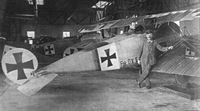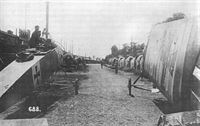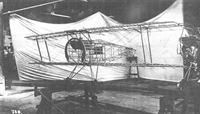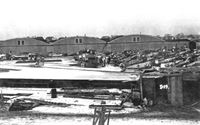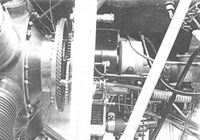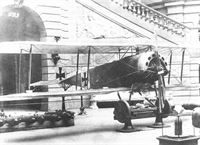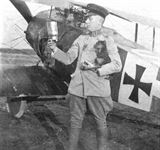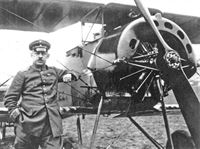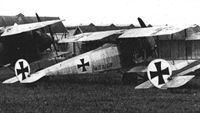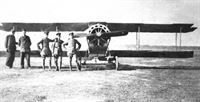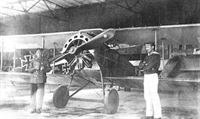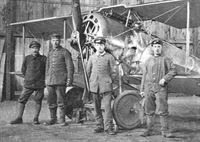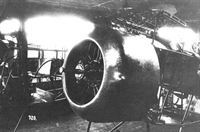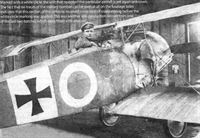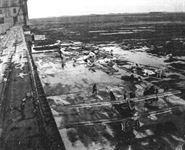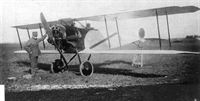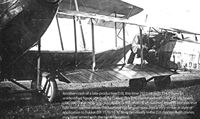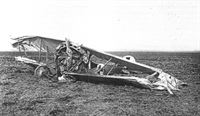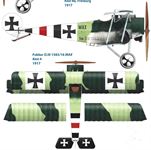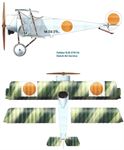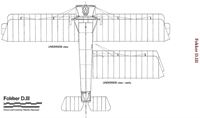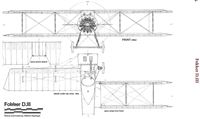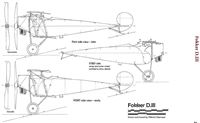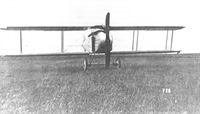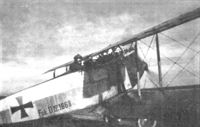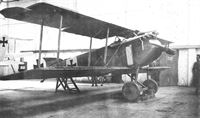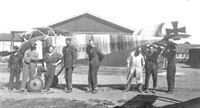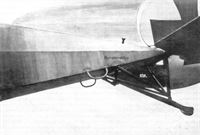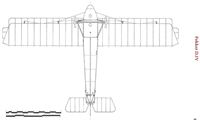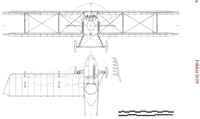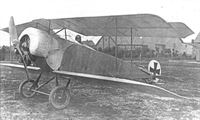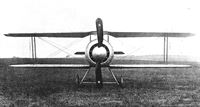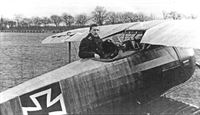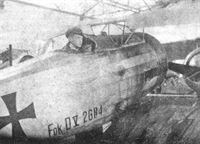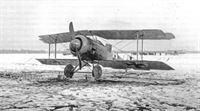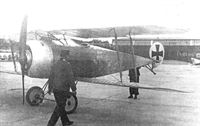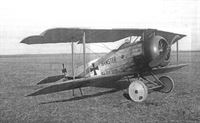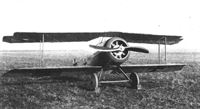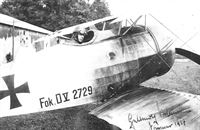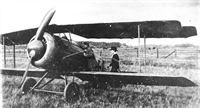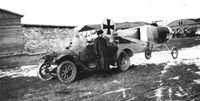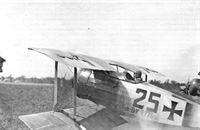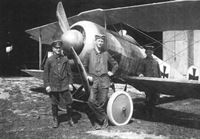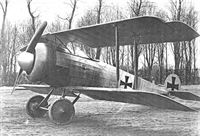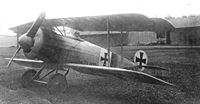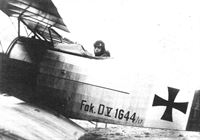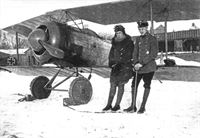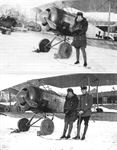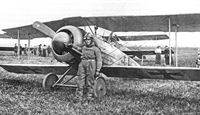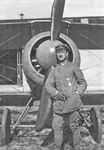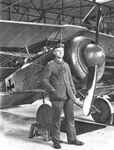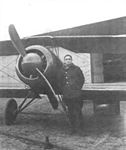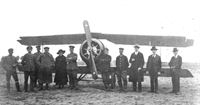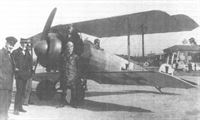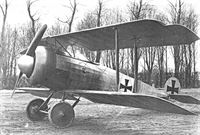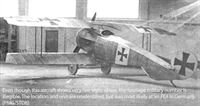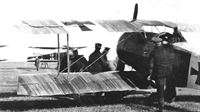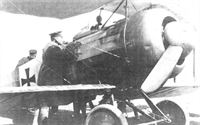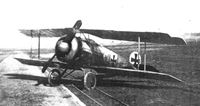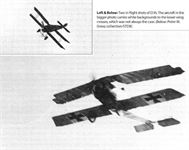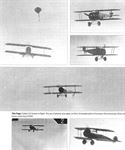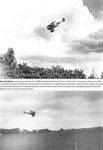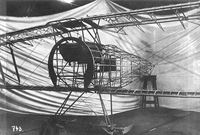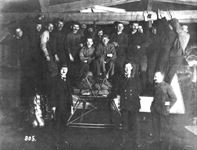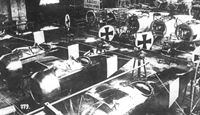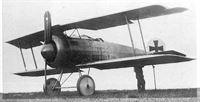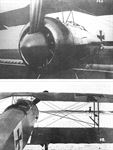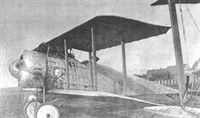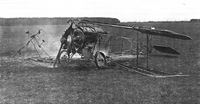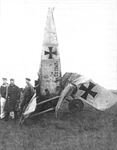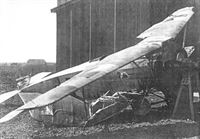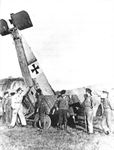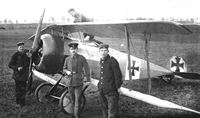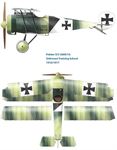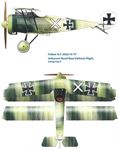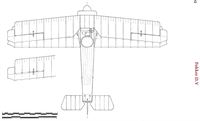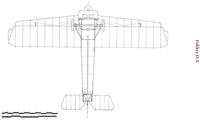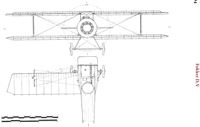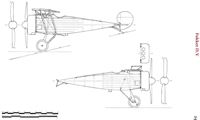Книги
Centennial Perspective
J.Herris, J.Leckscheid
Fokker Aircraft of WWI. Vol.3: Early Biplane Fighters
478
J.Herris, J.Leckscheid - Fokker Aircraft of WWI. Vol.3: Early Biplane Fighters /Centennial Perspective/ (53)
An Ago C.I seen in the background of this photo invites suggestion that the two aircraft in the photo may have served with Feld-Flieger Abteilung 9b in Colmar, a unit which is known to have operated both types. This unit became Jasta 16b in October 1916. The upper surfaces of the wings, horizontal tailplane, and the fuselage decking of Fokker D.II 540/16 (w/n 832) are painted in the new two-color factory-applied camouflage scheme. This may have been the first D.II to receive this new style of camouflage at Schwerin.
The nose of Fokker D.III 352/16 seen at the airfield at Velu in early September 1916. Parked next to it is Albatros D.I 385/16, which was the first aircraft of its type to reach Jasta 2.
Lineup of three late-production Jasta 14 D.Is at Buhl, featuring a metal cover in front of the forward cylinder. No doubt this modification was added as the colder season approached. A detail of considerable interest is the fact that no trace of the fuselage military number can be seen on the fully-visible D.I. At least a part of it should be visible next to the right arm of the mechanic. This strongly suggest that the fuselage of this aircraft was overpainted, possibly in light blue. A fourth D.I can be seen at right, also lacking the military number, and mostly hidden by an Albatros D.II. This type offered considerably better overall performance compared to the Fokker, and Jasta 14 converted to the Albatros as deliveries allowed during November and December 1916.
Ernst Udet standing next to his D.III 368/16. He had a metal facsimile of an observer's head and shoulders attached to its rear upper fuselage "in order to deceive the enemy'' - that is, to fool them into thinking he was flying a two-seater. Besides his unusual modification, this was one of the earliest D.IIIs to feature the factory-applied horizontal fuselage stringer. A newly-arrived Albatros D.II can be seen in the left background.
The equipment of Kest 4b was progressively upgraded, and by 1 June 1917, the first Roland D.II arrived. Six of these aircraft replaced the oldest fighters and took center stage here, and when this photo was taken around July or August, only three Fokker D.III remained with the unit. Seen from right to left are: Fokker D.III 1583/16 Max, 1593/16, and 1638/16. The "Iron Cross" wheel cover marking was not carried over to the Roland and Albatros fighters. Three Albatros D.III complete the distant end of the lineup, which shows the opposite direction of the airfield at Freiburg. By 1 September, the last of the Fokker single-seaters had been given up by the unit.
Group photo of pilots of Jasta 15 at Habsheim airfield, already covered with small patches of snow, in November 1916. An E.III and two D.IIs serve as the backdrop.
The motley collection of Jasta 16 at Ensisheim, possibly in November 1916. Seen in the foreground from left are: A D.II, an E.IV, three D.IIs, and an E.III. The two Fokker D.IIs at left already carry the "face" markings seen on some aircraft of the unit.
Rare Line-up of eleven Fokker D.II, two Fokker E.III and one E.IV of KEK Habsheim at their airfield, circa September 1916. One of the hangars still carries the "Aviatik" name, the company operated a flying school at Habsheim before it was moved to Leipzig earlier in the year due to its proximity to the front. KEK Habsheim formed the nucleus of Jasta 15 when the Staffel was formed in October.
Several Fokker E-Types share a hangar with a single D.V from the first production batch. The numbers applied to the monoplanes and the hangar suggest these aircraft served with an FEA in Germany. (Peter M. Grosz collection/STDB)
A wild mix of Fokker single-seaters is ready to be shipped to the front in mid-August. Photographed behind the Fokker factory at Hintenhof 43 in Schwerin, seen at left in this view area Fokker E.II followed by one D.I and seven Fokker D.II fighters. An engineless E.III, returned to the factory from the front, completes the lineup at left. Note the bright appearance of the D.I and D.II fabric compared to the E.III wing fabric. Seen at right are two D.Is (the second one an LF- marked Naval aircraft), a D.II, another D.I and an E.IV. This is Fokker E.IV 641/15 minus wings. A better view of this plane is available in the next photo.
The same group of aircraft photographed from the other end of the road. Fokker E.IV 641/15, seen at left, was shipped from Schwerin to the front for a second time on 18 August 1916, after being refurbished at the Fokker factory. The battered, engineless E.III is seen at right, note the worn appearance of the upper wing cross. The E.IV and several of the D.Is in these two photos still await their wings to be stacked next to their fuselages for transport.
Likely the same aircraft photographed at Schwerin in early May along with a Fokker E.III and an M.18 test aircraft, apparently mounting a swept upper wing. This M.17 now featured the comma-shaped rudder and the wider rear fuselage section, which was essentially a reversal to the Fokker E-Type configuration. The military number of this aircraft may have been 607.
Four Fokker M.18 welded steel-frame fuselage structures can be seen in the left foreground of this picture, followed by three E-type fuselage frames. Behind that, another three M.18 fuselage frames await the horizontal engine mounting steel-tube to be welded into position. Note the method of stacking completed E-type wings against the wall in the left background of the photo. (Peter M. Grosz/STDB)
Taxpayers' money wasted. The central staging area of the Schwerin-Gorries airfield became something of a morgue for disused Fokker airframes. The fuselages of around 40 Fokker Eindeckers E.III and E.IV and early D-Types are piled up to await disposition in the winter of 1916/17. All engines have been removed. Whenever possible, these were returned to their respective manufacturers or overhaul facilites in order to enjoy a second life in another airframe. Several D.I and D.II aircraft, identified by the upper wing center sections welded to the fuselages, can be seen. Dead center is E.III 222/16.
The same group of aircraft photographed from the other end of the road. Fokker E.IV 641/15, seen at left, was shipped from Schwerin to the front for a second time on 18 August 1916, after being refurbished at the Fokker factory. The battered, engineless E.III is seen at right, note the worn appearance of the upper wing cross. The E.IV and several of the D.Is in these two photos still await their wings to be stacked next to their fuselages for transport.
A wild mix of Fokker single-seaters is ready to be shipped to the front in mid-August. Photographed behind the Fokker factory at Hintenhof 43 in Schwerin, seen at left in this view area Fokker E.II followed by one D.I and seven Fokker D.II fighters. An engineless E.III, returned to the factory from the front, completes the lineup at left. Note the bright appearance of the D.I and D.II fabric compared to the E.III wing fabric. Seen at right are two D.Is (the second one an LF- marked Naval aircraft), a D.II, another D.I and an E.IV. This is Fokker E.IV 641/15 minus wings. A better view of this plane is available in the next photo.
That contemporary captions can't always be trusted is proven by these photos. The removed cowling of this Fokker D.II allows a closer look at its 100 hp Oberursel U.I engine, 'Fokker D.D.' translates as "Fokker Biplane". Oddly, it was the Fokker monoplane (E.IV) seen in the background of the photos that was powered by the 160 hp Oberursel U.III instead. The unit and location are unidentified. This D.II was painted in a three-color camouflage scheme.
Naval Fokker D.I LF219 shows off its factory-applied camouflage pattern. This was only applied to the upper surfaces on a number of D.Is, and consisted of one color that is rendered as very light, while the other one appears fairly darken orthochromatic film. Note that the upper wing cross is applied onto a white square background, while the fuselage and rudder crosses are applied directly onto the plain doped fabric. Compare the fuselage crosses applied onto the plain linen fuselage and rudder of the D.I to the white cross background in used on the Fokker E.IV in the background.
Rare Line-up of eleven Fokker D.II, two Fokker E.III and one E.IV of KEK Habsheim at their airfield, circa September 1916. One of the hangars still carries the "Aviatik" name, the company operated a flying school at Habsheim before it was moved to Leipzig earlier in the year due to its proximity to the front. KEK Habsheim formed the nucleus of Jasta 15 when the Staffel was formed in October.
The motley collection of Jasta 16 at Ensisheim, possibly in November 1916. Seen in the foreground from left are: A D.II, an E.IV, three D.IIs, and an E.III. The two Fokker D.IIs at left already carry the "face" markings seen on some aircraft of the unit.
When Kampfeinsitzerstaffel (Kest) 4b was formed by dividing Kest 4 into "a" and "b" designated half-units, they moved from Boblingen to Freiburg im Breisgau on 15 April 1917. This group photograph is thought to have been taken to commemorate their arrival at Freiburg, on or soon after this date. Their initial complement of fighters consisted of a somewhat motley collection of types: a Fokker E.IV named Hannah can be seen at far left, the only remaining Eindecker in the unit. The other aircraft seen in the picture are four Fokker D.III, three D.II, and a single Halberstadt, completing the rear trio of aircraft. Note the "Iron Cross" marked wheel hubs, which were possibly the new unit marking for Kest 4b.
Sixteen Fokker D.I fuselages can be seen under manufacture side by side in this view, the one at the far end has already received its fabric cover. A single completed Fokker E.IV fuselage positioned near the gate faces the camera, and seven seemingly completed E.IV fuselages are positioned in the left half of the assembly hall.
Taxpayers' money wasted. The central staging area of the Schwerin-Gorries airfield became something of a morgue for disused Fokker airframes. The fuselages of around 40 Fokker Eindeckers E.III and E.IV and early D-Types are piled up to await disposition in the winter of 1916/17. All engines have been removed. Whenever possible, these were returned to their respective manufacturers or overhaul facilites in order to enjoy a second life in another airframe. Several D.I and D.II aircraft, identified by the upper wing center sections welded to the fuselages, can be seen. Dead center is E.III 222/16.
Fokker M.16
A first indication of the existence of a new Fokker combat biplane can be glimpsed from a patent Fokker filed for dated 29 October 1915. From this we can deduce that Fokker had realized earlier than is generally acknowledged that the mid-wing monoplane design had its limitations, and that the biplane design was at least an alternative worth of further investigation.
Fokker's M.16 prototype was an obvious departure from his previous design practice. First, it was a two-seat biplane fighter; Fokker's previous fighter designs were single-seat monoplanes. At the time of its appearance it was not yet quite clear if single-seat or two-seat aircraft would bear the brunt of aerial combat in the near future.
Next, the first prototype (likely works number 418), was powered by a newly-available 160 hp Mercedes D.III water-cooled engine with side radiators. The Austro-Hungarian aviation authorities had noticed the appearance of the new type as early as November 1915, by the middle of the month they reported that Fokker had a high-speed aircraft powered by the 160 Mercedes (D.III) engine under construction. This could also be powered by the Austro-Daimler of similar design and power output. On 10. December it was reported that the Mercedes-engined prototype had already been tested with good results, which indicates that the first trials had already begun in late November. At the time, the Austrian authorities complained that modern and fast aircraft could only be obtained from Hansa-Brandenburg and Fokker. Domestic designs did not offer good performance.
As a consequence, the Austro-Hungarian Luftfahrtruppe (LFT) ordered a second prototype of the M.16 on 24. December 1915, and it was powered by a 160 hp Austro-Daimler water-cooled engine. By comparison, the earlier Eindecker fighters, which were then in full series production, were all rotary-powered monoplanes.
The M.16 design was based on the Walfisch configuration, which had already shown promise in the shape of the new Roland C.II, with the wings attached to the upper and lower fuselage longerons and the fuselage filling the entire gap between the wings. Designed to minimize drag, the Walfisch design principle brought about the disadvantage of a limited downward field of view for the aircrew, and of numerous Walfisch designs, only the Roland C.II was generally successful.
The first M.16 was said to have originally had single-bay wings. No photograph showing the aircraft in this configuration is available to the authors, and in the light of the following Fokker designs it comes as no surprise that this was very soon replaced by a 2-bay wing.
The M.16 was evaluated up until around March 1916, and did not find favor with Idflieg in Germany. The reasons for this are not difficult to imagine. The aforementioned Roland C.II had already been ordered in quantity in October and was serving in considerable numbers by the time the evaluation of the M.16 ended. The Roland was considerably faster, and the M.16 offered no improved performance over it in any other respect. The fact that it looked far less streamlined than the C.II may also have played a part in reaching the final verdict. Both aircraft were powered by the same engine, which was in short supply, so the choice in which airframe the precious engines could be put to better use was obvious.
The 160 hp Austro-Daimler engine for the second Fokker M.16 (w/n 435) was already dispatched to the Fokker factory in Schwerin on 24 December, 1915 when Fokker received the order for one M.16 prototype from the Austro-Hungarian Luftfahrtruppe. This order was marked as being "very urgent", and it included a provisional contract for 16 additional production aircraft, provided the flight trials had a positive outcome.
Since the flight trials of M.16/II, as it was sometimes referred to in Fokker records, took longer to complete than expected, the aforementioned order was changed to 16 aircraft of the M.17E (single bay) type, which was designated B.II series 30.60 under Austro-Hungarian nomenclature.
Simultaneously with the evaluation of M.16/II at Schwerin, the Austro-Hungarian Aviatik company was instructed to built a prototype (30.06) along the lines of the M.16/II, in preparation for possible series manufacture at Aviatik, for which the designation series 36 had already been reserved.
Ingenieur Alfred Gassner and his design team began work on their adaptation of the Fokker design in January 1916. Modifications included a wooden fuselage replacing the welded steel-tube Fokker design, no doubt in order to adjust the type to Aviatik manufacturing procedures. Wings and control surfaces also received design adjustments, and soon after flight test began in April 1916, it became obvious that these changes hampered performance. New wings and tail surfaces were quickly fitted, but 30.06 crashed during trials of these on 7 May 1916, with the pilot being killed and the observer surviving with injury.
Flars decided not to invest any further resources into the type, cancelled the order for series 36, and Ingenieur Gassner's employment at Aviatik came to an abrupt end.
In the meantime, after designer Martin Kreutzer had demonstrated the aircraft for the Austrians, the M.16/II successfully completed trials at Schwerin and was eventually shipped to Aspern on 13 April 1916 for trials. However, the evaluation of 03.91, as it was now numbered, was terminated after the crash of Aviatik 30.06. on 7 May 1916. The aircraft was then assigned as a trainer to Flek 6 in Wiener-Neustadt until written off in April 1918.
Venturing into the two-seater market had proven unsuccessful for Fokker, and his following prototypes would put the focus back on his core business, the design of single-seat fighter aircraft.
Fokker M.18 & D.I
The first Fokker M.18E fighter prototype (w/n 434) was the water-cooled fighter variant in Fokker's strategy of exploring designs differing in critical details. Like the M.17E, the M.18E had a single bay wing of bracing, wing-warping, and a single synchronized machine gun. However, power was provided by a 100 hp Mercedes six-cylinder inline engine, cooled by side-mounted radiators.
Also like the M.17E, the M.18E was a boxy design with the fuselage deep enough that the upper and lower wings were attached directly to the upper and lower fuselage longerons. Lacking an open cabane structure, both aircraft suffered from inadequate field of view for the pilot. Downward visibility for the pilot was severely impaired by this design, it made both spotting an enemy in the air and landing more difficult.
The Walfisch (whale) fuselage design turned out to be a failure on single-seaters and Fokker abandoned by March. It was successful on the Roland C.II but not on many other types and new prototypes of the M.17 (w/n 499) and M.18 (w/n 501) were built. These featured a fuselage design that was obviously inspired by the Fokker Eindecker and these were built with an open cabane structure that greatly improved the field of view for the pilot.
These revised prototypes were tested with one-bay and two-bay wings and wings with ailerons and wing warping. Two-bay wings with wing-warping were eventually chosen for both the production D.I and D.II fighters. No documentation showing the reasons for making this choice has survived, but since the previous Fokker types had employed wing-warping this seems to have been an obvious option for the designers. Otherwise, it may also indicate that Fokker's new aileron design still required further refinement.
Testing of the new M.17 and M. 18 was already well underway at Schwerin in March 1916. By the end of the month, this duo was joined by the M.19 (the Fokker D.III prototype), just when Oswald Boelcke visited the Fokker factory. He would spend several days in Schwerin for lengthy discussions with Fokker and his design team, and also conducted several test flights on the new prototypes. A test of the Fokker machine gun synchronizing mechanism, adapted for use on the six-cylinder inline Mercedes engine in the M.18 prototype, was also conducted in his presence.
On April 15, 1916, the Albatros D.I, Fokker M.17, and two Fokker M.18 fighter prototypes were demonstrated at the test center at Adlershof. One of the M.18 prototypes was fitted with wing warping and the other with ailerons. The verdict was that the Albatros D.I made a much better overall impression despite Fokker's extensive experience building Eindecker fighters.
With the Eindecker fighters hard pressed by Allied fighters at the front, Idflieg submitted a letter of intent over the planned purchase of 80 D.I fighters based on the M.18 to Fokker. This can be interpreted as an expression of the trust that Fokker had gained with Idflieg officials, thanks to the success of his Eindecker fighters.
The D.I production aircraft were to be powered by the 120 hp Mercedes D.II engine and fitted with a single synchronized machine gun. It was the largest single-seat fighter production contract awarded to any German manufacturer to that time. A war ministry contract confirmed the order in May 1916, by which time construction of the D.I fighters was already well underway at the Fokker factory. Much has been made of the fact that this was the largest single-seat fighter production contract awarded to any German manufacturer so far. In reality, it basically shows that the true role of fighter aircraft had previously not been fully appreciated. Bigger orders would soon follow; Albatros received an order for 100 D.II fighters in August, and orders for 200 to 400 fighters soon became common. A final small batch of 10 Fokker D.I fighters was ordered in October 1916, possibly to make use of available Mercedes D.II engines.
Flight tests conducted with D.140/16, the first production aircraft, showed that the small 'button'-shaped, all-moving rudder that was installed offered inadequate directional control and a tail fin was built and tested on D.140/16. This problem must have arisen before on the first Fokker M.18E fighter prototype (w/n 434), which already received a similar modification in February. As far as can be determined, almost all production D.Is were delivered having this tail fin fitted.
On 30 May, Fokker D.I 143/16 reached Adlershof, where it was subjected to the mandatory load tests. Only minor structural improvements were demanded, and the type was cleared for front line use on 6 June 1916, surprisingly quickly. Remarkably, due to their structural similarity, the D.II and D.III were also cleared for service simultaneously.
On 27 June, just as the first examples of Fokker's first biplane fighters were being completed, a highly tragic accident, which foreshadowed future events, occurred. Fokker designer Martin Kreutzer took an early Fokker D.I up on a test flight, which ended in a crash. He succumbed to his injuries soon after and died just 15 days short of his 25th birthday.
Acceptances of the first examples had commenced in the second half of June, and the first two aircraft (140/16 fitted with wing-warping and 141/16 fitted with ailerons) were shipped to Adlershof for evaluation on 12 and 13 July. The former variant was chosen for production, and by the end of August 1916 the frontline inventory listed 10 Fokker D.I fighters. Two months later, this figure had risen to 74, which indicates that virtually all aircraft of the main production batch had reached the front by then. This also made it the most numerous German fighter in the D-type category on this date.
Photographs indicate that several examples of the type had been delivered to Jasta 1 as the initial equipment of the unit.
Jagdstaffel 2 received two Fokker biplane fighters as original equipment, and one of these was Fokker D.I 185/16, which reached the unit on 1 September, together with Fokker D.III 352/16.
Certainly other units also received the type, but the Fokker D.I enjoyed a fairly uneventful frontline career. Photographic coverage of the aircraft in service with the newly created Jagdstaffeln is remarkably sparse. In terms of overall performance, this was fairly similar to Halberstadt fighters powered by the same engine, which reached the front just a bit before the Fokker D.I did. But the Halberstadt had much better handling qualities and were much more robust, qualities which were much appreciated by Jasta pilots. Eventually, the products of both these companies were completely overshadowed by the Albatros D-types as they became available in ever increasing numbers.
Virtually no reports concerning combat use of the D.I are available, and the two best known official reports mentioning the D.I shed an unfavorable light on it.
On 30 August 1916, a Fokker D.I flown by Vzfw. Hans Miesegades of Jasta 3 lost its wings during a test flight. This may not have caused immediate concern with the higher authorities, since Jasta 3 was in the closing stages of unit formation, and determining the reason for this incident might have taken some time. However, a similar accident occurred a little over two months later. While on patrol on 4 December 1916, the wings of Fokker D.I 175/16 collapsed and the pilot, Vzfw. Karl Ehrnthaller of Jasta 1, was killed. Failure of a wing attachment bolt was determined to be the cause. As the result of these failures in addition to five recent Eindecker crashes, on 6 December Kogenluft
decreed: "Fokker aircraft primarily because of increasingly deficient factory workmanship are not permitted to be flown at the Front. As far as aircraft that have been ordered are concerned, the flight schools will be equipped with them."
The frontline service of the D.I and its siblings on the western front came to an abrupt end, but some D.Is later served on the Russian front, and in November 1917 eight aircraft of the type were shipped to Turkey. Unsurprisingly, no information concerning their use by the Ottoman air service is available.
Fokker M.16Z Specifications
Engine: 160 hp Mercedes / Austro-Daimler
Wing: Span 11.60 m
Chord (Upper/Lower) 1.70 m
Gap 1.40 m
Wing Area 32.0 m2
General: Length 7.65 m
Height 2.85 m
Track 2.0 m
Empty Weight 620 kg
Loaded Weight 1,056 kg
Maximum Speed: 155 km/h
Climb: 1000m 5 min
2000m 13 min
3000m 26 min
Fokker Early D-Type Specifications
Fokker D.I D.II D.III D.IV D.V
Fokker Type M.18 M.17 M.19 M.21 M.22
Engine 120 hp Mercedes D.II 100 hp Oberursel U.I 160 hp Oberursel U.III 160 hp Mercedes D.III 100 hp Oberursel U.I
Wing Span, m 9.05 8.75 9.05 9.7 8.75
Wing Chord, m 1.25 1.15 1.25 1.25 1.16
Wing Gap, m 1.34 - 1.35 1.32 1.20
Wing Area, m2 22 18 21.6 22.5 15.55
Length, m 5.7 6.4 6.3 6.3 6.05
Height, m 2.25 2.55 2.25 2.45 2.30
Empty Weight, kg 463 384 452 606 363
Loaded Weight, kg 671 576 710 841 566
Max Speed, km/h 150 150 160 160 160-170
Climb to: 1,000 m 4 4 3 3 3
2,000 m 9 8 7 - 8
3,000 m 15 15 12 12 16
4,000 m 23 24 20 30 24
Roll Control Wing-warp Wing-warp Wing-warp, then ailerons Ailerons Ailerons
Armament 1xLMG 08/15 1xLMG 08/15 2xLMG 08/15 2xLMG 08/15 1xLMG 08/15
Note: Climb times in minutes.
Fokker Early D-Type Identification Attributes
Type Engine Notes Qty Built
D.I 120 hp Mercedes D.II Wing warping, 2-bay, 1-gun 90
D.II 100 hp Oberursel U.I (9 cyl) Wing warping, 2-bay, 1-gun 181
D.III 160 hp Oberursel U.III (14 cyl) Wing warping (ailerons on later), 2-bay, 1-2 guns 210
D.IV 160 hp Mercedes D.III Ailerons with horn balances, 2-bay, 2 guns 44
D.V 100 hp Oberursel U.I (9 cyl) Ailerons with horn balances, 1-bay, 1 gun 300
Fokker Early D-Type Production
Type Order Date Qty Serials
D.I May 1916 80 D.140-219/16
D.I Oct. 1916 10 D.1900-1909/16
A first indication of the existence of a new Fokker combat biplane can be glimpsed from a patent Fokker filed for dated 29 October 1915. From this we can deduce that Fokker had realized earlier than is generally acknowledged that the mid-wing monoplane design had its limitations, and that the biplane design was at least an alternative worth of further investigation.
Fokker's M.16 prototype was an obvious departure from his previous design practice. First, it was a two-seat biplane fighter; Fokker's previous fighter designs were single-seat monoplanes. At the time of its appearance it was not yet quite clear if single-seat or two-seat aircraft would bear the brunt of aerial combat in the near future.
Next, the first prototype (likely works number 418), was powered by a newly-available 160 hp Mercedes D.III water-cooled engine with side radiators. The Austro-Hungarian aviation authorities had noticed the appearance of the new type as early as November 1915, by the middle of the month they reported that Fokker had a high-speed aircraft powered by the 160 Mercedes (D.III) engine under construction. This could also be powered by the Austro-Daimler of similar design and power output. On 10. December it was reported that the Mercedes-engined prototype had already been tested with good results, which indicates that the first trials had already begun in late November. At the time, the Austrian authorities complained that modern and fast aircraft could only be obtained from Hansa-Brandenburg and Fokker. Domestic designs did not offer good performance.
As a consequence, the Austro-Hungarian Luftfahrtruppe (LFT) ordered a second prototype of the M.16 on 24. December 1915, and it was powered by a 160 hp Austro-Daimler water-cooled engine. By comparison, the earlier Eindecker fighters, which were then in full series production, were all rotary-powered monoplanes.
The M.16 design was based on the Walfisch configuration, which had already shown promise in the shape of the new Roland C.II, with the wings attached to the upper and lower fuselage longerons and the fuselage filling the entire gap between the wings. Designed to minimize drag, the Walfisch design principle brought about the disadvantage of a limited downward field of view for the aircrew, and of numerous Walfisch designs, only the Roland C.II was generally successful.
The first M.16 was said to have originally had single-bay wings. No photograph showing the aircraft in this configuration is available to the authors, and in the light of the following Fokker designs it comes as no surprise that this was very soon replaced by a 2-bay wing.
The M.16 was evaluated up until around March 1916, and did not find favor with Idflieg in Germany. The reasons for this are not difficult to imagine. The aforementioned Roland C.II had already been ordered in quantity in October and was serving in considerable numbers by the time the evaluation of the M.16 ended. The Roland was considerably faster, and the M.16 offered no improved performance over it in any other respect. The fact that it looked far less streamlined than the C.II may also have played a part in reaching the final verdict. Both aircraft were powered by the same engine, which was in short supply, so the choice in which airframe the precious engines could be put to better use was obvious.
The 160 hp Austro-Daimler engine for the second Fokker M.16 (w/n 435) was already dispatched to the Fokker factory in Schwerin on 24 December, 1915 when Fokker received the order for one M.16 prototype from the Austro-Hungarian Luftfahrtruppe. This order was marked as being "very urgent", and it included a provisional contract for 16 additional production aircraft, provided the flight trials had a positive outcome.
Since the flight trials of M.16/II, as it was sometimes referred to in Fokker records, took longer to complete than expected, the aforementioned order was changed to 16 aircraft of the M.17E (single bay) type, which was designated B.II series 30.60 under Austro-Hungarian nomenclature.
Simultaneously with the evaluation of M.16/II at Schwerin, the Austro-Hungarian Aviatik company was instructed to built a prototype (30.06) along the lines of the M.16/II, in preparation for possible series manufacture at Aviatik, for which the designation series 36 had already been reserved.
Ingenieur Alfred Gassner and his design team began work on their adaptation of the Fokker design in January 1916. Modifications included a wooden fuselage replacing the welded steel-tube Fokker design, no doubt in order to adjust the type to Aviatik manufacturing procedures. Wings and control surfaces also received design adjustments, and soon after flight test began in April 1916, it became obvious that these changes hampered performance. New wings and tail surfaces were quickly fitted, but 30.06 crashed during trials of these on 7 May 1916, with the pilot being killed and the observer surviving with injury.
Flars decided not to invest any further resources into the type, cancelled the order for series 36, and Ingenieur Gassner's employment at Aviatik came to an abrupt end.
In the meantime, after designer Martin Kreutzer had demonstrated the aircraft for the Austrians, the M.16/II successfully completed trials at Schwerin and was eventually shipped to Aspern on 13 April 1916 for trials. However, the evaluation of 03.91, as it was now numbered, was terminated after the crash of Aviatik 30.06. on 7 May 1916. The aircraft was then assigned as a trainer to Flek 6 in Wiener-Neustadt until written off in April 1918.
Venturing into the two-seater market had proven unsuccessful for Fokker, and his following prototypes would put the focus back on his core business, the design of single-seat fighter aircraft.
Fokker M.18 & D.I
The first Fokker M.18E fighter prototype (w/n 434) was the water-cooled fighter variant in Fokker's strategy of exploring designs differing in critical details. Like the M.17E, the M.18E had a single bay wing of bracing, wing-warping, and a single synchronized machine gun. However, power was provided by a 100 hp Mercedes six-cylinder inline engine, cooled by side-mounted radiators.
Also like the M.17E, the M.18E was a boxy design with the fuselage deep enough that the upper and lower wings were attached directly to the upper and lower fuselage longerons. Lacking an open cabane structure, both aircraft suffered from inadequate field of view for the pilot. Downward visibility for the pilot was severely impaired by this design, it made both spotting an enemy in the air and landing more difficult.
The Walfisch (whale) fuselage design turned out to be a failure on single-seaters and Fokker abandoned by March. It was successful on the Roland C.II but not on many other types and new prototypes of the M.17 (w/n 499) and M.18 (w/n 501) were built. These featured a fuselage design that was obviously inspired by the Fokker Eindecker and these were built with an open cabane structure that greatly improved the field of view for the pilot.
These revised prototypes were tested with one-bay and two-bay wings and wings with ailerons and wing warping. Two-bay wings with wing-warping were eventually chosen for both the production D.I and D.II fighters. No documentation showing the reasons for making this choice has survived, but since the previous Fokker types had employed wing-warping this seems to have been an obvious option for the designers. Otherwise, it may also indicate that Fokker's new aileron design still required further refinement.
Testing of the new M.17 and M. 18 was already well underway at Schwerin in March 1916. By the end of the month, this duo was joined by the M.19 (the Fokker D.III prototype), just when Oswald Boelcke visited the Fokker factory. He would spend several days in Schwerin for lengthy discussions with Fokker and his design team, and also conducted several test flights on the new prototypes. A test of the Fokker machine gun synchronizing mechanism, adapted for use on the six-cylinder inline Mercedes engine in the M.18 prototype, was also conducted in his presence.
On April 15, 1916, the Albatros D.I, Fokker M.17, and two Fokker M.18 fighter prototypes were demonstrated at the test center at Adlershof. One of the M.18 prototypes was fitted with wing warping and the other with ailerons. The verdict was that the Albatros D.I made a much better overall impression despite Fokker's extensive experience building Eindecker fighters.
With the Eindecker fighters hard pressed by Allied fighters at the front, Idflieg submitted a letter of intent over the planned purchase of 80 D.I fighters based on the M.18 to Fokker. This can be interpreted as an expression of the trust that Fokker had gained with Idflieg officials, thanks to the success of his Eindecker fighters.
The D.I production aircraft were to be powered by the 120 hp Mercedes D.II engine and fitted with a single synchronized machine gun. It was the largest single-seat fighter production contract awarded to any German manufacturer to that time. A war ministry contract confirmed the order in May 1916, by which time construction of the D.I fighters was already well underway at the Fokker factory. Much has been made of the fact that this was the largest single-seat fighter production contract awarded to any German manufacturer so far. In reality, it basically shows that the true role of fighter aircraft had previously not been fully appreciated. Bigger orders would soon follow; Albatros received an order for 100 D.II fighters in August, and orders for 200 to 400 fighters soon became common. A final small batch of 10 Fokker D.I fighters was ordered in October 1916, possibly to make use of available Mercedes D.II engines.
Flight tests conducted with D.140/16, the first production aircraft, showed that the small 'button'-shaped, all-moving rudder that was installed offered inadequate directional control and a tail fin was built and tested on D.140/16. This problem must have arisen before on the first Fokker M.18E fighter prototype (w/n 434), which already received a similar modification in February. As far as can be determined, almost all production D.Is were delivered having this tail fin fitted.
On 30 May, Fokker D.I 143/16 reached Adlershof, where it was subjected to the mandatory load tests. Only minor structural improvements were demanded, and the type was cleared for front line use on 6 June 1916, surprisingly quickly. Remarkably, due to their structural similarity, the D.II and D.III were also cleared for service simultaneously.
On 27 June, just as the first examples of Fokker's first biplane fighters were being completed, a highly tragic accident, which foreshadowed future events, occurred. Fokker designer Martin Kreutzer took an early Fokker D.I up on a test flight, which ended in a crash. He succumbed to his injuries soon after and died just 15 days short of his 25th birthday.
Acceptances of the first examples had commenced in the second half of June, and the first two aircraft (140/16 fitted with wing-warping and 141/16 fitted with ailerons) were shipped to Adlershof for evaluation on 12 and 13 July. The former variant was chosen for production, and by the end of August 1916 the frontline inventory listed 10 Fokker D.I fighters. Two months later, this figure had risen to 74, which indicates that virtually all aircraft of the main production batch had reached the front by then. This also made it the most numerous German fighter in the D-type category on this date.
Photographs indicate that several examples of the type had been delivered to Jasta 1 as the initial equipment of the unit.
Jagdstaffel 2 received two Fokker biplane fighters as original equipment, and one of these was Fokker D.I 185/16, which reached the unit on 1 September, together with Fokker D.III 352/16.
Certainly other units also received the type, but the Fokker D.I enjoyed a fairly uneventful frontline career. Photographic coverage of the aircraft in service with the newly created Jagdstaffeln is remarkably sparse. In terms of overall performance, this was fairly similar to Halberstadt fighters powered by the same engine, which reached the front just a bit before the Fokker D.I did. But the Halberstadt had much better handling qualities and were much more robust, qualities which were much appreciated by Jasta pilots. Eventually, the products of both these companies were completely overshadowed by the Albatros D-types as they became available in ever increasing numbers.
Virtually no reports concerning combat use of the D.I are available, and the two best known official reports mentioning the D.I shed an unfavorable light on it.
On 30 August 1916, a Fokker D.I flown by Vzfw. Hans Miesegades of Jasta 3 lost its wings during a test flight. This may not have caused immediate concern with the higher authorities, since Jasta 3 was in the closing stages of unit formation, and determining the reason for this incident might have taken some time. However, a similar accident occurred a little over two months later. While on patrol on 4 December 1916, the wings of Fokker D.I 175/16 collapsed and the pilot, Vzfw. Karl Ehrnthaller of Jasta 1, was killed. Failure of a wing attachment bolt was determined to be the cause. As the result of these failures in addition to five recent Eindecker crashes, on 6 December Kogenluft
decreed: "Fokker aircraft primarily because of increasingly deficient factory workmanship are not permitted to be flown at the Front. As far as aircraft that have been ordered are concerned, the flight schools will be equipped with them."
The frontline service of the D.I and its siblings on the western front came to an abrupt end, but some D.Is later served on the Russian front, and in November 1917 eight aircraft of the type were shipped to Turkey. Unsurprisingly, no information concerning their use by the Ottoman air service is available.
Fokker M.16Z Specifications
Engine: 160 hp Mercedes / Austro-Daimler
Wing: Span 11.60 m
Chord (Upper/Lower) 1.70 m
Gap 1.40 m
Wing Area 32.0 m2
General: Length 7.65 m
Height 2.85 m
Track 2.0 m
Empty Weight 620 kg
Loaded Weight 1,056 kg
Maximum Speed: 155 km/h
Climb: 1000m 5 min
2000m 13 min
3000m 26 min
Fokker Early D-Type Specifications
Fokker D.I D.II D.III D.IV D.V
Fokker Type M.18 M.17 M.19 M.21 M.22
Engine 120 hp Mercedes D.II 100 hp Oberursel U.I 160 hp Oberursel U.III 160 hp Mercedes D.III 100 hp Oberursel U.I
Wing Span, m 9.05 8.75 9.05 9.7 8.75
Wing Chord, m 1.25 1.15 1.25 1.25 1.16
Wing Gap, m 1.34 - 1.35 1.32 1.20
Wing Area, m2 22 18 21.6 22.5 15.55
Length, m 5.7 6.4 6.3 6.3 6.05
Height, m 2.25 2.55 2.25 2.45 2.30
Empty Weight, kg 463 384 452 606 363
Loaded Weight, kg 671 576 710 841 566
Max Speed, km/h 150 150 160 160 160-170
Climb to: 1,000 m 4 4 3 3 3
2,000 m 9 8 7 - 8
3,000 m 15 15 12 12 16
4,000 m 23 24 20 30 24
Roll Control Wing-warp Wing-warp Wing-warp, then ailerons Ailerons Ailerons
Armament 1xLMG 08/15 1xLMG 08/15 2xLMG 08/15 2xLMG 08/15 1xLMG 08/15
Note: Climb times in minutes.
Fokker Early D-Type Identification Attributes
Type Engine Notes Qty Built
D.I 120 hp Mercedes D.II Wing warping, 2-bay, 1-gun 90
D.II 100 hp Oberursel U.I (9 cyl) Wing warping, 2-bay, 1-gun 181
D.III 160 hp Oberursel U.III (14 cyl) Wing warping (ailerons on later), 2-bay, 1-2 guns 210
D.IV 160 hp Mercedes D.III Ailerons with horn balances, 2-bay, 2 guns 44
D.V 100 hp Oberursel U.I (9 cyl) Ailerons with horn balances, 1-bay, 1 gun 300
Fokker Early D-Type Production
Type Order Date Qty Serials
D.I May 1916 80 D.140-219/16
D.I Oct. 1916 10 D.1900-1909/16
The first form of the M.16Z, with wing warping and a 160 hp Mercedes D III engine.
The M.16 (w/n 418) prototype is set up for photographic documentation at Schwerin, likely in December 1915 or January 1916. The engine cylinders are fully cowled, skids have been fitted to the lower wingtips to prevent damage in case of a slightly imperfect landing on snow-covered or frozen ground during the winter. The large side-mounted radiator shows well in these views, and the unusual application of the Iron Cross marked on a square background on the comma-shaped rudder is of interest. (Peter M. Grosz Collection/STDB)
The M.16 (w/n 418) prototype is set up for photographic documentation at Schwerin, likely in December 1915 or January 1916. The engine cylinders are fully cowled, skids have been fitted to the lower wingtips to prevent damage in case of a slightly imperfect landing on snow-covered or frozen ground during the winter. The large side-mounted radiator shows well in these views, and the unusual application of the Iron Cross marked on a square background on the comma-shaped rudder is of interest. (Peter M. Grosz Collection/STDB)
The M.16 (w/n 418) prototype is set up for photographic documentation at Schwerin, likely in December 1915 or January 1916. The engine cylinders are fully cowled, skids have been fitted to the lower wingtips to prevent damage in case of a slightly imperfect landing on snow-covered or frozen ground during the winter. The large side-mounted radiator shows well in these views, and the unusual application of the Iron Cross marked on a square background on the comma-shaped rudder is of interest. (Peter M. Grosz Collection/STDB)
Right-side view of the completed w/n 435 illustrates the engine exhaust. Also just barely visible is the works number 435 on the lower part of the rudder.
The Fokker M.16ZK built for Austria with the 185/200-h.p. Austro-Daimler engine.
The M16 in the definitive form in which it was evaluated by the Luftfahrttruppen of Austria-Hungary in the spring of 1916.
Still unarmed when this photo was taken, the works number 435 can be seen applied to the forward fuselage between the radiator and the forward landing gear strut. For the pilot, a full-chord cutout was designed into the upper wing. Entering the cockpit must have been somewhat awkward. No crash pylon was provided for, at least none is showing in any of the photos of the M.16 prototype duo. The aircraft was assigned military number 03.91 when it arrived in Austria.
The M16 in the definitive form in which it was evaluated by the Luftfahrttruppen of Austria-Hungary in the spring of 1916.
Still unarmed when this photo was taken, the works number 435 can be seen applied to the forward fuselage between the radiator and the forward landing gear strut. For the pilot, a full-chord cutout was designed into the upper wing. Entering the cockpit must have been somewhat awkward. No crash pylon was provided for, at least none is showing in any of the photos of the M.16 prototype duo. The aircraft was assigned military number 03.91 when it arrived in Austria.
Photographed at Schwerin-Gorries around February 1916, designer Martin Kreutzer takes position in the pilot seat, with Anthony Fokker in the rear seat. Both are wearing their flying outfits, as is Austro-Hungarian Oberleutnant Hans Mandl, who was accompanied by three Officers from the Fliegerarsenal (Flars) on this visit to Schwerin. The LFT designation for M.16/II was 03.91. (Peter M. Grosz Collection/STDB)
Nose view of the first M.16 illustrating the slab-sided engine covers. For transport, the wings are mounted to tubes extending from the lower fuselage. When assembling the aircraft, the lower wings would be mounted to these tubes. Note the large radiators well visible between fuselage and wings. The sign on the sliding door on the right reads "Rauchen Verboten - No Smoking".
The crankcase of the six-cylinder inline engine installed in the second M.16 prototype left visible oil stains on the bottom of the nose of the aircraft.
The Factory number (435) of the M.16ZK is visible in this photograph. This has led to the erroneous belief that the aircraft had the Austrian number 04.35.
The Factory number (435) of the M.16ZK is visible in this photograph. This has led to the erroneous belief that the aircraft had the Austrian number 04.35.
A unique view into the cockpit and rear seat shows noteworthy details, such as the machine gun mounted on the left side, cockpit instrumentation and the small and still unblemished windscreen. It also provides a rare view at the rear of the "ear" radiators. (Peter M. Grosz Collection/STDB)
The welded fuselage section of the first M.16 (supposedly w/n 418), with the Mercedes D.III 160 hp inline engine and both machine guns already fitted. For the photo, only the left-hand radiator has been fitted, allowing a look at the pilot seat and the fuel tank below it. For once, the gas bottles needed for the welding process show in the right side of the picture. (Peter M. Grosz Collection/STDB)
The three steel-tube stringers that gave w/n 435 a more streamlined nose were of considerably thinner diameter than the main structure tubes. These thin stringers were also provided for the bottom nose of the aircraft, resulting in a fairly complex welded steel-tube structure. The arrangement of components close to the propeller shaft are a part of the machine gun interrupter gear, which is mounted on the left side of the airframe on w/n 435. (Peter M. Grosz Collection/STDB)
The uncovered fuselage of w/n 435 at the Fokker experimental workshop, just after installation of the Austro-Daimler engine, which is still being held by chains from the ceiling. The fixed Schwarzlose MG-16 is already fitted. Compare these photos to the detail nose view. Other noteworthy details include the mounting of the fuel tank below the pilot seat, with the fuel tank filler neck exiting on the left side of the fuselage. The upper photo allows a look at the structure of the rhomboid-shaped rudder. (Peter M. Grosz Collection/STDB)
Fokker very much liked to employ his workforce or other human beings in weight tests to visualize the strength of his designs in the best possible way. Here 15 men of the workforce weight test the landing gear of M.17E (w/n 433) - note the flat tire! The fuselage of the Austro-Daimler M.16 (w/n 434) can be seen at right. (Peter M. Grosz Collection/STDB)
Complete line-up of the initial quartet of Fokker's new generation of biplane aircraft in early 1916. Seen from right to left are: M.16 w/n 435, M.16 w/n 418, M.18 w/n 434, and M.17 w/n 433.
The Fokker fighter prototypes; from left the M.16Z, M.18E, and M.17E.
The small Mercedes-powered M.18E (w/n 434) pictured at centre next to the even more diminutive first M.17E (w/n 433) at right. The fact that sequential works numbers were assigned to both prototypes proves that they were built alongside, as was the earlier-mentioned M.16 prototype w/n 435. The family resemblance of the single-seaters is plainly obvious in this view. (Peter M. Grosz Collection/STDB)
The small Mercedes-powered M.18E (w/n 434) pictured at centre next to the even more diminutive first M.17E (w/n 433) at right. The fact that sequential works numbers were assigned to both prototypes proves that they were built alongside, as was the earlier-mentioned M.16 prototype w/n 435. The family resemblance of the single-seaters is plainly obvious in this view. (Peter M. Grosz Collection/STDB)
Engine and radiator of the M.18E. (M.16E ???) The nose panels were slab-sided with a rounded contour. In the next iteration they would be more fitted and rounded. The frame would also be modified for the new panels. (Peter M. Grosz Collection/STDB)
Fokker M.18E (M.16E ???) single-bay prototype. This M.18E prototype was also known as the Karausche or Carp.
The works number 501 can be seen at the bottom of the rhomboid-shaped rudder in this side view. Great care has been taken to rotate the propeller into the most aesthetic position in each of these three pictures. (Peter M. Grosz Collection/STDB)
The rearview of w/n 501 vividly illustrates the unique sharp-pointed tail of the aircraft. This design feature proved to be unsuccessful, and on later machines, the wider, knife-edged tail known from the earlier Fokker E-types was reintroduced.
Two port side views of the aircraft. Note that the works number 501 has also been applied to the lower forward fuselage, below the Windhoff radiator. At this time, no other markings besides the works number have yet been applied. (Above: Peter M. Grosz Collection/STDB)
Anthony Fokker poses with works number 501, which can be considered the first true prototype of the Fokker D.I at the airfield in Schwerin-Gorries in March 1916. At this point, the plane was unarmed, but the stains on the side of the fuselage indicate that it has already been flown. The thick side-mounted radiators were manufactured by the Windhoff Company, which also supplied the first side radiators for the early Albatros D.I and D.II fighters. The different tonality of the aircraft fabric in two different prints of photos taken within moments of each other vividly demonstrate the difficulty of interpreting orthochromatic photos. Note the small windscreen.
In late March/early April, celebrity visitors came to Schwerin to discuss the future development of biplane fighters with Fokker and his team. In the background, seen as second from the right, Oswald Boelcke, converses with Wilhelm Frankl. Fokker is standing on the right wheel of the M.18 prototype, while a mixed group of officials and pilots examine a plywood disc that has been fitted to the prop after firing test have been conducted. (Peter M. Grosz Collection/STDB)
By that time, the earlier Windhoff radiators have been replaced with larger radiators. Standing with the back to the camera, wearing a dark suit and light-colored hat, is Heinrich Lubbe, the weapons specialist at Fokker. He points out the effectiveness of the machine-gun synchronizing gear to Waldemar von Buttlar, an officer who earned his pilots license in 1912 and was now serving with the Idflieg technical examination board. Von Buttlar is holding a flying helmet and carries goggles on his cap, a clear indication that he flew the aircraft, or was about to fly it. Frankl seems to cast a somewhat skeptical look at the disc, while at the extreme right Fokker designer Martin Kreutzer is seen.
During their late March/early April visit, Frankl and Boelcke took the opportunity to evaluate the latest Fokker designs. These stills, taken from cine film taken during that visit, show Boelcke boarding an unidentified M.18 prototype. This aircraft was still powered by a 100 hp Mercedes D.I engine. Designer Martin Kreutzer is seen in three of these pictures.
Up & up! Aircraft w/n 501 is circling low over the airfield at Schwerin-Gorries, likely during one of its first test-flights in March 1916. The sharp-pointed tail shows pretty well in these views.
While spectators watch from the ground, the M.18 prototype is put into a low left-hand turn above the "Fokker" shed at the Schwerin-Gorries airfield. An E.III or E.IV, the last of the mid-wing monoplanes produced by Fokker, provides a symbolic contrast in the left bottom of the picture to the first Fokker biplane fighter that will go into production. (Peter M. Grosz Collection/STDB)
Fokker D.I 140/16. The radiators were enlarged and the later rudder was comma-shaped. (Peter M Grosz Collection/STDB)
Fokker designer Martin Kreutzer next to his creation, the first production Fok. D.I with Mercedes D.II and Garuda propeller, No. 140/16. He would lose his life at the controls of an M.18 on 27 June 1916.
Fokker D.I 140/16 under evaluation at Adlershof in June, now fitted with the ungainly tail fin. Although difficult to see, the additional drift wire connecting the nose bottom of the forward inner struts is now present. No doubt this was fitted as a result of the tests in late May/early June 1916.
Side view of factory-fresh D.I 140/16 set up for company photo documentation. The factory serial numbers and national insignia have not yet been applied. Note the glossy appearance of the wing bottom fabric. No fixed fin has been added. (Peter M. Grosz Collection/STDB)
Fokker D.I 140/16.The radiators were enlarged and the later rudder was comma-shaped. (Peter M Grosz Collection/STDB)
The yet-unmarked tail section of D.I 140/16, likely photographed on the same day as the previous photos of this plane. The factory works number is yet to be applied to the bottom of the rudder.
An early-production Fokker D.I, possibly 140/16, on its landing approach. The tall radiators seen on early-production aircraft show well from this unusual perspective.
A direct comparison of the wing-warping Fokker D.I 140/16, seen above, and the aileron-prototype D.I 141/16 below is allowed by these two photos. The balanced aileron horns of D.I 141/16 show well in the below three-quarter frontal view of the aircraft and are a reliable identification feature. At this point, both aircraft feature just the single drift wire fitted from the nose to the top of the forward inner wing struts.
Taken in early May 1916, this photo captures the assembly of two very early D.I aircraft on the airfield at Schwerin-Gorries. These are most likely 141/16 with its aileron-wings at right, and 140/16 with warping wings next to it, both still lack the military numbers on their fuselages. The aircraft hidden by an M.17 prototype at the left of the picture appears to be another M.18 variation mounting a swept upper wing.
Wilhelm Frankl apparently paid another visit to the Fokker factory in late June or early July 1916. The aircraft seen behind him is an unidentified unarmed M.18 prototype fitted with "M" shaped cabane struts not seen in other M.18 photos. Later, this strut arrangement was adopted for the production Fokker D.IV. This may be the swept upper wing machine seen earlier on the airfield at Schwerin with other M.17 and M.18 trial aircraft. The Pour le Merite worn by Frankl has been retouched into the photo; it was actually awarded to him on 8 August 1916.
An example of a very early-production aircraft fitted with the tail fin, D.I 143/16 is captured here with its tail set up on a trestle.
Factory-fresh D.I 145/16 is seen here at an unidentified location. The new fighter, likely one of the very first examples to reach the front, already attracts a certain amount of attention.
Fokker D.I 150/16 was belly-landed by Obltn. Otto Dessloch at KEK Ensisheim on 20, August 1916. The factory works number "702" can barely be made out on the rear interplane struts. Even though this was a fairly new aircraft, the lower longeron borders are already heavily stained.
Jagdstaffel 1 was the first Jasta to become operational, resuming frontline duties on 22 August 1916 from Bertincourt, moving to Bertigny just two days later. Here Leutnant Gustav Leffers, one of the star pilots of the unit, can be seen in front of the wingtip of D.I 151/16 (works number 703). The aircraft was shipped from Schwerin on 8 August 1916.
A pair of Jasta 1 Fokker D.Is in front of their tent hangars. Jasta 1 operated a substantial number of D.Is during their first three months of frontline service, being credited with a total of 29 victories during this period. How many of these were claimed on the D.I remains unknown. However, on 4 December, Vzfw. Karl Ehrnthaller crashed to his death flying Fokker D.I 175/16. Wing failure occurred during a frontline flight without an enemy in sight, and the early Fokker D-types were quickly grounded as a consequence.
The last two digits of the military number of this D.I are conveniently covered by a strut, but this may in fact be D.I 153/16 or 163/16. It certainly is an early-production example featuring the tall radiator, while it lacks any upper-wing camouflage. It has been suggested that the aircraft flew with Jasta 26, a unit that was only formed between mid-December 1916 and mid-January 1917 in Darmstadt. By then, the D.I had largely been relegated to training duties.
Lacking its airscrew, Fokker D.I 168/16 is not ready for immediate use. It also lacks the tail fin, and it seems that a dark border has been painted along the edge of the lower wing, while no factory-applied camouflage is in evidence. The aircraft has been described as "the Boelcke plane" according to some sources, but the upper photo on this page proves it served with Jasta 4 for a time.
Fokker D.I 184/16 was operated by Jasta 1 and supposedly was the personal mount of Leutnant Kurt Wintgens. Note the unusually wide gap between the "DI" and "184/16" marked on the fuselages sides. Available photographs suggest that this was the last production D.I to befitted with the earlier "tall" version of the radiators. In terms of numerical sequence, this is the first aircraft documented to have the factory-applied two color upper surfaces camouflage. Note the fuselage stringer.
Leutnant Erwin Bohme, Jagdstaffel 2, poses next to Fokker D.I 185/16 at Velu airfield in early September 1916. This may have been the first D.I mounting the smaller radiator, and the two-tone upper surface factory camouflage scheme is in evidence on wings and fuselage decking.
Showing very severe stains along the fuselage fabric, the military number of this D.I can only be deciphered partially, but it may read 187/16. The aircraft is armed with an LMG 08 machinegun, and an illegible line of text has been applied to the tail fin. It also mounts the smaller radiators, which topped out well below the exhaust.
Fokker D.I 207/16 operated on the Eastern Front and is pictured here on a snow-covered airfield in Galicia, during the winter of 1916/17. The Fokker works number "842" has been marked on the rear inner strut.
A rare example of a factory-refurbished machine is Fokker D.I 208/16 which is seen here serving with the BeobachterSchule Coln (observer school Cologne) in September 1917. The horizontal fuselage stringer shows very prominently from this perspective, and the tail fin has been removed. Two-tone camouflage has been applied to the fuselage sides during refurbishment, and the style of application of the military number is different from D.I 207/16 seen above - note the different stencils used to apply the number "2" on both aircraft. The one used to apply "208/16" was still in use in April 1918 when the first Fokker D.VIIs were completed in Schwerin.
Naval Fokker D.I LF219 shows off its factory-applied camouflage pattern. This was only applied to the upper surfaces on a number of D.Is, and consisted of one color that is rendered as very light, while the other one appears fairly darken orthochromatic film. Note that the upper wing cross is applied onto a white square background, while the fuselage and rudder crosses are applied directly onto the plain doped fabric. Compare the fuselage crosses applied onto the plain linen fuselage and rudder of the D.I to the white cross background in used on the Fokker E.IV in the background.
Another view of the same aircraft illustrates how lighting conditions and the angle from which a photo was taken affect the tonality of colors in photos. Here the two upper wing colors appear much closer in tonality than in the previous photo.
Two newly-arrived Naval Fokker D.Is. The glossy fabric applied to the wing bottom reflects the sunlight on D.I LF220 at left. Both aircraft are early-production models, fitted with the taller radiator that almost touches the bottom of the exhaust.
Lack of armament on this unidentified aircraft and the two-seaters in the background indicate that it served with a training unit, possibly an FEA. Visible details indicate that this was an aircraft in the 142/16 - 183/16 range. The early tall radiator, which almost touches the bottom of the exhaust, and the crescent-shaped valve opening on the inner wheel cover show well in this photo.
Compared to the bare appearance of D.I 140/16, this late-production machine, most likely from the final 1900/16 - 1909/16 batch, displays some noticeable differences. The small radiator was only seen on late-production D.Is, and the aircraft is painted in a full camouflage scheme which has even been applied to the metal nose section. D.Is from the final production batch again lacked the tail fin. Lack of armament and the two-seaters in the background suggest the plane served with a training unit.
Lineup of three late-production Jasta 14 D.Is at Buhl, featuring a metal cover in front of the forward cylinder. No doubt this modification was added as the colder season approached. A detail of considerable interest is the fact that no trace of the fuselage military number can be seen on the fully-visible D.I. At least a part of it should be visible next to the right arm of the mechanic. This strongly suggest that the fuselage of this aircraft was overpainted, possibly in light blue. A fourth D.I can be seen at right, also lacking the military number, and mostly hidden by an Albatros D.II. This type offered considerably better overall performance compared to the Fokker, and Jasta 14 converted to the Albatros as deliveries allowed during November and December 1916.
Obltn. Rudolf Berthold, commander of Jasta 14, and two of his fellow pilots oversee a Fokker D.I of their unit being serviced at Buhl in October/November 1916. Again, no trace of the fuselage military number can be seen on the left side of the aircraft, but it is impossible to say with certainty if this is the same aircraft seen in the center of the photo above or a different one.
Ltn. Otto Kissenberth, at right, speaking to Ltn. Fritz Grunzweig, a fellow Jasta 16 pilot. The aircraft behind them is a D.I from the final production batch numbered 1900/16 - 1909/16. The man on the left is apparently preparing to take the photo shown below.
Ltn. Fritz Grunzweig and Otto Kissenberth pictured within moments of the previous photo. Kissenberth obscures most of the fourth digit of the military number, but the fraction left indicates that this may well be 1901/16.
Otto Kissenberth is working on the nose section of a Jasta 16 Fokker D.I. The satin sheen of the factory-applied wing camouflage is of interest. From this perspective, the much smaller size of the late-production radiators shows particularly well.
Once again Otto Kissenberth is present, this time gleaming back from the cockpit of what is believed to be his personal D.I. A small semi-circular cutout has been added to the windscreen of his aircraft.
Leutnant Hans Auer poses with his new Fokker D.I at Ensisheim. This was also also a machine from the production batch numbered 1900/16 - 1909/16, of which several were supplied to Jasta 16, but again the last digit of the number is illegible. Even though both photos are severely blemished, the lack of stains and immaculate finish of the plane indicate the photos were taken soon after it reached Jasta 16.
A late-production D.I, photographed at an unknown location, attracts the attention of a large number of spectators. This is possibly an aircraft from the final production batch (1900/16 - 1909/16), featuring the small radiator, horizontal fuselage side stringers, and factory-applied camouflage on the fuselage sides.
Jagdstaffel 14 resumed operations at the airfield at Buhl in early October 1916. This unit also received numerous Fokker D.Is as their initial equipment, and here a late example, most likely from the final batch often aircraft, is seen loaded up behind a truck on a rainy day in front of the hangar at Buhl airfield. Unfortunately, the photo is not clear enough to make out the Fokker works number applied to the bottom of the rudder.
The Austro-Hungarian LFT evaluated a Fokker M.18 fitted with ailerons and the early Windhoff radiators. At this point, the aircraft was unarmed, and for some reason smaller-diameter wheels have been fitted. The fuselage cross was marked closer to the cockpit than on the Fliegertruppe aircraft.
Engine installation in the Fokker D.I was not exactly user friendly. As is evidenced by these two photos, the Mercedes engine could not be removed from the completed airframe without surgery to at least some of the welded struts.
A partially-stripped Fokker D.I fuselage outside the factory building at Schwerin. This view vividly illustrates which of the forward fuselage steel tubes had to be removed in order to be able to remove the Mercedes engine. Very likely this lack of engine accessibility was one of the factors why only small batches of the D.I were ordered.
A glimpse into the D.I fuselage from above allows a look at the simple cockpit layout. The Bosch starter magneto can be seen in the upper right cockpit corner, thanks to the empty machine gun mount. The fuel pressure control switch is mounted to the right cockpit side complete with fuel pressure gauge, and the "M.G." marked machine-gun trigger can be seen on the control column.
Four Fokker M.18 welded steel-frame fuselage structures can be seen in the left foreground of this picture, followed by three E-type fuselage frames. Behind that, another three M.18 fuselage frames await the horizontal engine mounting steel-tube to be welded into position. Note the method of stacking completed E-type wings against the wall in the left background of the photo. (Peter M. Grosz/STDB)
Sixteen Fokker D.I fuselages can be seen under manufacture side by side in this view, the one at the far end has already received its fabric cover. A single completed Fokker E.IV fuselage positioned near the gate faces the camera, and seven seemingly completed E.IV fuselages are positioned in the left half of the assembly hall.
The common method of conducting load tests at the factory was to attach fabric bags filled with a prescribed load of sand to the components that were to be tested. In these views fuselages are being load tested.
Load tests are being conducted on the retro-fitted tail fin in June 1916 with the help of a "sandbox". This method was likely chosen in order to simulate a more even weight distribution, in the hope of replicating the forces exacted on this component in flight in a more realistic way.
Static tests are being conducted on the wing structure of the first M.18E (w/n 434). The wing ribs were of identical design to those of the M.17E (w/n 433).
A wild mix of Fokker single-seaters is ready to be shipped to the front in mid-August. Photographed behind the Fokker factory at Hintenhof 43 in Schwerin, seen at left in this view area Fokker E.II followed by one D.I and seven Fokker D.II fighters. An engineless E.III, returned to the factory from the front, completes the lineup at left. Note the bright appearance of the D.I and D.II fabric compared to the E.III wing fabric. Seen at right are two D.Is (the second one an LF- marked Naval aircraft), a D.II, another D.I and an E.IV. This is Fokker E.IV 641/15 minus wings. A better view of this plane is available in the next photo.
The same group of aircraft photographed from the other end of the road. Fokker E.IV 641/15, seen at left, was shipped from Schwerin to the front for a second time on 18 August 1916, after being refurbished at the Fokker factory. The battered, engineless E.III is seen at right, note the worn appearance of the upper wing cross. The E.IV and several of the D.Is in these two photos still await their wings to be stacked next to their fuselages for transport.
Fokker D.I 1907/16 was crashed by Ltn. Ludwig Hanstein, Jasta 16, in the winter 1916/17. This was the third-to-last Fokker D.I to be produced, production ended with 1909/16.
While the right wings were completely crushed during the forced landing, the steel tube fuselage remained reasonably intact. The fuel tank filler neck opening in the metal turtledeck behind the cockpit can be seen well here.
Taxpayers' money wasted. The central staging area of the Schwerin-Gorries airfield became something of a morgue for disused Fokker airframes. The fuselages of around 40 Fokker Eindeckers E.III and E.IV and early D-Types are piled up to await disposition in the winter of 1916/17. All engines have been removed. Whenever possible, these were returned to their respective manufacturers or overhaul facilites in order to enjoy a second life in another airframe. Several D.I and D.II aircraft, identified by the upper wing center sections welded to the fuselages, can be seen. Dead center is E.III 222/16.
Fokker M.17 & D.II
Following on the heels of the first two-seat biplane fighter was a single-seat fighter that can be interpreted as the direct biplane successor of the Fokker E.III.
In order to evaluate the performance of the biplane design, Fokker decided to pursue a strategy of creating a number of overall similar designs differing in critical details to explore the pros and cons of the various configurations. These details were single-bay and 2-bay wing bracing, rotary and water-cooled engines, and wing-warping versus ailerons for roll control.
This variation on technical themes was constrained by Fokker's reliance on pre-war technology. While wing-warping was viable for light and low-performance aircraft, the greater stresses on aircraft structures caused by heavier, faster aircraft engaging in fighter versus fighter combat with their higher G-loadings made wing-warping obsolete. Wing-warping required flexible wings, and the new demands of air combat required much stronger wings, and thus ailerons were required for success.
The initial version of the rotary-powered biplane single-seater appeared in the shape of the diminutive M.17E fighter prototype. This was a compact single-bay fighter powered by an 80 hp Oberursel U.0 engine and it is thought to have carried the Fokker works number 433. Wing-warping was used for roll control and a single synchronized machine gun was fitted.
This aircraft probably made its first appearance around December 1915, and it was evaluated for a fairly long period of time. It can be seen in photos taken at the Schwerin-Gorries airfield on 12 February 1916.
The first prototype M.17 (wnr. 433) had a Walfisch configuration similar to the M.16, but a more conventional open cabane structure was fitted to give the pilot a better field of view on the second M.17 prototype, which carried the works number 499. This aircraft was still fitted with single-bay wings, and on both of these early planes the machine gun was offset to the left side. It was quickly joined by yet another very similar M.17 prototype fitted with two-bay wings, which may have carried the works number 607.
It is thought that this aircraft was demonstrated on 15-16 April 1916 at Adlershof. A memorandum dated 17 April stated "the type had decisive advantages over the Fokker E-type monoplane, and probably would replace it, pending the successful completion of static load testing".
Fine-tuning of the M.17 with two-bay wings continued at Schwerin throughout May, where it was photographed together with several M.18 trial aircraft. When the inline-engined, heavier M.18 (which became the D.I) passed the static load tests at Adlershof in early June, the M.17 was cleared for serial production as well. The basic design of both types was so similar that Idflieg decided that static tests of the M.17 were not required.
Fokker received a pre-production contract for 12 D.II fighters (the production version of the M.17Z) in July 1916. This was followed by four more orders totaling 169 more production D.II fighters through October.
A minor modification, which was also added to the D.I and D.III, was introduced beginning with the second D.II production batch. A central stringer appeared along the sides of the fuselages along the longitudinal axis of the aircraft. Besides this, no noticeable major modifications were made to the airframe, and all aircraft of the type left the factory fitted with wing-warping.
The production fighter was armed with the one synchronized gun and wing-warping of the prototype, but the wing was now the larger, 2-bay wing.
In service the D.II was used in fairly moderate numbers. It became the original equipment of several newly-formed Jagdstaffeln; photographs document early service with Jastas 8, 9, 15, and 16, for example. They were also delivered to the home-defence Rampfeinsitzerstaffeln (Rests) in late 1916. Although only modestly effective in combat due to its low-powered engine, it lasted longer at the front than other early Fokker biplane fighters, with 16 of the 24 accepted in December 1916 delivered directly to Rests. The first 19 examples of the D.II were accepted at Schwerin in July 1916, while the last one was accepted in March 1917. By then, the Fokker D.V, which was powered by the same engine, was already in full production. In combat units, the D.II shared the fate of its comtemporary siblings: it was replaced by the more powerful Albatros and Roland D-types as soon as supply of new aircraft allowed.
The M.17 had attracted the attention of the Austro-Hungarian authorities, obviously during their evaluation of the M.16 at Schwerin. As a consequence, they purchased 22 examples of the second M.17 single-bay version, giving them the designation B.II serials 03.61 to 03.83. Included in this group was the prototype (works number 499) which was numbered 03.61. Another six two-bay examples of the M. 17 were also delivered to Austro-Hungary where they were given the serials 03.55 to 03.60. The aircraft were operated as advanced trainers.
The Swiss Fokker D.II
A single example of the Fokker D.II came into the possession of the Swiss Air Service, but the delivery of the aircraft to the new owners was not intentional.
Several of the early examples of the new rotary-engined Fokker biplane were shipped to the Kampfeinsitzerkommandos (KEKs), which were temporary single-seater units that pre-dated the formation of the permanent Jagdstaffeln (Jastas). One of these units was KEK Ensisheim, which was stationed in the area of the Black Forest in southern Germany, not far from the Swiss border. In late October 1916, the unit was transformed into Jagdstaffel 16, and it remained at Ensisheim, north of Muhlhausen/Mulhouse and west of Freiburg.
The unit commander Obltn. Otto Dessloch was involved in aerial combat against French aircraft in the cockpit of Fokker D.II 536/16 on 25. October (Sources differ on the date, some quote the 13th or even the 30th October). During the course of this combat, which took him southwards, he completely lost orientation and mistook the Jura mountains for the foothills of the Black Forest and the Swiss river Aare for the Rhine. With the intention to set down north of the river in German territory, he was sure he had landed on home soil, but in fact he came down near the Swiss city of Solothurn.
After climbing out of the cockpit of his plane, Dessloch was well and truly devasted. "I have landed on Swiss soil, that's impossible!" he was quoted according to a contemporary local newspaper report.
By his own accounts, he had taken off on this day from Donaueschingen, which is located east of Freiburg. Near Belfort, he and his unit were involved in aerial combat, and in the course of this he lost his way. Perhaps as an expression of their gratitude for the delivery of a really modern fighter aircraft, his hosts took Dessloch for a stay at the local Hotel "Krone" (Crown), before he was interned in Thun soon afterwards.
Dessloch spend the turn of the year in Switzerland, but already on the 17. January 1917, he was repatriated to Germany. He would soon re-join the Fliegertruppe, commanded Jasta 35 for a while in 1917 and ended the war as commander of Fliegerschule V in Gersthofen.
In WWII he served in the Luftwaffe in the rank of Generalmajor, and died in Munich on 13. May 1977, a little less than a month short of his 88. birthday.
His aircraft was repaired and flown by the Swiss Fliegertruppe at their base at Dubendorf carrying the service number 62. After the war, it was demilitarized and sold to Gottlieb Blatt in Bern. He registered it under the civilian number CH-55 in May 1921 and the plane is known to have flown until October 1923, but we lose track of the aircraft after that. It may well have been the longest-surviving example of the Fokker D.II.
Fokker Early D-Type Specifications
Fokker D.I D.II D.III D.IV D.V
Fokker Type M.18 M.17 M.19 M.21 M.22
Engine 120 hp Mercedes D.II 100 hp Oberursel U.I 160 hp Oberursel U.III 160 hp Mercedes D.III 100 hp Oberursel U.I
Wing Span, m 9.05 8.75 9.05 9.7 8.75
Wing Chord, m 1.25 1.15 1.25 1.25 1.16
Wing Gap, m 1.34 - 1.35 1.32 1.20
Wing Area, m2 22 18 21.6 22.5 15.55
Length, m 5.7 6.4 6.3 6.3 6.05
Height, m 2.25 2.55 2.25 2.45 2.30
Empty Weight, kg 463 384 452 606 363
Loaded Weight, kg 671 576 710 841 566
Max Speed, km/h 150 150 160 160 160-170
Climb to: 1,000 m 4 4 3 3 3
2,000 m 9 8 7 - 8
3,000 m 15 15 12 12 16
4,000 m 23 24 20 30 24
Roll Control Wing-warp Wing-warp Wing-warp, then ailerons Ailerons Ailerons
Armament 1xLMG 08/15 1xLMG 08/15 2xLMG 08/15 2xLMG 08/15 1xLMG 08/15
Note: Climb times in minutes.
Fokker Early D-Type Identification Attributes
Type Engine Notes Qty Built
D.I 120 hp Mercedes D.II Wing warping, 2-bay, 1-gun 90
D.II 100 hp Oberursel U.I (9 cyl) Wing warping, 2-bay, 1-gun 181
D.III 160 hp Oberursel U.III (14 cyl) Wing warping (ailerons on later), 2-bay, 1-2 guns 210
D.IV 160 hp Mercedes D.III Ailerons with horn balances, 2-bay, 2 guns 44
D.V 100 hp Oberursel U.I (9 cyl) Ailerons with horn balances, 1-bay, 1 gun 300
Fokker Early D-Type Production
Type Order Date Qty Serials
D.II July 1916 12 D.220-231/16
D.II July 1916 60 D.522-581/16
D.II 1916 4 D.1000-1003/16
D.II Aug. 1916 80 D.1500-1579/16
D.II Oct. 1916 25 D.2380-2404/16
Following on the heels of the first two-seat biplane fighter was a single-seat fighter that can be interpreted as the direct biplane successor of the Fokker E.III.
In order to evaluate the performance of the biplane design, Fokker decided to pursue a strategy of creating a number of overall similar designs differing in critical details to explore the pros and cons of the various configurations. These details were single-bay and 2-bay wing bracing, rotary and water-cooled engines, and wing-warping versus ailerons for roll control.
This variation on technical themes was constrained by Fokker's reliance on pre-war technology. While wing-warping was viable for light and low-performance aircraft, the greater stresses on aircraft structures caused by heavier, faster aircraft engaging in fighter versus fighter combat with their higher G-loadings made wing-warping obsolete. Wing-warping required flexible wings, and the new demands of air combat required much stronger wings, and thus ailerons were required for success.
The initial version of the rotary-powered biplane single-seater appeared in the shape of the diminutive M.17E fighter prototype. This was a compact single-bay fighter powered by an 80 hp Oberursel U.0 engine and it is thought to have carried the Fokker works number 433. Wing-warping was used for roll control and a single synchronized machine gun was fitted.
This aircraft probably made its first appearance around December 1915, and it was evaluated for a fairly long period of time. It can be seen in photos taken at the Schwerin-Gorries airfield on 12 February 1916.
The first prototype M.17 (wnr. 433) had a Walfisch configuration similar to the M.16, but a more conventional open cabane structure was fitted to give the pilot a better field of view on the second M.17 prototype, which carried the works number 499. This aircraft was still fitted with single-bay wings, and on both of these early planes the machine gun was offset to the left side. It was quickly joined by yet another very similar M.17 prototype fitted with two-bay wings, which may have carried the works number 607.
It is thought that this aircraft was demonstrated on 15-16 April 1916 at Adlershof. A memorandum dated 17 April stated "the type had decisive advantages over the Fokker E-type monoplane, and probably would replace it, pending the successful completion of static load testing".
Fine-tuning of the M.17 with two-bay wings continued at Schwerin throughout May, where it was photographed together with several M.18 trial aircraft. When the inline-engined, heavier M.18 (which became the D.I) passed the static load tests at Adlershof in early June, the M.17 was cleared for serial production as well. The basic design of both types was so similar that Idflieg decided that static tests of the M.17 were not required.
Fokker received a pre-production contract for 12 D.II fighters (the production version of the M.17Z) in July 1916. This was followed by four more orders totaling 169 more production D.II fighters through October.
A minor modification, which was also added to the D.I and D.III, was introduced beginning with the second D.II production batch. A central stringer appeared along the sides of the fuselages along the longitudinal axis of the aircraft. Besides this, no noticeable major modifications were made to the airframe, and all aircraft of the type left the factory fitted with wing-warping.
The production fighter was armed with the one synchronized gun and wing-warping of the prototype, but the wing was now the larger, 2-bay wing.
In service the D.II was used in fairly moderate numbers. It became the original equipment of several newly-formed Jagdstaffeln; photographs document early service with Jastas 8, 9, 15, and 16, for example. They were also delivered to the home-defence Rampfeinsitzerstaffeln (Rests) in late 1916. Although only modestly effective in combat due to its low-powered engine, it lasted longer at the front than other early Fokker biplane fighters, with 16 of the 24 accepted in December 1916 delivered directly to Rests. The first 19 examples of the D.II were accepted at Schwerin in July 1916, while the last one was accepted in March 1917. By then, the Fokker D.V, which was powered by the same engine, was already in full production. In combat units, the D.II shared the fate of its comtemporary siblings: it was replaced by the more powerful Albatros and Roland D-types as soon as supply of new aircraft allowed.
The M.17 had attracted the attention of the Austro-Hungarian authorities, obviously during their evaluation of the M.16 at Schwerin. As a consequence, they purchased 22 examples of the second M.17 single-bay version, giving them the designation B.II serials 03.61 to 03.83. Included in this group was the prototype (works number 499) which was numbered 03.61. Another six two-bay examples of the M. 17 were also delivered to Austro-Hungary where they were given the serials 03.55 to 03.60. The aircraft were operated as advanced trainers.
The Swiss Fokker D.II
A single example of the Fokker D.II came into the possession of the Swiss Air Service, but the delivery of the aircraft to the new owners was not intentional.
Several of the early examples of the new rotary-engined Fokker biplane were shipped to the Kampfeinsitzerkommandos (KEKs), which were temporary single-seater units that pre-dated the formation of the permanent Jagdstaffeln (Jastas). One of these units was KEK Ensisheim, which was stationed in the area of the Black Forest in southern Germany, not far from the Swiss border. In late October 1916, the unit was transformed into Jagdstaffel 16, and it remained at Ensisheim, north of Muhlhausen/Mulhouse and west of Freiburg.
The unit commander Obltn. Otto Dessloch was involved in aerial combat against French aircraft in the cockpit of Fokker D.II 536/16 on 25. October (Sources differ on the date, some quote the 13th or even the 30th October). During the course of this combat, which took him southwards, he completely lost orientation and mistook the Jura mountains for the foothills of the Black Forest and the Swiss river Aare for the Rhine. With the intention to set down north of the river in German territory, he was sure he had landed on home soil, but in fact he came down near the Swiss city of Solothurn.
After climbing out of the cockpit of his plane, Dessloch was well and truly devasted. "I have landed on Swiss soil, that's impossible!" he was quoted according to a contemporary local newspaper report.
By his own accounts, he had taken off on this day from Donaueschingen, which is located east of Freiburg. Near Belfort, he and his unit were involved in aerial combat, and in the course of this he lost his way. Perhaps as an expression of their gratitude for the delivery of a really modern fighter aircraft, his hosts took Dessloch for a stay at the local Hotel "Krone" (Crown), before he was interned in Thun soon afterwards.
Dessloch spend the turn of the year in Switzerland, but already on the 17. January 1917, he was repatriated to Germany. He would soon re-join the Fliegertruppe, commanded Jasta 35 for a while in 1917 and ended the war as commander of Fliegerschule V in Gersthofen.
In WWII he served in the Luftwaffe in the rank of Generalmajor, and died in Munich on 13. May 1977, a little less than a month short of his 88. birthday.
His aircraft was repaired and flown by the Swiss Fliegertruppe at their base at Dubendorf carrying the service number 62. After the war, it was demilitarized and sold to Gottlieb Blatt in Bern. He registered it under the civilian number CH-55 in May 1921 and the plane is known to have flown until October 1923, but we lose track of the aircraft after that. It may well have been the longest-surviving example of the Fokker D.II.
Fokker Early D-Type Specifications
Fokker D.I D.II D.III D.IV D.V
Fokker Type M.18 M.17 M.19 M.21 M.22
Engine 120 hp Mercedes D.II 100 hp Oberursel U.I 160 hp Oberursel U.III 160 hp Mercedes D.III 100 hp Oberursel U.I
Wing Span, m 9.05 8.75 9.05 9.7 8.75
Wing Chord, m 1.25 1.15 1.25 1.25 1.16
Wing Gap, m 1.34 - 1.35 1.32 1.20
Wing Area, m2 22 18 21.6 22.5 15.55
Length, m 5.7 6.4 6.3 6.3 6.05
Height, m 2.25 2.55 2.25 2.45 2.30
Empty Weight, kg 463 384 452 606 363
Loaded Weight, kg 671 576 710 841 566
Max Speed, km/h 150 150 160 160 160-170
Climb to: 1,000 m 4 4 3 3 3
2,000 m 9 8 7 - 8
3,000 m 15 15 12 12 16
4,000 m 23 24 20 30 24
Roll Control Wing-warp Wing-warp Wing-warp, then ailerons Ailerons Ailerons
Armament 1xLMG 08/15 1xLMG 08/15 2xLMG 08/15 2xLMG 08/15 1xLMG 08/15
Note: Climb times in minutes.
Fokker Early D-Type Identification Attributes
Type Engine Notes Qty Built
D.I 120 hp Mercedes D.II Wing warping, 2-bay, 1-gun 90
D.II 100 hp Oberursel U.I (9 cyl) Wing warping, 2-bay, 1-gun 181
D.III 160 hp Oberursel U.III (14 cyl) Wing warping (ailerons on later), 2-bay, 1-2 guns 210
D.IV 160 hp Mercedes D.III Ailerons with horn balances, 2-bay, 2 guns 44
D.V 100 hp Oberursel U.I (9 cyl) Ailerons with horn balances, 1-bay, 1 gun 300
Fokker Early D-Type Production
Type Order Date Qty Serials
D.II July 1916 12 D.220-231/16
D.II July 1916 60 D.522-581/16
D.II 1916 4 D.1000-1003/16
D.II Aug. 1916 80 D.1500-1579/16
D.II Oct. 1916 25 D.2380-2404/16
Fokker D.II flown by Ltn. Otto Kissenberth of Feld-Flieger Abteilung 9b in late 1916. Serial number unknown.
Photo of the diminutive Fokker M.17E single-seat fighter prototype (w/n 433) showing its constrained field of view for the pilot.
The diminutive Fokker M.17E single-seat fighter prototype with Garuda propeller (w/n 433) showing its constrained field of view for the pilot. Photos document that at least three different propellers were tried on this plane. (Peter M. Grosz Collection/STDB)
The Fokker M.17E single-seat fighter prototype (w/n 433) photographed at Schwerin in February-March 1916. (Peter M. Grosz Collection/STDB)
Fokker in the cockpit of the M.17E. In this photograph the aircraft has a modified undercarriage with double forward legs.
The diminutive Fokker M.17E single-seat fighter prototype (w/n 433) showing its constrained field of view for the pilot. A single gun was fitted and the engine was an 80 hp Oberursel U.0. Roll control was via wing warping. This early design had a rhomboidal rudder, not the comma rudder later common on Fokker designs. (Peter M. Grosz Collection/ STDB)
The diminutive Fokker M.17E single-seat fighter prototype (w/n 433) showing its constrained field of view for the pilot. A single gun was fitted and the engine was an 80 hp Oberursel U.0. Roll control was via wing warping. This early design had a rhomboidal rudder, not the comma rudder later common on Fokker designs. (Peter M. Grosz Collection/ STDB)
Complete line-up of the initial quartet of Fokker's new generation of biplane aircraft in early 1916. Seen from right to left are: M.16 w/n 435, M.16 w/n 418, M.18 w/n 434, and M.17 w/n 433.
The Fokker fighter prototypes; from left the M.16Z, M.18E, and M.17E.
The small Mercedes-powered M.18E (w/n 434) pictured at centre next to the even more diminutive first M.17E (w/n 433) at right. The fact that sequential works numbers were assigned to both prototypes proves that they were built alongside, as was the earlier-mentioned M.16 prototype w/n 435. The family resemblance of the single-seaters is plainly obvious in this view. (Peter M. Grosz Collection/STDB)
The small Mercedes-powered M.18E (w/n 434) pictured at centre next to the even more diminutive first M.17E (w/n 433) at right. The fact that sequential works numbers were assigned to both prototypes proves that they were built alongside, as was the earlier-mentioned M.16 prototype w/n 435. The family resemblance of the single-seaters is plainly obvious in this view. (Peter M. Grosz Collection/STDB)
The Fokker M.17E single-seat fighter prototype (w/n 433) being assembled from its components. The workmen show how small the aircraft is. (Peter M. Grosz Collection/STDB)
Fokker's first single-seat biplane fighter prototype, the diminutive first M.17E, is being towed along a wintery Schwerin road, possibly on the way to its first test flight. The plane still lacks armament, and wingspan was so small that the wings could be left in place while the plane was towed from the factory to the airfield and back. (Peter M. Grosz Collection/STDB)
Fokker's first single-seat biplane fighter prototype, the diminutive first M.17E, is being towed along a wintery Schwerin road, possibly on the way to its first test flight. The plane still lacks armament, and wingspan was so small that the wings could be left in place while the plane was towed from the factory to the airfield and back. (Peter M. Grosz Collection/STDB)
Fokker himself poses next to his latest creation, now with its wings removed and mounted to the brackets on the fuselage side for easier transportation. The aircraft has received an LMG 08 machine gun and a new propeller by now. Judging by the numbers marked on the photos, they were taken around December 1915 or January 1916. (Peter M. Grosz Collection/STDB)
Photo of the diminutive Fokker M.17E single-seat fighter prototype (w/n 433) shows it packaged for transportation and being towed. (Peter M. Grosz Collection/STDB)
The M.17E (w/n 433) prototype survived the war and is seen here after refurbishment in the Netherlands at the ELTA exhibition in Amsterdam in August/September 1919. It is now fitted with a Le Rhone 9C engine, the crash pylon has been removed, and a larger windscreen has been fitted, but the original rhomboid-shaped rudder has been retained. (Peter M. Grosz Collection/STDB)
While the second M.17E was actually assigned the works number 499, it still had to play the role as the 500. aircraft produced by the Fokker company in this commemorative photo. In actual fact, the 500th plane was a Fokker E-type, but obviously the new biplane design was considered as better suited for the purpose. (Peter M. Grosz Collection/STDB)
On 12 February 1916, the airfield at Schwerin-Gorries became the site of a special award ceremony. The Grand Duke of Mecklenburg-Schwerin, Friedrich Franz IV, visited the airfield in order to decorate Anthony Fokker with the Mecklenburg-Schwerin Military Merit Cross 2nd Class in honor of his achievements. At 1.84 meters, the Grand Duke was a very tall man for the time, and without a doubt the smiling Anthony Fokker also held a small flight demonstration to celebrate the occasion, as indicated by his flying helmet and the Grand Duke's binoculars. The M.17 (w/n 433) prototype serves as a backdrop for these photos, which were circulated amongst the press. The "Fokker" inscription on the fuselage sides left no doubt as to who was the recipient of the award. (Peter M. Grosz Collection/STDB)
After completing the tests at Schwerin, w/n 499 was sent to Austria-Hungary, and here it is shown during evaluation at Aspern. The sharp-pointed tail shows well in this photo, and apparently the new owners have applied a fresh overall coat of white paint to the fabric, covering the works number.
Fokker B.II (M.17) single-bay prototype 03.61 at Aspern. Apart from a Bergmann LMG 15nA machine gun, a complementary armament consisting of a Schwarzlose machine gun was tested in spring 1916. The latter weapon fired above the airscrew, so it was mounted on the framework over the upper wing center-section. The plane had only 80 hp and was not capable of carrying two guns in combat. Therefore, only one of them was retained during its combat deployment on the Front. (Peter M. Grosz collection/STDB)
Fokker B.II (M.17) single-bay prototype 03.61 at Aspern. Apart from a Bergmann LMG 15nA machine gun, a complementary armament consisting of a Schwarzlose machine gun was tested in spring 1916. The latter weapon fired above the airscrew, so it was mounted on the framework over the upper wing center-section. The plane had only 80 hp and was not capable of carrying two guns in combat. Therefore, only one of them was retained during its combat deployment on the Front. (Peter M. Grosz collection/STDB)
Naval Fokker D.II LF238 (w/n 803) was the only single-bay Fokker D.II (M.17E) to enter service in Germany; power was provided by an an 80 hp Oberursel U.0; the machine gun is a single LMG 08. It is pictured here in an immaculate finish soon after arrival at its unit.
Fokker himself keeps a watchful eye while the fuselage of w/n 499 is covered with fabric. The man on the right has already begun to lace the fabric below the center of the fuselage. On this aircraft, the LMG 08 machinegun was positioned on the left side, the aircraft was powered by a 7-cylinder Oberursel U.0 engine, which was rated at 80 hp. (Peter M. Grosz Collection/STDB)
Static testing at the Schwerin factory was carried out with the help of sandbags. Here the wings of the second M.17E (w/n 499) undergo their mandatory test. (Peter M. Grosz Collection/STDB)
By comparison, the wings of the initial M.17E (w/n 433) are shown undergoing their inverted weight tests in this photo. Note the smaller wing gap of the first aircraft compared to the upper photo. The small triangular opening below the upper wing, just behind the fuel tank, helps to identify the aircraft. (Peter M. Grosz Collection/STDB)
Fokker very much liked to employ his workforce or other human beings in weight tests to visualize the strength of his designs in the best possible way. Here 15 men of the workforce weight test the landing gear of M.17E (w/n 433) - note the flat tire! The fuselage of the Austro-Daimler M.16 (w/n 434) can be seen at right. (Peter M. Grosz Collection/STDB)
These photos show the first two-bay version of the M.17, which still had the pointed tail and the rhomboid rudder. Power was now provided by the nine-cylinder Oberursel U.i, which was rated at 100 hp. It is not known if this aircraft was converted to the configuration seen in the next two photos or if these show different aircraft. (Peter M. Grosz Collection/STDB)
These photos show the first two-bay version of the M.17, which still had the pointed tail and the rhomboid rudder. Power was now provided by the nine-cylinder Oberursel U.i, which was rated at 100 hp. It is not known if this aircraft was converted to the configuration seen in the next two photos or if these show different aircraft. (Peter M. Grosz Collection/STDB)
This photo is thought to show the first - or one of the first - M.17Z two-bay experimental aircraft in flight. Crosses have been applied to the wings and the rudder, which is now of the comma-shaped variant, but not on the fuselage. The machine-gun is now located on the fight side, but the forward landing gear struts do not carry a streamlined covering. (Peter M. Grosz Collection/STDB)
The two-bay configuration of the M.17 evolved closer to the production configuration when Oswald Boelcke visited Schwerin to evaluate the latest Fokker designs in late March and early April 1916. The man himself can be seen at the far left of the photo conversing with other visitors. Note the larger cockpit cutout of this prototype, and the LMG 08 is now positioned on the right side. Both features appeared on production aircraft. It also featured a different engine cowling, which was not adopted for production.
Static tests of the tailplane of the second two-bay M.17, are shown here. The buckets from which the sand was poured onto the horizontal tail surfaces are left in the picture to better visualize the actual weight of the sand. The machine gun on this plane is offset to the right on this plane. (Peter M. Grosz Collection/STDB)
After being cleared for serial production, the M.17 was given the official designation D.II. The first production batch of the new type consisted of a moderate dozen examples carrying the military numbers D 220/16 to 231/16. It is not known if these included the two-bay prototypes, but this was likely the case. Fokker D.II 229/16 was one of the first dozen, and it was delivered to Jagdstaffel 8, which began its operation at Rumbeke airfield in mid-September 1916.
This familiar-looking face is that of Vzfw. Walter Gottsch, seated in the cockpit of D.II 229/16. Gottsch joined Jasta 8 as it was starting frontline operations on 15. September 1916, coming from Fliegerabteilung 33. He scored his very first confirmed victory with Jasta 8 on 14. November 1916, when he brought down a Belgian balloon. It is not known if he scored this victory while flying this aircraft. Gottsch remained with Jasta 8 for exactly 17 months and was credited with exactly 17 victories during that time. He was then posted to take command of Jasta Won 14. February 1918, but was killed in the cockpit of a Fokker Dr.I, in April.
Perhaps because it was the last aircraft of the initial production batch, Fokker D.II 231/16 was set up for the benefit of the photographer, along with yardsticks. Both 229/16 and 231/16 were delivered in ans all-over plain varnished linen scheme without any kind of camouflage. Note the translucency of the fabric in the bright sunlight, allowing some of the cockpit interior and the upper wing crosses and ribs to shine through the linen.
Fokker D.II 526/16 was the fifth aircraft from the second production batch (522/16 - 581/16) and a horizontal stringer is now seen on the fuselage center, which is already well stained. It is thought that this feature was introduced with the first aircraft of the second batch. D.II 526/16 served with Jagdstaffel 25 in Macedonia.
In-flight view of an aircraft operated by Jasta 25 in Macedonia. No traces of a white square background or outline to the Iron Cross marking are visible, indicating that the plain fabric was of a very light, almost white color. No military number can be made out on the fuselage, so it is not clear if this is the same aircraft pictured above.
Fokker D.II 533/16 flew with Jasta 12 and is seen here in the early light-colored plain, varnished linen scheme.
Fokker D.II 533/16 was delivered to Jasta 12, which began its operations early in October 1916 at the airfield at Vaux. The regular pilot of this D.II was Ltn. Otto Splitgerber, and the honor of being credited with the first confirmed aerial victory on 4 December 1916 fell on him. He brought down an FE 2b from 25. Squadron RFC, but available records do not confirm that he was flying this aircraft on that occasion. (Peter M. Grosz Collection/STDB)
The bulged center-section of the upper wing, a common feature on all early Fokker fighters from the D.I to the D.V, can be seen well from this angle. This feature was intended to improve the forward view for the pilot. The aircraft is in plain overall finish, and in the frontal view the Iron Cross markings applied to the upper wings shine through even in the fall sunlight.
Another view of 533/16 allows a look at the instrument panel, which can best be described as minimalistic. The rear of the ammunition chute feed shows well in this view, and the rolls over which the wing-warping wires were guided also show to advantage.
Two more photos of Fokker D.II 536/16 flown by Etn. Otto Dessloch after force-landing in Switzerland on 13 Oct. 1916. Dessloch has a biography in The Jasta Pilots and was in command of KEK Ensisheim at the time he was interned in Switzerland, but apparently he somehow escaped or was released back to Germany in January 1917. He was CO of KEK Ensisheim from 2 Jun 1916 to 13 October 1916. Then he was interned in Switzerland until 6 January 1917, when he returned and was posted to FEA 1b. He later served in Jasta 16b and later as CO of Jasta 35.
Two more photos of Fokker D.II 536/16 after landing in Switzerland. The photos prove that this aircraft was spray-painted in scheme that was extremely similar to the one applied to 537/16, photos of which can be seen earlier in this chapter. Both aircraft were camouflaged at unit level. In the 1-15 June 1917 issue of the French magazine "L'Aerophile", the colors of a captured Fokker D.II were described as "Green and Brown", and this report is thought to have been based on Dessloch's 536/16. This report was the origin for the previous depiction of the early Fokker factory camouflage scheme in green and brown colors.
Fokker D.II 537/16 serves as a perfect example to illustrate the early application of camouflage at unit level. The aircraft is shown above in factory plain finish at KEK Ensisheim, soon after delivery to the unit, September 1916. Soon after, it received a camouflage very carefully applied by airbrush. This carefully left a light-colored border around the crosses, and it appears the military number was masked before the paint was applied, leaving it mostly intact. Note that the dark wheel covers seen above have been painted in a light color when the lower photo was taken; light blue seems a likely candidate for this unit with its Bavarian background.
Two more views of the same aircraft, the upper picture was apparently taken from the hangar roof to allow a look at the new finish from above. In this case, it seems that two colors were applied to Fokker D.II 537/16, but it is impossible to determine which ones were chosen. Dark green, light green, and brown are reported to have been used by the unit for that purpose. The lower photo, possibly taken in November after the unit had been transformed into Jasta 16, shows the plane taking off from Ensisheim.
An Ago C.I seen in the background of this photo invites suggestion that the two aircraft in the photo may have served with Feld-Flieger Abteilung 9b in Colmar, a unit which is known to have operated both types. This unit became Jasta 16b in October 1916. The upper surfaces of the wings, horizontal tailplane, and the fuselage decking of Fokker D.II 540/16 (w/n 832) are painted in the new two-color factory-applied camouflage scheme. This may have been the first D.II to receive this new style of camouflage at Schwerin.
Future Pour-le-Merite pilot Josef Jacobs poses next to his new Fokker D.II 541/16 with his mechanics and the ever-faithful German Shepherd's dog. The factory works number 833 can just be discerned on the struts, making identification of the aircraft possible even though the last digit of the military number has already been rendered illegible. Jacobs received this plane in the evening of 19 September 1916, and took it up on a first flight the next day. He did not fly the plane often though, for on the 24th of the month, an oiled up magneto required an engine overhaul, and when it was ready to be flown again on the 29th, he fell ill with dysentery. Jacobs described the plain, un-camouflaged Fokker factory finish of this aircraft as "bright and shiny" and had it re-painted dark blue on the latter date. Due to Jacob's illness, it was then passed on to Oblt. Erich Hoenmanns, who flew it with Jasta 12.
Jasta 16b was formed at Ensisheim airfield in mid-October 1916, evolving from KEK Ensisheim. Soon after, several members coming from Feld-Flieger Abteilung 9b also joined the unit. Initial equipment of the Staffel consisted of several Fokker D.IIs, and luckily a number of photographs document these planes. These two pictures show 543/16 (w/n 845) in the winter of 1916/17. The fuselage and tail of this aircraft have received a camouflage scheme applied at unit level with the help of an airbrush. This has covered the fuselage military number and reduced the clear-doped linen square background of the fuselage cross to a narrow pale outline with a somewhat rough border. The rudder has received a full cover of paint, leaving no outline around the cross. Note that the wheels have been mounted inside out, giving better access to the valves. The wheel covers were painted in an unknown color.
Max Holtzem earned his military flying license before the outbreak of the war, and served with various frontline units and flying schools during the conflict. In this series of photos Max poses with 547/16 at during his service as an instructor at the Bayersiche Militarflieger Schule at Lechfeld, south of Augsburg, in the spring and summer 1917. After a disagreement with the commander of the school, Oberleutnant Richard Euringer, he arranged for his transfer to Bavarian Jagdstaffel 16, where he flew a Fokker D.VII during the last months of the war. The full camouflage pattern applied to the D.II seems to have been the product of frontline ground crew, at least that applied to the fuselage. While doing so, great care has been taken to leave the number on the fuselage intact.
Ltn. Eberhard Baier joined Jasta 16b on 31 October 1916, having previously flown with Jasta 15, another Fokker D.II-equipped unit, for just one week. His Fokker D.II 549/16 had its fuselage overpainted in a style very similar to 543/16, but the castor oil spewing from the engine has quickly done its solvent-like job, removing much of the camouflage applied to the lower half of the forward fuselage side. This has caused the military-number to re-emerge. The wheel cover has been painted halved black and white, and the white cross fields on the upper wing have not yet been painted out.
The fuel and oil stains along the lower longerons indicate that 554/16 has already been taken up into the air several times. The fuselage sides are left in plain clear-varnished fabric, while the upper surfaces of the wings carry the factory-standard camouflage pattern.
Disassembled for transport, D.II 559/16 illustrates the way the lower wings were attached to the mounting posts on the fuselage side. These in turn featured matching mounting points facilitate attachment for transport. The tarpaulin-covered propeller was slung under the fuselage, and at first sight, the bundled-together wing struts below the upper wing center section could be mistaken as a covered machinegun mounted on the left at first sight. The upper wings display the same two-tone camouflage pattern seen on 540/16, while the fuselage sides are still left in plain finish.
The wings stacked against the fuselage sides of D.II 559/16 (W/N 871) for transport allow a good look at the two-tone camouflage pattern applied to the wing upper surfaces. The fuselage sides are left in plain linen fabric, and the fuselage and wing crosses have been applied to a white-painted background.
The wings stacked against the fuselage sides of D.II 559/16 (W/N 871) for transport allow a good look at the two-tone camouflage pattern applied to the wing upper surfaces. The fuselage sides are left in plain linen fabric, and the fuselage and wing crosses have been applied to a white-painted background.
Frontal view of D.II 559/16. For transport, the propeller was covered in tarpaulin and slung below the fuselage, fixed to the cross-bracing of the landing gear. The domed shape of the upper wing center-section can be made out well in this view.
Fokker D.II 573/16 was probably set up for gun sighting tests when the photo was taken, and two unidentified pilots of an equally unidentified unit seized the opportunity to step into the scene just in time. The aircraft appears to be factory fresh, and the fuselage and wing upper surfaces of this aircraft should be camouflaged in two colors.
Carefully set up to be photographed, D.II 1505/16 displays its immaculate uncamouflaged finish. Note the glossy finish of the lower wing surfaces, the translucency of the fabric, which is also noted in other photos, and the stencil gaps in the application of the military number. (Below: Peter M. Grosz Collection/STDB)
Unarmed Fokker D.II 1512/16 (w/n 896) served with FEA 10 at Boblingen when the photo was taken. It displays the two-color Fokker camouflage on the sides of the fuselage, albeit a very worn version of it. The solvent-like action of the castor-oil fumes passing through the lower rear opening of the engine-cowling have removed much of the lower forward camouflage, and have caused the military number to appear as if it was applied with washed-out watercolor. This aircraft may have seen previous service with Kest 4 at Boblingen.
Removal of the metal nose components reveals the welded steel-tube forward section of Fokker D.II 1537/16 (w/n 1025). The pushrods operating the valves of the Gnome-style Oberursel U.I are shown to advantage.
Finished in the Fokker two-color factory scheme, D.II 1538/16 ended its service life at a Jastaschule, where it received the number "34".
Armed with an LMG 08/15 and mounting a signal flare storage box within reach of the pilot, 1561/16 seems to have been painted in a two-color camouflage scheme. The forward part, including the engine cowling, received a dark color, possibly dark green, while the rear part may have been light green. The aircraft was shipped to Kest 1, which operated from Mannheim-Sandhofen, on 15 December 1916. The city of Mannheim was subjected to a total of 46 air raids between 1915 and 1918.
By contrast to the D.II pictured above, 1569/16 retains the bare metal engine and upper forward fuselage cowling. The camouflage pattern on the wings and rear fuselage appears to have been applied in a dense yet streaky finish. Location and unit are unfortunately not recorded.
A late-production example of the Fokker D.II packed up for railway delivery from Schwerin. To ensure safe transport, a framework of wooden post have been mounted to the rear fuselage and the wingtips. In the bottom middle of the photo, the metal lifting handles attached to the bottom longeron of the rear fuselage can be seen, a detail rarely visible in photos of the D.II. This maybe Fokker D.II 1572/16. (Peter M. Grosz Collection/STDB)
A rare case of the lower wing cross having just the narrow white outline is documented by this photo. In most other views, these crosses carried no outline at all or were applied onto white or plain linen square backgrounds.
A rare case of the lower wing cross having just the narrow white outline is documented by this photo. In most other views, these crosses carried no outline at all or were applied onto white or plain linen square backgrounds.
Detail photo showing the tailskid and rudder bottom of D.II 1572/16 (w/n 1081) mounted to the wooden tail fixture for rail transport. The aircraft was shipped to Kest 1 on 15 December 1916.
A wintry scene at Kest 3 in Karlsruhe, likely in January 1917, with an unidentified pilot and his equally unidentified mechanic posing in front of a factory-fresh aircraft. This is D.II 1579/16, the final aircraft of the penultimate Fokker D.II production batch, and it is armed with an LMG 08. Following the completion of the next batch of 25 aircraft, numbered 2380/16 to 2404/16, production of the type was terminated.
D.II 2382/16 was painted in the two-color scheme, which can be easily made out on the fuselage and lower wing. The wheel covers and metal parts were also painted in the darker of the two colors.
A smiling pilot in the cockpit of 2386/16 cheerfully shows a gap in his teeth which may have been the result of a previous crash. While this seems somewhat speculative, the unusually thick padding applied to the butt end of the LMG 08/15 machine gun supports this theory. Unit or pilot are not identified.
When directly exposed to the sunlight, a camouflage scheme consisting of three different colors, progressively getting darker from the fuselage cross to the engine cowling, becomes apparent. Both photos of D.II 2387/16 were probably taken at the same time. The aircraft is armed with an LMG 08/18, and a rear-view mirror is fitted to the cockpit cutout.
Ltn. Wolfgang "Dedi" Pluschow seated in the cockpit of Fokker D.II 2387/16 on a snow-covered airfield, likely in January or February 1917. Pluschow joined Jasta 11 around April of the year, but left the unit again after he was wounded in combat on 7 May. Note the dark appearance of the fuselage in the shadow and the opened valve cover on the inner left wheel cover.
Another view of D.II 2387/16, now with dark wheel covers. The propeller may have been one taken from a Fokker D.V, minus the spinner but with the spinner backing plate still in place.The machine gun had been removed by the time this photo was taken.
Identical dents and the patch at "one o'clock" position on the engine cowling prove that this is again D.II 2387/16, serving as a backdrop for seven hungry servicemen just before lunchtime. Whether the single duck held by the third man on the left was enough to feed the whole group seems questionable, while the pan held by the man in the centre is woefully undersized. The soldier on the far left appears miraculously unaffected by wartime food shortages.
Left: Being one of the last D.IIs to be produced, 2393/16 served with Kest 4b at Freiburg. It was baptized Dodo, the rear fuselage was apparently painted in the colors of the German flag and the rudder was painted in inverted colors. Apparently the "Iron Cross" applied to the wheel cover was the unit marking of Kest 4 in April 1917.
Right: A flying coat lying on the fuselage decking behind the cockpit conveniently obscured both the serial and the name of this Kest 4 D.II. The tail has been painted white, and the rudder is marked in the same inverted style as 2393/16.
Right: A flying coat lying on the fuselage decking behind the cockpit conveniently obscured both the serial and the name of this Kest 4 D.II. The tail has been painted white, and the rudder is marked in the same inverted style as 2393/16.
A newly-delivered Fokker D.II of an unidentified unit, possibly serving with a home-defense Kest. Here again the translucency of the lower wing fabric is illustrated perfectly, allowing the upper wing crosses to shine through the glossy fabric applied to the bottom of the wing. Once again, the wheels have been mounted inside out, moving the valve covers to the outside and slightly widening the landing gear track.
The style of camouflage applied to the fuselage sides and the nose of this D.II indicates that it may have operated with Jasta 16b. The rough edges of the fuselage and rudder cross are identical to those seen on many Fokker D.IIs flown by that unit. The setting indicates that the photo may have been taken during a visit to a training unit in the winter 1916/17.
The darkness in the hangar makes it impossible to decipher the military number of this D.II, but the fact that it was present on the camouflaged fuselage indicates that this is a late-production aircraft. It is armed with an LMG 08 and the wheel cover have been removed, exposing the spokes.
One of the pilots flying with Jasta 16b was Ltn. Fritz Grunzweig, who was also a gifted caricaturist. He applied the fierce-looking facial markings to several aircraft, and this and the opposing page show two examples of his work. At the time, Jagdstaffel 16b was commonly known as the"Heuschrecken" (grasshopper) unit, and this has generally been connected to Grunzweig's nose art. However, it is far more logical and likely that the popular name of this Jasta actually referred to the overall color applied to their fighters as flown. As the Staffel operated over the Schwarzwald (Black Forrest) region of Germany, it is only logical that the unit-applied camouflage on their Fokker D.IIs consisted of various shades of green, matching the terrain below them. Fritz Grunzweig joined Jasta 16b on 1 November 1916, and initially only stayed with the Jasta until the end of the month. Following a two and a half months stint with FEA 1b, he returned to the unit on 15. February 1917 but was killed in action just two months later on 14 April.
An unidentified D.II displaying the fuselage camouflage scheme which left cowling in "turned" metal finish. The unit and location are not identified.
Marine enlisted pilot Flugmaat Hahn, nicknamed "Hahnchen" (little rooster) poses in the snow with his Fokker D.II - compare his size to the other photos of pilots posing in front of the D.II! The dark wing leading edges indicate that the wing upper surfaces were camouflaged, while the complete lack of castor oil stains on the lower fuselage and wing roots indicates that this aircraft was new when the photograph was taken. The machine gun blast protection patch is just barely visible on the upper edge of the cowling, and the wheels have already been mounted inside out.
Vizefeldwebel Ludwig Hanstein was one of the former members of Feld-Flieger Abteilung 9b to join Jasta 16b, arriving on 31. October. Here he poses in front of a pristine Fokker D.II which has three "running legs" marked on the wheel hubs - compare with the engineless aircraft seen on the left in the earlier "Habsheim" line-up picture. The wheel marking is based on the coat of arms of the city of Fussen located in the eastern Allgau region in Bavaria. Hanstein was later commissioned and went on to command Jasta 35b. He was shot down and killed leading this unit on 21 March 1918 after being credited with 16 victories.
The back light in the hangar prevents positive identification of the military number of this D.II, but the camouflaged fuselage, metal turtle deck, and engine cowling indicate that this is a late-production aircraft. It is armed with an LMG 08 and the wheel covers have been removed, exposing the spokes. It possibly served with an unidentified Kest.
Seven founding members of Jagdstaffel 15 pictured at Habsheim airfield. The unit was formed on 9 October 1916, and the picture was taken about a week later. Pictured from left to right are: Uffz. Hermann Weingartner, Ltn. Otto Pfaltzer, Ltn. Kurt Haber, Ltn. Friedrich Weitz, Ltn. Helmut Wendel, Vzfw. Herwarth Wendel, and Vzfw. Ernst Udet. With the exception of Ltn. Haber, all men had previously flown with KEK Habsheim. Several of their Fokker D.IIs serve as a backdrop for the photo.
Group photo of pilots of Jasta 15 at Habsheim airfield, already covered with small patches of snow, in November 1916. An E.III and two D.IIs serve as the backdrop.
Three members of KEK Ensisheim/Jasta 16 with one of their Fokker D.II fighters in October 1916. On this aircraft, the lower wing crosses have received a white outline.
It has been well documented that Josef Jacobs fitted captured engines to his Fokker Dr.I in 1918, but he was not the first pilot to do so. Here an uncamouflaged Fokker D.II has been fitted with a captured French 80 hp Le Rhone 9C, which powered the Nieuport 11. Several examples of both types were captured intact by German units, and one wonders if the D.II was re-engined in order to compare the performance of the Fokker to a Nieuport when powered by the same engine.
Possibly flying with Flieger-Abteilung 21, Vzfw. Richard Scholz and two members of his ground crew pose in front of a late production D.II. The engine cowling and wings are camouflaged, and the Garuda company logo shows nicely on the propeller. Note that from this angle the big lower rear opening of the engine cowling allows a look at the hangar behind the aircraft.
Leutnant zur See Theodor Osterkamp poses in front of a Fokker D.II carrying the naval designation LF 243. The photo was taken at the Naval Aviation Training School at Putzig (Puck) north of Danzig (Gdansk) during March 1917. Osterkamp recalled that the D.II was "a novelty" at Putzig, and he mostly flew the Fokker Eindecker there. Having previously flown inline-engined two-seaters, he had to get accustomed to the vagaries of the Gnome-style rotary engines. Still, he passed his single-seater training within just three weeks. By the end of the war, he was Germany's leading naval ace with a score of 32 confirmed victories and was awarded the Pour le Merite.
No doubt taken in order to impress the family back home, Idflieg test pilot Emil Wendler poses in front of an unarmed D.II at Adlershof, while the neatly lined up Fuhrpark of trucks in the background rounds off the picture. The aircraft may well have been used in the experimental application of camouflage schemes. The size and position of the fuselage and rudder cross are not in accordance with Fokker factory practice and indicate that the photo was taken some time in 1917.
An unidentified early-production D.II showing the plain fabric fuselage sides, with another pilot standing next to the fuselage obscuring the fuselage military number. The top surfaces of both wings appear to carry a camouflage scheme, which already shows signs of wearing off. Castor oil stains on the forward side fabric indicate that this was a well-used plane.
A big rear-view mirror has been fitted to the upper wing cutout of this Kest 4 aircraft at Boblingen. The shadows of both the wing struts and the bracing wires show on the fuselage sides, and the central fuselage stringer show very prominently due to the lighting conditions.
A confident-looking Vzfw. Ernst Udet seated in the cockpit of his Fokker D.II, most likely soon after the formation of Jasta 15 in October 1916. Udet is still wearing the crash helmet taken from one of the crew members of his first victory, which he scored on 18. March 1916. His second victory was scored on 12 October, and another 60 would follow over the course of the next two years.
This photo supposedly shows Kest 4 pilot OffzStv .Hermann Pohlmann seated in his Fokker D.II, either at Boblingen or Freiburg. What can be seen of the aircraft indicates an immaculate finish; not even the smallest bits of paint have yet chipped off the metal parts. No ammunition was carried when the photo was taken.
Mounting an LMG 08 machine gun, this unidentified D.II has been pictured inside a hangar with the pilot in the seat. The low-standing sun projects the shadows of the wing struts onto the fuselage side. For once, the rectangular fuselage access door is shown opened.
Few photos show the Fokker D.II from this angle, showing that the wings have been painted in a two-color scheme. The fuselage has been painted in a single color covering the military number. The huge opening at the rear bottom of the cowling allows a look at one of the engine cylinders even from this distance. An vertical appendage of unexplained function has been mounted to the trailing edge of the wing center section.
Engine maintenance on the Oberursel U.I engine of the units fighters. The oil stains on the inside wheel cover are rarely seen in photos.
That contemporary captions can't always be trusted is proven by these photos. The removed cowling of this Fokker D.II allows a closer look at its 100 hp Oberursel U.I engine, 'Fokker D.D.' translates as "Fokker Biplane". Oddly, it was the Fokker monoplane (E.IV) seen in the background of the photos that was powered by the 160 hp Oberursel U.III instead. The unit and location are unidentified. This D.II was painted in a three-color camouflage scheme.
An unidentified Bavarian Flieger-Ersatz-Abteilung has carefully refurbished this Fokker D.II, giving it an overall coat of glossy white or light blue paint. This has even been applied to the engine cowling, which can be seen resting below the fuselage. The armament remained in place on this aircraft, which was not always the case with aircraft at an FEA.
Next stop: the railway station! A Fokker D.II from the 522/16 - 581/16 batch is being towed to the shipment collection point. The two men seated on the back of the car hold a bundle of struts, and the two-color factory-applied camouflage scheme is evident on both the wings as well as the horizontal tailplane.
This picture provides key identification details that help to determine the likely color of the wing camouflage pattern. The fuselage cross has been applied to the plain fabric without a white background on this aircraft.
This picture provides key identification details that help to determine the likely color of the wing camouflage pattern. The fuselage cross has been applied to the plain fabric without a white background on this aircraft.
A lion doll has been mounted as a "mascot" to the leading edge of the upper wing, right at the joint of the forward cabane struts. This is another example of a D.II with camouflaged upper wings and plain, unpainted cowling and fuselage sides.
The view from below illustrates the massive staining of the forward fuselage bottom and along the central fabric lacing. In contrast to that, the metal chin panel just behind the engine has either been cleaned very thoroughly or freshly painted before this flight.
The in-flight side view proves that the upper wing scheme consisted of three different colors. The uneven edges of the white cross borders are very much in evidence.
Exposing the camouflage colors to the sunlight from different angles resulted in different gray scales of the same colors in the various photos of this aircraft.
Leutnant Otto Kissenberth from Feld-Flieger Abteilung 9b was liberally photographed over Colmar in the cockpit of his Fokker D.II. This series of photos is thought to have been taken in order to evaluate the effectiveness of the newly-applied camouflage scheme.
Judging by what can be seen from the upper wing camouflage scheme, both photos show one and the same D.II from the 522/16 - 581/16 batch in the air. As seen on several aircraft from this batch in earlier photos, the fuselage sides are left in plain linen finish and the bare metal engine cowling is plainly visible. Note the white (or plain linen) squares backing the upper wing crosses. (Peter M. Grosz Collection/STDB)
Taken in early May 1916, this photo captures the assembly of two very early D.I aircraft on the airfield at Schwerin-Gorries. These are most likely 141/16 with its aileron-wings at right, and 140/16 with warping wings next to it, both still lack the military numbers on their fuselages. The aircraft hidden by an M.17 prototype at the left of the picture appears to be another M.18 variation mounting a swept upper wing.
Likely the same aircraft photographed at Schwerin in early May along with a Fokker E.III and an M.18 test aircraft, apparently mounting a swept upper wing. This M.17 now featured the comma-shaped rudder and the wider rear fuselage section, which was essentially a reversal to the Fokker E-Type configuration. The military number of this aircraft may have been 607.
The motley collection of Jasta 16 at Ensisheim, possibly in November 1916. Seen in the foreground from left are: A D.II, an E.IV, three D.IIs, and an E.III. The two Fokker D.IIs at left already carry the "face" markings seen on some aircraft of the unit.
Rare Line-up of eleven Fokker D.II, two Fokker E.III and one E.IV of KEK Habsheim at their airfield, circa September 1916. One of the hangars still carries the "Aviatik" name, the company operated a flying school at Habsheim before it was moved to Leipzig earlier in the year due to its proximity to the front. KEK Habsheim formed the nucleus of Jasta 15 when the Staffel was formed in October.
Instructors and student pilots of Geschwaderschule Paderborn gather for a commemorative photo in front of two of their unarmed Fokker D.V trainers, with a D.II taking the central spot.
Fokker D.II at right with a Roland D.II at left. This photo is taken at a unit on the Eastern Front, possibly Galicia, Poland. Fighter aircraft were supplied in twos and threes to the Fliegerabteilungen there. The Roland D.II started replacing the lower-powered Fokkers in the early Spring of 1917.
Fokker D.III 351/16 was sequentially the first production aircraft of the M.19 series. Here the machine is pictured in front of the hangars at the airfield at Schwerin-Gorries, during a dry spell on a rainy day. The machine guns had not yet been installed when the photo was taken. Note the nose of a Fokker D.II the hangar in the background.
When Kampfeinsitzerstaffel (Kest) 4b was formed by dividing Kest 4 into "a" and "b" designated half-units, they moved from Boblingen to Freiburg im Breisgau on 15 April 1917. This group photograph is thought to have been taken to commemorate their arrival at Freiburg, on or soon after this date. Their initial complement of fighters consisted of a somewhat motley collection of types: a Fokker E.IV named Hannah can be seen at far left, the only remaining Eindecker in the unit. The other aircraft seen in the picture are four Fokker D.III, three D.II, and a single Halberstadt, completing the rear trio of aircraft. Note the "Iron Cross" marked wheel hubs, which were possibly the new unit marking for Kest 4b.
A wild mix of Fokker single-seaters is ready to be shipped to the front in mid-August. Photographed behind the Fokker factory at Hintenhof 43 in Schwerin, seen at left in this view area Fokker E.II followed by one D.I and seven Fokker D.II fighters. An engineless E.III, returned to the factory from the front, completes the lineup at left. Note the bright appearance of the D.I and D.II fabric compared to the E.III wing fabric. Seen at right are two D.Is (the second one an LF- marked Naval aircraft), a D.II, another D.I and an E.IV. This is Fokker E.IV 641/15 minus wings. A better view of this plane is available in the next photo.
The same group of aircraft photographed from the other end of the road. Fokker E.IV 641/15, seen at left, was shipped from Schwerin to the front for a second time on 18 August 1916, after being refurbished at the Fokker factory. The battered, engineless E.III is seen at right, note the worn appearance of the upper wing cross. The E.IV and several of the D.Is in these two photos still await their wings to be stacked next to their fuselages for transport.
Uncovered early-production Fokker D.V airframe photographed inside Halle 2 of the Fokker factory. In the photo, the fuselage framework of a D.II has sneaked into the right side of the photo. (Peter M. Grosz collection/STDB)
Many helping hands and a horse-driven carriage make the salvage of 577/16 an easier job, a broken landing gear may have been the problem here. The aircraft is unarmed and was probably operated by a training unit in the east. The locally-applied fuselage paint scheme has resulted in a bigger and distorted Iron Cross being marked right behind the cockpit, perhaps in order to insure better identification in the air and from the ground. The airplane number has also been re-marked in a unique way. Four local boys have managed to sneak into the picture at right.
Photos documenting nose landings often provide details not seen in many side views. This crash picture of D.II 1576/16 shows that the "R" was not just painted to the upper fuselage sides between cockpit and fuselage cross, but also on the upper wing, slightly offset to the right. A crash pylon has been retro-fitted to the upper wing, but this accident went well without its use. The Naval unit which operated this plane, possibly one of the Zeppelin hangar defense units, had overpainted the square white cross fields with dark (green?) paint.
An apparently factory-fresh D.II has been put on its nose by a Vzfw. Hilz, around the time KEK Ensisheim was transformed into Jasta 16b. From this angle the machinegun blast protection plate applied to the cowling can be seen nicely, as is the fuel tank filler cap. The two-color upper camouflage also shows well, while the metal decking behind the cockpit and the engine cowling remain unpainted.
The side view of this mishap shows that the fuselage sides and cowling of this plane were left in natural colors, but unfortunately the bright sunlight has rendered the military number illegible. Again, the glossy lower wing fabric is in evidence. Damage to the airframe seems to have been minimal.
Any landing that you can walk away from is a good landing! Photographed in December 1916 at Kest 3 in Karlsruhe, a somewhat sheepish looking pilot named Kausch poses for the obligatory post-crash photo following a "Damenlandung". A dark letter "E" possibly red or yellow, has been marked below the cockpit.
An unusually heavy landing broke the wheels of this D.II, putting it on its back eventually. Whether the burst port tire was the cause of the accident cannot be determined. It appears that the pilot draped his coat over the bracing wires, indicating that he walked away from the accident.
This late-production D.II was crashed by a Kest 3 pilot named Meier at Karlsruhe on 10 March 1917. The steel-tube engine mounting was bent upwards upon impact, pushing the fuel tank upwards, but there was no fire, indicating that the pilot had already switched off the engine before touching down. A white "H" appears to have been marked below the cockpit. An intact D.II is parked in the backgound.
Taxpayers' money wasted. The central staging area of the Schwerin-Gorries airfield became something of a morgue for disused Fokker airframes. The fuselages of around 40 Fokker Eindeckers E.III and E.IV and early D-Types are piled up to await disposition in the winter of 1916/17. All engines have been removed. Whenever possible, these were returned to their respective manufacturers or overhaul facilites in order to enjoy a second life in another airframe. Several D.I and D.II aircraft, identified by the upper wing center sections welded to the fuselages, can be seen. Dead center is E.III 222/16.
Having swung slightly to the left, the camera also captured the latest aircraft to be produced by Fokker. Several newly-completed Fokker D.III, perhaps the first to be fitted with ailerons, can be seen at left. The white/plain linen color of the ailerons indicates that these components may have been retro-fitted, possibly because the initial examples failed the mandatory load tests.
Fokker D.II flown by Ltn. Otto Kissenberth of Feld-Flieger Abteilung 9b in late 1916. Serial number unknown.
Fokker M.19 & D.III
The Fokker M.19 fighter prototype was the third incarnation of Fokker's new basic biplane formula fitted with yet another engine. In this case, the twin-row Oberursel U.III rotary producing 160 hp powered the design, making it the perfect successor to the Fokker E.IV.
Because the engine was almost twice as heavy as the single-row 100 hp Oberursel U.I (186 kg versus 95 kg) of the D.II, the M.19 apparently used only a 2-bay wing for greater lift. Like the D.I and D.II production fighters, the M.19 used wing-warping for roll control. The lesson of the Walfisch style fuselage design had been learned, and right from the start of testing, the M.19 had a conventional, open cabane structure which provided a good field of vision for the pilot.
The still-unarmed M.19 prototype was first photographed in late March/early April 1916 when leading ace Oberleutnant Oswald Boelcke visited the Fokker factory and tried the various new Fokker fighter prototypes. Boelcke had ample combat experience on the 80 hp, 100 hp, and 160 hp Fokker Eindecker, as he termed the E.I-E.IV. On 24 March 1916 he had written a detailed report comparing the merits and disadvantages of the various E-Types. He expressed that the horizontal speed of the E.IV was well up to frontline requirements, but the maneuverability, the rate of climb, and the speed in a turn were insufficient to keep up with the Nieuport biplane fighters. He was especially critical of the mounting of the machine guns at an upward angle, which was tried on a number of the initial Fokker E.IV machines.
No doubt as a result of this report, he was ordered by the chief of field aviation to immediately proceed to the Fokker works in Schwerin, where the first new Fokker biplane prototypes had just entered the evaluation phase. The exact timespan of his stay there is not recorded, but it must have occurred in late March and early April 1916, since he paid a short visit to his family in Dessau afterwards and was back at his unit on 11 April.
The M.19 prototype was placed into production under the designation Fokker D.III. The production prototype, likely w/n 700 and later designated D.III 350/16, was armed with two synchronized guns mounted along the longitudinal axis of the aircraft. This arrangement of armament was going to be the standard for all subsequent Fokker production fighters for the rest of the war.
In July 1916, Idflieg placed an initial order for 30 Fokker D.III fighters, serials D.350-379/16. This was followed by four more orders for an additional 380 D.III fighters, although the final order for 200 aircraft was cancelled.
Boelcke had begun to form Jasta 2 on 27 August, and on that day his unit was still without a single aircraft. On 1 September he was informed that two new fighters had arrived for him from Fokker, and that these could be collected immediately. Boelcke personally picked up D.352/16 from the local Armee Plug Park on that day, and Fokker D.I 185/16, the other new arrival, was flown in by an unnamed pilot.
Without a doubt, Boelcke picked the D.III due to its more powerful engine and his previous experience on the Fokker E.IV. He took it up for its first frontline flight on the very next day, and scored his first victory at the controls of the new D.III at around 7:15 p.m.
He had brought down a DH 2 from 32. Squadron RFC as his 20th victory, and the pilot of the plane, Captain Wilson, was taken prisoner north of Thiepval. Boelcke reported that after landing his burning plane, the RFC pilot jumped out of the DH 2 and was waving around with his arms and legs to put out the fire on his flying clothes. On the morning of the following day, Boelcke picked him up from the prisoner collection point and brought him over to the casino of Jagdstaffel 2 for coffee and a little chat, from which the German ace was able to gather quite a bit of interesting information.
Wilson was then shipped off to the POW camp in Osnabruck, and in a letter he wrote back home from the camp the events of that combat are given from his perspective. These also provide a very rare and interesting insight into the actual performance of the Fokker D.III in combat:
"...As I had followed him about 15 miles behind his own lines, he turned and attacked me by climbing above me at an amazing speed - he flew a type of aircraft that I had never seen before and about the speed and rate of climb I had no idea. Under such circumstances I did the only thing left to do and turned to escape, in order to run from a much faster machine and a superior pilot."
He went on to describe how Boelcke's bullets riddled his machine which resulted in a difficult emergency landing, and his escape from the burning aircraft, which miraculously left him unharmed. After hearing the news of Boelcke's death, Wilson arranged for a laurel wreath to be sent to the funeral of his victor.
In the first half of September Boelcke scored another six victories, very likely all of these in D.352/16, before five Albatros D.I and one D.II fighters arrived on 16 September. From then on, the Albatros D-types became the standard fighter for Boelcke and the other Jasta 2 pilots. D.352/16 may have stayed with Jasta 2 for a few more days, but it disappears from the photographs soon after the new Albatros fighters had arrived.
It must have been sent back to an Armee Plug Park soon after, but after Boelcke was killed following a mid-air collision on 28 October, it quickly made a very public re-appearance. On orders of the Kaiser himself, the aircraft was sent to the Zeughaus Museum in Berlin to be put on display in memory of Boelcke and his accomplishments. Before it arrived there, it was carefully re-covered in fresh linen and given an inaccurate paintjob that did not match its original frontline appearance.
The Fokker D.III also served in relatively small numbers in several other Jastas, but little else is known about its service. Several Kests also received examples of the type, and single examples remained in service as training aircraft.
During the course of its production, the D.III underwent two changes that were externally visible. Very early during the production of the first batch (350/16 - 379/16) a horizontal fuselage stringer was added. This was likely done simultaneously on the D.I, D.II ,and the D.III, apparently in August 1916.
The second modification brought about the switch from warping wings, which were truly outdated by the summer of 1916, to aileron-controlled wings. Available documentation indicates that this update to the wing design occurred in October 1916, when the D.IV and D.V, which also featured the new wing design, entered production.
After the Fokker D.IV failed its load test (see the D.IV) in October 1916, Idflieg decided to re-test a D.III airframe after it had seen some frontline use. D.369/16 was chosen at random; the wing cellule passed the load test, but the elevator and rudder both failed. The tests also revealed poor workmanship and materials.
As the Fokker D.III was phased out of production, so was the Oberursel U.III that powered it. The twin-row rotary idea had proved to be overweight, prone to failure, and it wore out fairly quickly. Worst of all, the massive centrifugal forces of the heavy engine made control of the aircraft in the air fairly difficult. The basic design idea of the twin-row rotary was abandoned, and the engineers at Oberursel focused their efforts on adapting the French Le-Rhone 9-cylinder rotary engine to German production standards. But this engine would only debut in a Fokker production fighter in the late summer of 1917.
In October 1916 Fokker derived a special version of the M.19 equipped with a Siemens-Halske Sh.I engine that was intended for Hptm. Oswald Boelcke. On the day when the plane was flight tested at Schwerin and was reported ready for use, Boelcke was killed at the front (28 October 1916). The further whereabouts of this aircraft are undocumented.
Fokker Early D-Type Specifications
Fokker D.I D.II D.III D.IV D.V
Fokker Type M.18 M.17 M.19 M.21 M.22
Engine 120 hp Mercedes D.II 100 hp Oberursel U.I 160 hp Oberursel U.III 160 hp Mercedes D.III 100 hp Oberursel U.I
Wing Span, m 9.05 8.75 9.05 9.7 8.75
Wing Chord, m 1.25 1.15 1.25 1.25 1.16
Wing Gap, m 1.34 - 1.35 1.32 1.20
Wing Area, m2 22 18 21.6 22.5 15.55
Length, m 5.7 6.4 6.3 6.3 6.05
Height, m 2.25 2.55 2.25 2.45 2.30
Empty Weight, kg 463 384 452 606 363
Loaded Weight, kg 671 576 710 841 566
Max Speed, km/h 150 150 160 160 160-170
Climb to: 1,000 m 4 4 3 3 3
2,000 m 9 8 7 - 8
3,000 m 15 15 12 12 16
4,000 m 23 24 20 30 24
Roll Control Wing-warp Wing-warp Wing-warp, then ailerons Ailerons Ailerons
Armament 1xLMG 08/15 1xLMG 08/15 2xLMG 08/15 2xLMG 08/15 1xLMG 08/15
Note: Climb times in minutes.
Fokker Early D-Type Identification Attributes
Type Engine Notes Qty Built
D.I 120 hp Mercedes D.II Wing warping, 2-bay, 1-gun 90
D.II 100 hp Oberursel U.I (9 cyl) Wing warping, 2-bay, 1-gun 181
D.III 160 hp Oberursel U.III (14 cyl) Wing warping (ailerons on later), 2-bay, 1-2 guns 210
D.IV 160 hp Mercedes D.III Ailerons with horn balances, 2-bay, 2 guns 44
D.V 100 hp Oberursel U.I (9 cyl) Ailerons with horn balances, 1-bay, 1 gun 300
Fokker Early D-Type Production
Type Order Date Qty Serials
D.III July 1916 30 D.350-379/16
D.III July 1916 20 D.1004-1023/16
D.III Aug. 1916 60 D.1580-1639/16
D.III Nov. 1916 100 D.2930-3029/16
D.III July 1916 200 Cancelled
The Fokker M.19 fighter prototype was the third incarnation of Fokker's new basic biplane formula fitted with yet another engine. In this case, the twin-row Oberursel U.III rotary producing 160 hp powered the design, making it the perfect successor to the Fokker E.IV.
Because the engine was almost twice as heavy as the single-row 100 hp Oberursel U.I (186 kg versus 95 kg) of the D.II, the M.19 apparently used only a 2-bay wing for greater lift. Like the D.I and D.II production fighters, the M.19 used wing-warping for roll control. The lesson of the Walfisch style fuselage design had been learned, and right from the start of testing, the M.19 had a conventional, open cabane structure which provided a good field of vision for the pilot.
The still-unarmed M.19 prototype was first photographed in late March/early April 1916 when leading ace Oberleutnant Oswald Boelcke visited the Fokker factory and tried the various new Fokker fighter prototypes. Boelcke had ample combat experience on the 80 hp, 100 hp, and 160 hp Fokker Eindecker, as he termed the E.I-E.IV. On 24 March 1916 he had written a detailed report comparing the merits and disadvantages of the various E-Types. He expressed that the horizontal speed of the E.IV was well up to frontline requirements, but the maneuverability, the rate of climb, and the speed in a turn were insufficient to keep up with the Nieuport biplane fighters. He was especially critical of the mounting of the machine guns at an upward angle, which was tried on a number of the initial Fokker E.IV machines.
No doubt as a result of this report, he was ordered by the chief of field aviation to immediately proceed to the Fokker works in Schwerin, where the first new Fokker biplane prototypes had just entered the evaluation phase. The exact timespan of his stay there is not recorded, but it must have occurred in late March and early April 1916, since he paid a short visit to his family in Dessau afterwards and was back at his unit on 11 April.
The M.19 prototype was placed into production under the designation Fokker D.III. The production prototype, likely w/n 700 and later designated D.III 350/16, was armed with two synchronized guns mounted along the longitudinal axis of the aircraft. This arrangement of armament was going to be the standard for all subsequent Fokker production fighters for the rest of the war.
In July 1916, Idflieg placed an initial order for 30 Fokker D.III fighters, serials D.350-379/16. This was followed by four more orders for an additional 380 D.III fighters, although the final order for 200 aircraft was cancelled.
Boelcke had begun to form Jasta 2 on 27 August, and on that day his unit was still without a single aircraft. On 1 September he was informed that two new fighters had arrived for him from Fokker, and that these could be collected immediately. Boelcke personally picked up D.352/16 from the local Armee Plug Park on that day, and Fokker D.I 185/16, the other new arrival, was flown in by an unnamed pilot.
Without a doubt, Boelcke picked the D.III due to its more powerful engine and his previous experience on the Fokker E.IV. He took it up for its first frontline flight on the very next day, and scored his first victory at the controls of the new D.III at around 7:15 p.m.
He had brought down a DH 2 from 32. Squadron RFC as his 20th victory, and the pilot of the plane, Captain Wilson, was taken prisoner north of Thiepval. Boelcke reported that after landing his burning plane, the RFC pilot jumped out of the DH 2 and was waving around with his arms and legs to put out the fire on his flying clothes. On the morning of the following day, Boelcke picked him up from the prisoner collection point and brought him over to the casino of Jagdstaffel 2 for coffee and a little chat, from which the German ace was able to gather quite a bit of interesting information.
Wilson was then shipped off to the POW camp in Osnabruck, and in a letter he wrote back home from the camp the events of that combat are given from his perspective. These also provide a very rare and interesting insight into the actual performance of the Fokker D.III in combat:
"...As I had followed him about 15 miles behind his own lines, he turned and attacked me by climbing above me at an amazing speed - he flew a type of aircraft that I had never seen before and about the speed and rate of climb I had no idea. Under such circumstances I did the only thing left to do and turned to escape, in order to run from a much faster machine and a superior pilot."
He went on to describe how Boelcke's bullets riddled his machine which resulted in a difficult emergency landing, and his escape from the burning aircraft, which miraculously left him unharmed. After hearing the news of Boelcke's death, Wilson arranged for a laurel wreath to be sent to the funeral of his victor.
In the first half of September Boelcke scored another six victories, very likely all of these in D.352/16, before five Albatros D.I and one D.II fighters arrived on 16 September. From then on, the Albatros D-types became the standard fighter for Boelcke and the other Jasta 2 pilots. D.352/16 may have stayed with Jasta 2 for a few more days, but it disappears from the photographs soon after the new Albatros fighters had arrived.
It must have been sent back to an Armee Plug Park soon after, but after Boelcke was killed following a mid-air collision on 28 October, it quickly made a very public re-appearance. On orders of the Kaiser himself, the aircraft was sent to the Zeughaus Museum in Berlin to be put on display in memory of Boelcke and his accomplishments. Before it arrived there, it was carefully re-covered in fresh linen and given an inaccurate paintjob that did not match its original frontline appearance.
The Fokker D.III also served in relatively small numbers in several other Jastas, but little else is known about its service. Several Kests also received examples of the type, and single examples remained in service as training aircraft.
During the course of its production, the D.III underwent two changes that were externally visible. Very early during the production of the first batch (350/16 - 379/16) a horizontal fuselage stringer was added. This was likely done simultaneously on the D.I, D.II ,and the D.III, apparently in August 1916.
The second modification brought about the switch from warping wings, which were truly outdated by the summer of 1916, to aileron-controlled wings. Available documentation indicates that this update to the wing design occurred in October 1916, when the D.IV and D.V, which also featured the new wing design, entered production.
After the Fokker D.IV failed its load test (see the D.IV) in October 1916, Idflieg decided to re-test a D.III airframe after it had seen some frontline use. D.369/16 was chosen at random; the wing cellule passed the load test, but the elevator and rudder both failed. The tests also revealed poor workmanship and materials.
As the Fokker D.III was phased out of production, so was the Oberursel U.III that powered it. The twin-row rotary idea had proved to be overweight, prone to failure, and it wore out fairly quickly. Worst of all, the massive centrifugal forces of the heavy engine made control of the aircraft in the air fairly difficult. The basic design idea of the twin-row rotary was abandoned, and the engineers at Oberursel focused their efforts on adapting the French Le-Rhone 9-cylinder rotary engine to German production standards. But this engine would only debut in a Fokker production fighter in the late summer of 1917.
In October 1916 Fokker derived a special version of the M.19 equipped with a Siemens-Halske Sh.I engine that was intended for Hptm. Oswald Boelcke. On the day when the plane was flight tested at Schwerin and was reported ready for use, Boelcke was killed at the front (28 October 1916). The further whereabouts of this aircraft are undocumented.
Fokker Early D-Type Specifications
Fokker D.I D.II D.III D.IV D.V
Fokker Type M.18 M.17 M.19 M.21 M.22
Engine 120 hp Mercedes D.II 100 hp Oberursel U.I 160 hp Oberursel U.III 160 hp Mercedes D.III 100 hp Oberursel U.I
Wing Span, m 9.05 8.75 9.05 9.7 8.75
Wing Chord, m 1.25 1.15 1.25 1.25 1.16
Wing Gap, m 1.34 - 1.35 1.32 1.20
Wing Area, m2 22 18 21.6 22.5 15.55
Length, m 5.7 6.4 6.3 6.3 6.05
Height, m 2.25 2.55 2.25 2.45 2.30
Empty Weight, kg 463 384 452 606 363
Loaded Weight, kg 671 576 710 841 566
Max Speed, km/h 150 150 160 160 160-170
Climb to: 1,000 m 4 4 3 3 3
2,000 m 9 8 7 - 8
3,000 m 15 15 12 12 16
4,000 m 23 24 20 30 24
Roll Control Wing-warp Wing-warp Wing-warp, then ailerons Ailerons Ailerons
Armament 1xLMG 08/15 1xLMG 08/15 2xLMG 08/15 2xLMG 08/15 1xLMG 08/15
Note: Climb times in minutes.
Fokker Early D-Type Identification Attributes
Type Engine Notes Qty Built
D.I 120 hp Mercedes D.II Wing warping, 2-bay, 1-gun 90
D.II 100 hp Oberursel U.I (9 cyl) Wing warping, 2-bay, 1-gun 181
D.III 160 hp Oberursel U.III (14 cyl) Wing warping (ailerons on later), 2-bay, 1-2 guns 210
D.IV 160 hp Mercedes D.III Ailerons with horn balances, 2-bay, 2 guns 44
D.V 100 hp Oberursel U.I (9 cyl) Ailerons with horn balances, 1-bay, 1 gun 300
Fokker Early D-Type Production
Type Order Date Qty Serials
D.III July 1916 30 D.350-379/16
D.III July 1916 20 D.1004-1023/16
D.III Aug. 1916 60 D.1580-1639/16
D.III Nov. 1916 100 D.2930-3029/16
D.III July 1916 200 Cancelled
Fokker D.III 368/16 flown by Ernst Udet of Jasta 15, November 1916. Note the metal silhouette of a gunner placed behind the cockpit to deceive opponents that it was a two-seater
The Fokker M.19 2-bay fighter prototype (w/n 700?) had triangular strut bracing from the center-section to the cowling that was unique to this aircraft. The engine was a 160 hp Oberursel U.III twin-row rotary and armament was two synchronized Spandau LMG 08 machine guns.
The "V"-shaped strut connecting the leading edge of the upper wing center section to the fuselage was an identifying feature of this aircraft (w/n 700?). It would not re-appear on subsequent D.IIIs. As with the early-production aircraft of the previous Fokker D-types, the horizontal fuselage stringer is not yet fitted.
Fokker D.III 350/16 is seen here early in during its evaluation phase. In spite of this, castor oil stains are well visible along the forward fuselage fabric. The "Iron Cross" has so far only been marked on the rudder, and the military number is missing as well. These details indicate that the aircraft had not yet officially accepted by the "Bauaufsicht", the technical inspectorate.
The Fokker D.III was powered, like the earlier E.IV, by the 160 hp two-row Oberursel U.III. It carried two machine guns but its performance could not compare to the Albatros fighters. This is the first prototype; a small production run followed but the early Fokker biplane fighters did not last long at the front.
Later views of 350/16, by now the "Iron Cross" national marking has been marked in the usual eight positions.The military number has also been applied in the meantime, and a "Germania Feldpropeller" was fitted to the aircraft when photographed, taking the place of the "Integral" seen in the previous pictures. (Peter M. Grosz/STDB)
Later views of 350/16, by now the "Iron Cross" national marking has been marked in the usual eight positions.The military number has also been applied in the meantime, and a "Germania Feldpropeller" was fitted to the aircraft when photographed, taking the place of the "Integral" seen in the previous pictures. (Peter M. Grosz/STDB)
This and the two previous photos of the fully-marked Fokker D.III 350/16 (w/n 700) were most likely taken during Idflieg evaluation of the new type. The aircraft was officially accepted on 26 June 1916, and it was dispatched on 20. July, most likely headed towards Adlershof. Although the D.III had already been cleared for frontline service in terms of static load test, Idflieg must have been keen to evaluate the performance of the first Fokker biplane in the 160 hp class. While evaluation details are unavailable, the verdict must have been fairly positive. A total of 210 Fokker D.III fighters were eventually ordered and built, making it the most numerous type in the D.I to D.IV family. (Peter M. Grosz/STDB)
Oswald Boelcke seated in the M.19 prototype (works number 700) which later received the military number 350/16. This is the aircraft with the triangular bracing in the front cabane, a hint of which can just be seen in the upper left corner of the upper picture. Contrary to the caption, which states that this was the last photo taken of him in his plane, this was more likely taken during his late March/early April 1916 visit to Schwerin. The heavily retouched version of the photo shown below was also circulated, and this shows the face of another pilot in the lower right corner which does not appear in the version shown above. (Above: Peter M. Grosz Collection/STDB)
View of the M.19 prototype cockpit. Note the carburetor protruding into the cockpit. Backfires could be exciting when flames came through into the cockpit. Also note the padded inserts for closing up the vacant twin gun mounts attached with wingnuts. (Peter M. Grosz collection/ STDB)
The M.19 prototype now with installed machine guns, and the dual trigger buttons have been added to the control column. (Peter M. Grosz collection/STDB)
Detail view of the engine installation and machine gun synchronizing mechanism. (Peter M. Grosz collection/STDB)
View of the forward fuselage and engine details of the M.19 prototype with the slanting "V" shaped front cabane struts. Production D.IIIs had a different arrangement without the slanted "V" struts. The angled pushrods controlling the valves of the rear row of cylinders show well in this view. (Peter M. Grosz collection/STDB)
Fokker D.III 351/16 was sequentially the first production aircraft of the M.19 series. Here the machine is pictured in front of the hangars at the airfield at Schwerin-Gorries, during a dry spell on a rainy day. The machine guns had not yet been installed when the photo was taken. Note the nose of a Fokker D.II the hangar in the background.
The Fokker D.III was removed from the front with other early Fokker biplane fighters in December 1916 due to structural fragility.This early example had wing warping for roll control; late production D.III fighters had conventional ailerons. The engine was the little-used Oberursel U.III twin-row rotary.
The Fokker D.III was removed from the front with other early Fokker biplane fighters in December 1916 due to structural fragility.This early example had wing warping for roll control; late production D.III fighters had conventional ailerons. The engine was the little-used Oberursel U.III twin-row rotary.
Hauptmann Oswald Boelcke flew Fokker D.III 352/16 during the first weeks after the formation of Jasta 2 in early September 1916. In this view, it still displays an immaculate finish at the airfield at Velu, in early September 1916. By his own accounts, this was one of two aircraft "sent to him by Fokker", and he picked them up at the local Armee Plug Park on 1 September. Photographs indicate that the other aircraft he referred to was Fokker D.I 185/16. A "B" has been marked in the upper center of the engine cowling front. (Peter M. Grosz collection/STDB)
The nose of Fokker D.III 352/16 seen at the airfield at Velu in early September 1916. Parked next to it is Albatros D.I 385/16, which was the first aircraft of its type to reach Jasta 2.
The fuselage sides of the early Fokker rotary-engined aircraft were covered in stains fairly quickly. The stains seen here were apparently due to a different cause: During a combat on 8 September, Boelcke shot down an F.E. 2b from 22. Squadron RFC (Lt. Bowen and Lt. Stalker were both KIA). He reported that his shots set fire to the aircraft to explode in midair, and and he flew so close to it that the oil spewing from the exploding aircraft stained the fabric of his Fokker. (Peter M. Grosz collection/STDB)
Hauptmann Oswald Boelcke, pictured here sitting in his Fokker D III, 352/16, in which he led his newly formed Jasta 2, pending the arrival of the Albatros D I. Boelcke commanded the unit between 1 September and his death, less than two months later, in an air-to-air collision on 28 October 1916. Born in Saxony on 9 May 1891, Oswald Boelcke, described as frail and bookish as a boy, joined a military academy in 1911, gaining a commission in August 1912. Already trained as a telegrapher, Boelcke transferred to the Imperial Army Air Service in mid-1914 to gain his wings days after the outbreak of war. Boelcke spent the rest of 1914 flying Albatros B IIs with Fl Abt 13. Early in 1915, Boelcke found himself temporarily grounded with asthma, leading to his spending two weeks in the Air Service Headquarters, where he was to make some extremely useful senior level contacts. Boelcke, on his return to flying, joined Fl Abt 62 with Albatros C Is and LVG B IIs. After an uneventful spring, the unit moved to the front in the early summer. On 4 July 1915 Boelcke's observer downed their first victim, a Morane-Saulnier Type L. Two days later Boelcke switched to flying the newly arrived Fokker Eindecker single seater, with it interrupter-geared fixed, forward-firing gun. Between then and 21 May 1916, Boelcke scored a further 17 confirmed victories, most of which were obsolescent two seaters. Incidentally, operating alongside Boelcke during this period was Fl Abt 62's other single seat section pilot, Max Immelmann. Between them the pair had well and truly opened the era of the Fokker Scourge. In November 1915, Boelcke was posted to the Air Service's Operational Headquarters, at Charlesville, for a three month attachment. Here, Boelcke's academic skills came into play as he wrote what was to become the standard German Fighter Pilot's Rule Book for the rest of the war. Promoted Hauptmann, or captain, in May 1916, Boelcke was rapidly becoming too valuable to be allowed to continue combat flying and he was sent east to lecture tour on air fighting tactics. On 1 July 1916, the British opened their Somme Offensive, leading to the front line air service units coming under mounting pressure. Boelcke, currently in Bulgaria, was recalled to flying duties as commander of Jasta 2, for whose formation and personnel selection he was responsible. Among those Boelcke selected to fly with him was a young man named Manfred von Richthofen, along with, ironically, Erwin Bohme, the man who was, inadvertently, the cause of Boelcke's death. Between 1 September 1916 and his death, Boelcke added a further 22 victories to bring his ultimate confirmed score to 40.
Hauptmann Oswald Boelcke, pictured here sitting in his Fokker D III, 352/16, in which he led his newly formed Jasta 2, pending the arrival of the Albatros D I. Boelcke commanded the unit between 1 September and his death, less than two months later, in an air-to-air collision on 28 October 1916. Born in Saxony on 9 May 1891, Oswald Boelcke, described as frail and bookish as a boy, joined a military academy in 1911, gaining a commission in August 1912. Already trained as a telegrapher, Boelcke transferred to the Imperial Army Air Service in mid-1914 to gain his wings days after the outbreak of war. Boelcke spent the rest of 1914 flying Albatros B IIs with Fl Abt 13. Early in 1915, Boelcke found himself temporarily grounded with asthma, leading to his spending two weeks in the Air Service Headquarters, where he was to make some extremely useful senior level contacts. Boelcke, on his return to flying, joined Fl Abt 62 with Albatros C Is and LVG B IIs. After an uneventful spring, the unit moved to the front in the early summer. On 4 July 1915 Boelcke's observer downed their first victim, a Morane-Saulnier Type L. Two days later Boelcke switched to flying the newly arrived Fokker Eindecker single seater, with it interrupter-geared fixed, forward-firing gun. Between then and 21 May 1916, Boelcke scored a further 17 confirmed victories, most of which were obsolescent two seaters. Incidentally, operating alongside Boelcke during this period was Fl Abt 62's other single seat section pilot, Max Immelmann. Between them the pair had well and truly opened the era of the Fokker Scourge. In November 1915, Boelcke was posted to the Air Service's Operational Headquarters, at Charlesville, for a three month attachment. Here, Boelcke's academic skills came into play as he wrote what was to become the standard German Fighter Pilot's Rule Book for the rest of the war. Promoted Hauptmann, or captain, in May 1916, Boelcke was rapidly becoming too valuable to be allowed to continue combat flying and he was sent east to lecture tour on air fighting tactics. On 1 July 1916, the British opened their Somme Offensive, leading to the front line air service units coming under mounting pressure. Boelcke, currently in Bulgaria, was recalled to flying duties as commander of Jasta 2, for whose formation and personnel selection he was responsible. Among those Boelcke selected to fly with him was a young man named Manfred von Richthofen, along with, ironically, Erwin Bohme, the man who was, inadvertently, the cause of Boelcke's death. Between 1 September 1916 and his death, Boelcke added a further 22 victories to bring his ultimate confirmed score to 40.
Likely taken at the same time as the previous photo, Boelcke poses next to 352/16 at Velu. The date may have been 9 September 1916. (Peter M. Grosz collection/STDB)
Following the death of Boelcke, his surviving Fokker D.III 352/16 was removed from the front following an order issued by the Kaiser himself. It was destined to be displayed at the "Zeughaus" museum in Berlin, but before it arrived there, it was given a complete makeover at Schwerin. The Fokker Works Number "784" is still visible on the interplane struts, but it has not been applied to the lower fuselage, just above the root of the lower wing. The fuselage attachment points for the wings have also been removed during the refurbishment process, while the armament has been upgraded to twin LMG 08/15 machine guns. A three-color camouflage scheme has been applied to this aircraft. On the wings, the three colors are particularly easy to spot, the darkest of the colors was applied to the inner section of the wings, then the medium and light color have been applied. The engine cowling received the color of medium tonality, the fuselage metal parts were painted in the darker color while the rest of the fuselage was painted in the lightest of the three tones.
Side view of the overhauled museum exhibit in its refurbished guise. Note that the stencil gaps of the military number have not been filled in. The original LMG 08 machine guns were swapped for the LMG 08/15 as well. (Peter M. Grosz collection/STDB)
The aircraft received yet another inaccurate paintjob at some point during its exhibition at the "Zeughaus" in Berlin. The colors of the camouflage are unknown, and the fuselage numbers are now fully applied, while the machine guns were removed.
Thought to have been taken to commemorate the 20th anniversary of Boelcke's death, the NSDAP decided to take advantage of Boelcke's popularity by decorating his plane with two floral wreaths.
A postcard view of the plane with the background retouched out. Close inspection of the photos shows oil stains along the wing leading edges and lower part of the engine cowling. Possibly the engine was test-run at some stage. Note that the lower wing crosses were now marked on white square backgrounds. (Peter M. Grosz collection/STDB)
Ernst Udet standing next to his D.III 368/16. He had a metal facsimile of an observer's head and shoulders attached to its rear upper fuselage "in order to deceive the enemy'' - that is, to fool them into thinking he was flying a two-seater. Besides his unusual modification, this was one of the earliest D.IIIs to feature the factory-applied horizontal fuselage stringer. A newly-arrived Albatros D.II can be seen in the left background.
Fokker D.III 1021/16 "S" of Kest 1b was the personal plane of Feldwebel Schumann, who was nicknamed "Scharfer Onkel" (sharp or spicy uncle; the first word has more than meaning in German). In the picture, he and his dog cast a somewhat doubtful look at an “Eherenbecher" (victory cup)
Fokker D.III 1021/16 "S" of Kest 1b was the personal plane of Feldwebel Schumann, who was nicknamed "Scharfer Onkel" (sharp or spicy uncle; the first word has more than meaning in German). In the picture a very youthful-looking visitor has taken a seat in the aircraft. The two-color fuselage camouflage also shows well on the fuselage sides here. Metal deflector plates have been fitted right behind the machine-gun belt exit.
Fokker D.III 1583/16“Max" is thought to have served with Kest 4b until 1 September 1917, when the unit gave up their last Fokker-D-types. It is one of the aircraft featuring aileron wings, which may have been a reason why it was retained for so long. Note that the black horizontal tail surfaces are carrying white Iron Cross markings. Similar markings may have been applied to other D.IIs and D.IIIs of the unit at some earlier point, either in the same style or in reversed colors.
Fokker D.III 1583/16“Max" is thought to have served with Kest 4b until 1 September 1917, when the unit gave up their last Fokker-D-types. It is one of the aircraft featuring aileron wings, which may have been a reason why it was retained for so long.
Fokker D.III 1593/16 carried an "Iron Cross Ribbon'' fuselage band ahead of the cross. Since this marking obscured the military number, it has been re-painted on the rear of the fuselage.
Another view of D.III 1612/16 at Freiburg, equipped with a flare-holder below the cockpit. The pilot may be Hauptmann Max Fischinger, the unit commander, but this is speculative.
D.III 1638/16, like 1593/16 and 1583/16 seen previously, was equipped with ailerons.This indicates that the D.IIIs coming from the third production batch (1580-1639/16) were also fitted with ailerons at the factory.
An unidentified very early-production D.III with Garuda propeller, featuring the flat fuselage sides which still lack the factory-installed horizontal fuselage stringer. It is not known when exactly this modification was implemented, but only a few planes from the initial production batch (350/16 - 379/16) were delivered without it.
Front view of a D.III at Schwerin provides rigging details of the wing-warping D.III version. (Peter M. Grosz collection/STDB)
An "O"-marked Fokker D.III operated by Kest 1b at Karlsruhe, the military number has been all but obliterated by the exhaust fumes. The upper wing of this aircraft features aileron control rather than wing warping.
As has been seen previously, Jagdstaffel 9 operated the Fokker D.II, but at least one example of the D.III was on hand, too. The aircraft seen here features the mud-guards which were also fitted to their Albatros D.II fighters.
Jasta 15 ground crew members pose with a single Fokker D.III in front of the hangars at Habsheim. On this aircraft, the rudder cross retained a white border. This aircraft has sometimes been identified as being "Boelckes" D.III, but this was not the case. Note the use of ailerons.
An unarmed D.III surrounded by Navy personnel which was obviously operated as a trainer. The wheels have sunk fairly deep into the soft sandy terrain. A Zeppelin hangar can be seen in the background. Warping wings are fitted to this aircraft.
Although favoured by Germany first great air ace, Oswald Boelcke, who flew Fokker D III 352/16 and scored six of his forty victories in this machine, the type was not generally liked by front line pilots, perhaps because of a lack-lustre performance, not helped by Fokker's retention of wing warping, rather than ailerons. The Bavarian procurement authorities were even more critical, refusing to purchase the these Fokker biplanes at all until pressured from high places in Berlin. The Fokker D III made its operational debut in the spring of 1916 and, using the unreliable 160hp Oberursal U III, had a top level speed of 99mph at sea level. The D III was armed with two 7.92mm Spandaus. As an operational fighter, the career of the D III was brief, the type soon being relegated to advanced flying schools with many of the 230 built being delivered directly to training units.
Although favoured by Germany first great air ace, Oswald Boelcke, who flew Fokker D III 352/16 and scored six of his forty victories in this machine, the type was not generally liked by front line pilots, perhaps because of a lack-lustre performance, not helped by Fokker's retention of wing warping, rather than ailerons. The Bavarian procurement authorities were even more critical, refusing to purchase the these Fokker biplanes at all until pressured from high places in Berlin. The Fokker D III made its operational debut in the spring of 1916 and, using the unreliable 160hp Oberursal U III, had a top level speed of 99mph at sea level. The D III was armed with two 7.92mm Spandaus. As an operational fighter, the career of the D III was brief, the type soon being relegated to advanced flying schools with many of the 230 built being delivered directly to training units.
Another Navy D.III, this time a late-production example. By comparison to the aircraft shown above, this one features aileron wings and it is armed with LMG 08/15 machine guns. Halberstadt D.817/16 can be seen in the background.
Lacking both armament and tires, this D.III may have served as an instructional airframe to train mechanics.
The unit which operated this D.III is unidentified, but the fact that it was armed and the number "2" marked on the fuselage sides suggests service with one of the Kests, or a Naval defense unit.
Aircraft number "62" served with Jastaschule II at Nivelles in September 1918. Two Fokker Dr.Is, relegated to training duties, can be seen in the background.
Unidentified pilot poses in front of his D.III wearing his flying cap, while his crash helmet rests against the landing gear rigging. The metal corners fastened to the cowling sides over the front spider mount attachment points are more bulbous than usual.
Uffz. Walter Tolischuss of Kest 3 and his Fokker D.III at Karlsruhe. He was taken prisoner following a balloon attack on 23. May 1917.
Experimental fully enclosed cowling installed on a D.III. This may have been done in order to evaluate the different aerodynamic properties of this design. It bears an interesting resemblance to the cowling used later on the Fokker D.V.
Marked with a white circle, the unit that operated this particular aircraft is yet again unknown. The fact that no traces of the military number can be seen at all on the fuselage sides indicates that this section of the airframe received some kind of overpainting before the white circle marking was applied. This was another late-production aircraft from one of the last two batches which were fitted with ailerons.
Jagdstaffel 15 received a number of Fokker D.III in the autumn of 1916 when operating from the airfield at Habsheim. Leutnant Hans Olaf Esser is seated in his personal aircraft here. He was killed during "Bloody April" on 16 April 1917 near Chavreux, but by then the Fokker had been replaced in Jasta 15 by a more modern type.
A trio of Fokker D.III fighters from Jasta 15 are being prepared for their next sortie at Habsheim airfield in late 1916. The squadron "hack" two-seater at right is running up its engine, and supposedly Udet was at the controls at this moment.
A rare lineup of eight Fokker D.III fighters operated by Kest 1b at Karlsruhe in the spring of 1917. The aircraft in the left half of the picture have their tails marked in three colors, most likely in red-white-black, in order to resemble the German flag. This may have been a "Halbstaffel" (half-unit) marking. Individual markings appeared in the form of letters marked behind the cockpit on the fuselage sides and decking. The "S"-marked Fokker D.III 1021/16 has leaders' streamers attached to its rear outboard strut. The "O"-marked plane appears to be the only one with ailerons, all others have wing-warping.
When Kampfeinsitzerstaffel (Kest) 4b was formed by dividing Kest 4 into "a" and "b" designated half-units, they moved from Boblingen to Freiburg im Breisgau on 15 April 1917. This group photograph is thought to have been taken to commemorate their arrival at Freiburg, on or soon after this date. Their initial complement of fighters consisted of a somewhat motley collection of types: a Fokker E.IV named Hannah can be seen at far left, the only remaining Eindecker in the unit. The other aircraft seen in the picture are four Fokker D.III, three D.II, and a single Halberstadt, completing the rear trio of aircraft. Note the "Iron Cross" marked wheel hubs, which were possibly the new unit marking for Kest 4b.
Blowup of the photo showing the Fokker D.III fighters of Kest 4b at Freiburg in the spring of 1917. Closest to the camera is D.III 1612/16, baptized "Grosspapa" (Grandpa). Next to it is "Moritz" (military number illegible), then D.III 368/16 "Olga", with the long-serving "Max" (1583/16) completing the quartet.
Half a dozen Fokker D.V fighters and a solitary D.III are parked on the rain-covered tarmac at a Naval airship base. The Fokker D.III has an upper wing with ailerons, but without upper wing crosses.
Having swung slightly to the left, the camera also captured the latest aircraft to be produced by Fokker. Several newly-completed Fokker D.III, perhaps the first to be fitted with ailerons, can be seen at left. The white/plain linen color of the ailerons indicates that these components may have been retro-fitted, possibly because the initial examples failed the mandatory load tests.
The equipment of Kest 4b was progressively upgraded, and by 1 June 1917, the first Roland D.II arrived. Six of these aircraft replaced the oldest fighters and took center stage here, and when this photo was taken around July or August, only three Fokker D.III remained with the unit. Seen from right to left are: Fokker D.III 1583/16 Max, 1593/16, and 1638/16. The "Iron Cross" wheel cover marking was not carried over to the Roland and Albatros fighters. Three Albatros D.III complete the distant end of the lineup, which shows the opposite direction of the airfield at Freiburg. By 1 September, the last of the Fokker single-seaters had been given up by the unit.
Five Naval D.V and a D.III, all of them armed, with the pilot in the center of the picture pointing at the aircraft with the white spinner tip which may have been his personal D.V.
Fokker D.III in Netherlands service now designated F.203. D.v.Rijn is in the cockpit.
A black (?) anti-glare panel has been applied to F.203, as this aircraft was now designated by its new owners. No armament is fitted to either of these planes, indicating training use.
A black (?) anti-glare panel has been applied to F.203, as this aircraft was now designated by its new owners. No armament is fitted to either of these planes, indicating training use.
Lacking its prop, the Austro-Hungarian MAG-license-built Fokker D.III 04.41 is seen here while under evaluation.
Fokker D.III 1017/16 was overturned by Ernst Udet following and imperfect landing, most likely in December 1916. In the lower photo, he can be seen smiling through the wing struts. Some local children have also managed to sneak into the picture. The square white cross backgrounds were usually quickly painted over on Fokker D-type fighters, leaving the crosses surrounded by just a narrow white border. (photo above courtesy of Greg VanWyngarden)
Crash photos always provide interesting details. D.III 2953/16 was completely wrecked on 20 August 1917 by crashing into Rumpler C.I 6564/16. The late-production D.III features a thinly-applied streaked camouflage pattern, and the ailerons which were fitted to the final production batch are also in evidence.
Another crash of a late-production D.III, this time 2977/16 (w/n 1347) from an unidentified Naval unit was the culprit. D.III was armed with only the starboard LMG-08/15 machine-gun. Just visible in the photo is an outlined letter or number that had been applied above the fuselage military number. This is very similar in style of application to Fokker D.II 1576/16 "R" seen previously in the D.II chapter. Both planes may have served with the same Naval unit.
Fokker D.III 2977/18 (w/n 1347) was a late-production D.III finished in the streaked scheme. In this case, the streaks were applied thinly to the fuselage fabric, while the wings received a fairly dense application of the new camouflage pattern.
Fokker D.III 2977/18 (w/n 1347) was a late-production D.III finished in the streaked scheme. In this case, the streaks were applied thinly to the fuselage fabric, while the wings received a fairly dense application of the new camouflage pattern.
Severe crashes such as the one shown here were generally described as "restlos" in German photo captions and reports. This indicated that there were no remains worth salvaging for future use left in the wreckage.
Fokker M.20
The Fokker M.20 was probably an experimental monoplane in development at Fokker in April 1916. However, Fokker abandoned the project about three months later.
In May, an all-wood wing was built at the Bruning company in Hanau to the design of the Swedish engineer Villehad Forssmann. It was to be ready towards the end of the month.
Fokker M.21 & D.IV
The availability of the Mercedes D.III engine, rated at 160 hp, compared to the 120 hp of the Mercedes D.II which powered the M.18/Fokker D.I, prompted Fokker to quickly evolve a new airframe that was compatible with the more powerful engine.
At least three experimental airframes powered by the more powerful engine, all under the company designation M.21, are documented. The first of these, carrying the Fokker Werknummer 782, made its initial appearance on the airfield at Schwerin-Gorries in August 1916, just as the first production Fokker D.I fighters were being shipped to equip the newly-formed Jagdstaffeln.
And as if signaling the beginning of a race, at just the same time the first deliveries of the Albatros D.I, which was powered by the same engine, were also on their way to frontline units.
The M.21 prototype carrying the Werknummer 782, was superficially similar to the Fokker D.I production aircraft. It featured an extended span and longer fuselage; besides these dimensional differences the most noteworthy design change was a new swept-back upper wing fitted with ailerons. The lower wing retained a straight leading edge, and the most important identifying features of this prototype were the interplane struts; the outer pair of struts was mounted straight between both wings, the inner pair was staggered forward.
The swept upper wing design apparently required further development, since it was not retained on the other M.21 aircraft, which reverted back to the straight wing layout of the three previous D-types. But it would soon reappear in the Fokker D.V. The nose section of wn 782 was quite pointed, exposing almost the entire first cylinder of the engine to the propeller slipstream.
Next in line came a M.21 prototype with a shorter span wing cellule that was not swept but still fitted with ailerons. This aircraft, carrying the Fokker Werknummer 927, is thought to have entered the evaluation phase in September 1916. It featured a shorter fuselage and a more bulbous nose when compared to wn 782 , and it can be seen as the true series-prototype. The production D.IV aircraft following it mainly differed in a different cabane strut layout and by having an additional drag wire added from the nose to the lower inner wing strut, just as it was mounted on the production D.I.
The first production D.IV, carrying the military number 1640/16, was actually the third and final experimental aircraft in the M.21 family; compared to the previous prototype and the other production aircraft, it had a faired nose with large spinner. This one of a kind aircraft appeared in late September 1916 and was apparently strongly inspired by the aerodynamics of the Albatros D.I.
In Mid-April 1916, the Fokker M.17 and two examples of the M.18 were demonstrated at Adlershof, as were new fighter designs of other manufacturers. Naturally, Anthony Fokker was also present at this important event, and when it was the turn of the Albatros company to demonstrate their new D.I prototype Fokker seized the opportunity to take photographs.
The streamlined fuselage design of 1640/16 looked rather pleasing, and the aircraft underwent a long evaluation phase. Probably Fokker was hoping to bring its performance at least on a par with the fighters built by his competitors. Photographs indicate that different radiators may have been tried, but details are lacking. Eventually, this aircraft was accepted by the military authorities on 11 March 1917, and it was shipped from the factory 11 days later.
The mandatory static load tests of the D.IV began on 2 October 1916, and Fokker personally attended these tests at Adlershof, an indication of their importance to him and a fact omitted from his autobiography. Right on the first day of testing, the D.IV wing cellule failed its initial load test (Case A - pulling of a dive); a load factor of 5.0 G was required and the D.IV failed at 4.32 G. The D.IV was strengthened and tested again,- on re-test it failed at 4.56 G. All turnbuckles were replaced by larger ones, and during the next test it failed again at 4.77 G. Again strengthened, the left drag cable failed at 4.17 G during its fourth test held on 6 October. Idflieg questioned why the structure failed at a lower load factor, and following an examination of various components, the cables were found to be made from sub-standard materials. After all cables were replaced by ones taken from Fliegertruppe supplies, the wing cellule passed on its fifth try, failing at 5.03 G on 7 October.
However, load tests for Case B (gliding flight) and Case D (upward pressure, inverted flight) still had to be passed. On 13 October the rear upper wing spar cracked at a load factor of 3.31 G (3.5 G was required). On 26 October a strengthened wing cellule passed the Case B test at a load factor of 3.58 G, and the next day the wings passed the Case D load test.
The engineer responsible for the wing tests warned on 8 November that "it was absolutely necessary in making the changes and during fabrication that the Fokker factory be monitored in the most precise manner."
In parallel with the D.IV structural tests, on 5 October an E.I fuselage was load tested after a series of Eindecker crashes and found not strong enough to handle rudder and elevator loads. This caused Idflieg engineers to question the strength of Fokker's biplanes which shared a similar rear fuselage assembly. On 23 October a D.IV fuselage failed at 68% of the required stiffness. On 25 October the fuselage was re-tested after Fokker workers replaced the failed longeron with stronger tubing and passed. Fokker was notified that completed D.IV fuselages had to be modified with stronger tubing in the same way, and that the modifications had to be carried out at his expense. This clearly indicates that production of the D.IV was already underway at Schwerin. But even this did not end the story of structural failures.
On 3 November the elevator and rudder failed their load tests. Now Idflieg required that the ribs in the tail surfaces use stronger tubing with wooden spacers at the weld points and the foot controls needed heavier sheet metal. Following the correction of these faults, the type finally passed the acceptance procedure. It had taken the D.IV about five weeks to pass the load tests, and it was exactly during this time that its main competitor, the Albatros D.I, achieved great success at the front with the pilots that were lucky to take them into combat. Even worse for Fokker was the prospect that, while his D.IV was trapped in time-consuming strengthening and re-testing circles, the Albatros company began to ship the first updated version of their fighter in the shape of the Albatros D.II, and by the end of October, the first 28 examples of this type were already serving at the front.
In his autobiography Fokker claimed that he had a very difficult time getting the 160 hp Mercedes engine, but the truth was different. Even before the load test had begun, Idflieg issued an order for 40 production aircraft to Fokker (numbered 1640/16 to 1679/16) in early September. This was an obvious expression of the trust that the authorities still had in Fokker and his design team. The prolonged M.21 type testing compared to the immediate success of the Albatros D.I/II fighters was certainly the main factor why only this single, small batch of the type was ordered.
What galled Fokker was by the time the D.IV contract was approved in October, about 700 160 hp Mercedes engines had already been allocated to Albatros for its fighters. But Idflieg had a very good reason to prefer the Albatros design, it was already proving its worth at the front while the Fokker D.IV failed the required load testing time and time again. The D.IV contract was Fokker's opportunity to build a fighter superior to its Albatros competitors; and he failed.
The final curtain for the D.IV fell when two Fokker D.I fighters crashed at the front in August and December (as described in the M.18/D.I text). The subsequent load testing of Fokker fighters that had seen frontline service revealed considerable structural weakness in several areas. This was traced back to poor workmanship and a lack of quality control at the factory. As a consequence, on 6 December an order was issued that banned Fokker fighters from performing frontline duties. Those that were available and under construction were intended to perform "home duties" instead, such as serving with flying schools and home defense Kest units.
Two D.IV fighters were listed in the frontline inventory on 31 August 1916, but this must have been a recording error. The two listed at the end of December were probably "leftovers" that had not yet been returned to an Armee Flug Park.
Of the four first Fokker D-types, the D.IV enjoyed the shortest and most uneventful career. No records at all are available concerning actual use with the Jagdstaffeln, only a single photo showing a very early example in the markings of Ltn. Hans von Keudell is documented as the only D.IV having seen some kind of frontline use at all. Armament was two machine guns, in most cases LMG 08/15.
Production was slow and ended in March 1917, but at the end of the year the type enjoyed a short and unspectacular revival. Four examples of the D.IV, said to have been build specifically for export, were sold to Sweden, intended for the defense of Stockholm, should this need ever arise. This quartet was powered by 150 hp Benz Bz.III engines, and the aircraft arrived in Sweden in March 1918. Of the four, only one example was actually armed and assembled while the remaining trio remained in storage in a dismantled stage, a seemingly fitting end for the type.
Fokker Early D-Type Specifications
Fokker D.I D.II D.III D.IV D.V
Fokker Type M.18 M.17 M.19 M.21 M.22
Engine 120 hp Mercedes D.II 100 hp Oberursel U.I 160 hp Oberursel U.III 160 hp Mercedes D.III 100 hp Oberursel U.I
Wing Span, m 9.05 8.75 9.05 9.7 8.75
Wing Chord, m 1.25 1.15 1.25 1.25 1.16
Wing Gap, m 1.34 - 1.35 1.32 1.20
Wing Area, m2 22 18 21.6 22.5 15.55
Length, m 5.7 6.4 6.3 6.3 6.05
Height, m 2.25 2.55 2.25 2.45 2.30
Empty Weight, kg 463 384 452 606 363
Loaded Weight, kg 671 576 710 841 566
Max Speed, km/h 150 150 160 160 160-170
Climb to: 1,000 m 4 4 3 3 3
2,000 m 9 8 7 - 8
3,000 m 15 15 12 12 16
4,000 m 23 24 20 30 24
Roll Control Wing-warp Wing-warp Wing-warp, then ailerons Ailerons Ailerons
Armament 1xLMG 08/15 1xLMG 08/15 2xLMG 08/15 2xLMG 08/15 1xLMG 08/15
Note: Climb times in minutes.
Fokker Early D-Type Identification Attributes
Type Engine Notes Qty Built
D.I 120 hp Mercedes D.II Wing warping, 2-bay, 1-gun 90
D.II 100 hp Oberursel U.I (9 cyl) Wing warping, 2-bay, 1-gun 181
D.III 160 hp Oberursel U.III (14 cyl) Wing warping (ailerons on later), 2-bay, 1-2 guns 210
D.IV 160 hp Mercedes D.III Ailerons with horn balances, 2-bay, 2 guns 44
D.V 100 hp Oberursel U.I (9 cyl) Ailerons with horn balances, 1-bay, 1 gun 300
Fokker Early D-Type Production
Type Order Date Qty Serials
D.IV Oct. 1916 40 D.1640-1679/16
D.IV 1917 4 D.5850-5853 (for Sweden)
The Fokker M.20 was probably an experimental monoplane in development at Fokker in April 1916. However, Fokker abandoned the project about three months later.
In May, an all-wood wing was built at the Bruning company in Hanau to the design of the Swedish engineer Villehad Forssmann. It was to be ready towards the end of the month.
Fokker M.21 & D.IV
The availability of the Mercedes D.III engine, rated at 160 hp, compared to the 120 hp of the Mercedes D.II which powered the M.18/Fokker D.I, prompted Fokker to quickly evolve a new airframe that was compatible with the more powerful engine.
At least three experimental airframes powered by the more powerful engine, all under the company designation M.21, are documented. The first of these, carrying the Fokker Werknummer 782, made its initial appearance on the airfield at Schwerin-Gorries in August 1916, just as the first production Fokker D.I fighters were being shipped to equip the newly-formed Jagdstaffeln.
And as if signaling the beginning of a race, at just the same time the first deliveries of the Albatros D.I, which was powered by the same engine, were also on their way to frontline units.
The M.21 prototype carrying the Werknummer 782, was superficially similar to the Fokker D.I production aircraft. It featured an extended span and longer fuselage; besides these dimensional differences the most noteworthy design change was a new swept-back upper wing fitted with ailerons. The lower wing retained a straight leading edge, and the most important identifying features of this prototype were the interplane struts; the outer pair of struts was mounted straight between both wings, the inner pair was staggered forward.
The swept upper wing design apparently required further development, since it was not retained on the other M.21 aircraft, which reverted back to the straight wing layout of the three previous D-types. But it would soon reappear in the Fokker D.V. The nose section of wn 782 was quite pointed, exposing almost the entire first cylinder of the engine to the propeller slipstream.
Next in line came a M.21 prototype with a shorter span wing cellule that was not swept but still fitted with ailerons. This aircraft, carrying the Fokker Werknummer 927, is thought to have entered the evaluation phase in September 1916. It featured a shorter fuselage and a more bulbous nose when compared to wn 782 , and it can be seen as the true series-prototype. The production D.IV aircraft following it mainly differed in a different cabane strut layout and by having an additional drag wire added from the nose to the lower inner wing strut, just as it was mounted on the production D.I.
The first production D.IV, carrying the military number 1640/16, was actually the third and final experimental aircraft in the M.21 family; compared to the previous prototype and the other production aircraft, it had a faired nose with large spinner. This one of a kind aircraft appeared in late September 1916 and was apparently strongly inspired by the aerodynamics of the Albatros D.I.
In Mid-April 1916, the Fokker M.17 and two examples of the M.18 were demonstrated at Adlershof, as were new fighter designs of other manufacturers. Naturally, Anthony Fokker was also present at this important event, and when it was the turn of the Albatros company to demonstrate their new D.I prototype Fokker seized the opportunity to take photographs.
The streamlined fuselage design of 1640/16 looked rather pleasing, and the aircraft underwent a long evaluation phase. Probably Fokker was hoping to bring its performance at least on a par with the fighters built by his competitors. Photographs indicate that different radiators may have been tried, but details are lacking. Eventually, this aircraft was accepted by the military authorities on 11 March 1917, and it was shipped from the factory 11 days later.
The mandatory static load tests of the D.IV began on 2 October 1916, and Fokker personally attended these tests at Adlershof, an indication of their importance to him and a fact omitted from his autobiography. Right on the first day of testing, the D.IV wing cellule failed its initial load test (Case A - pulling of a dive); a load factor of 5.0 G was required and the D.IV failed at 4.32 G. The D.IV was strengthened and tested again,- on re-test it failed at 4.56 G. All turnbuckles were replaced by larger ones, and during the next test it failed again at 4.77 G. Again strengthened, the left drag cable failed at 4.17 G during its fourth test held on 6 October. Idflieg questioned why the structure failed at a lower load factor, and following an examination of various components, the cables were found to be made from sub-standard materials. After all cables were replaced by ones taken from Fliegertruppe supplies, the wing cellule passed on its fifth try, failing at 5.03 G on 7 October.
However, load tests for Case B (gliding flight) and Case D (upward pressure, inverted flight) still had to be passed. On 13 October the rear upper wing spar cracked at a load factor of 3.31 G (3.5 G was required). On 26 October a strengthened wing cellule passed the Case B test at a load factor of 3.58 G, and the next day the wings passed the Case D load test.
The engineer responsible for the wing tests warned on 8 November that "it was absolutely necessary in making the changes and during fabrication that the Fokker factory be monitored in the most precise manner."
In parallel with the D.IV structural tests, on 5 October an E.I fuselage was load tested after a series of Eindecker crashes and found not strong enough to handle rudder and elevator loads. This caused Idflieg engineers to question the strength of Fokker's biplanes which shared a similar rear fuselage assembly. On 23 October a D.IV fuselage failed at 68% of the required stiffness. On 25 October the fuselage was re-tested after Fokker workers replaced the failed longeron with stronger tubing and passed. Fokker was notified that completed D.IV fuselages had to be modified with stronger tubing in the same way, and that the modifications had to be carried out at his expense. This clearly indicates that production of the D.IV was already underway at Schwerin. But even this did not end the story of structural failures.
On 3 November the elevator and rudder failed their load tests. Now Idflieg required that the ribs in the tail surfaces use stronger tubing with wooden spacers at the weld points and the foot controls needed heavier sheet metal. Following the correction of these faults, the type finally passed the acceptance procedure. It had taken the D.IV about five weeks to pass the load tests, and it was exactly during this time that its main competitor, the Albatros D.I, achieved great success at the front with the pilots that were lucky to take them into combat. Even worse for Fokker was the prospect that, while his D.IV was trapped in time-consuming strengthening and re-testing circles, the Albatros company began to ship the first updated version of their fighter in the shape of the Albatros D.II, and by the end of October, the first 28 examples of this type were already serving at the front.
In his autobiography Fokker claimed that he had a very difficult time getting the 160 hp Mercedes engine, but the truth was different. Even before the load test had begun, Idflieg issued an order for 40 production aircraft to Fokker (numbered 1640/16 to 1679/16) in early September. This was an obvious expression of the trust that the authorities still had in Fokker and his design team. The prolonged M.21 type testing compared to the immediate success of the Albatros D.I/II fighters was certainly the main factor why only this single, small batch of the type was ordered.
What galled Fokker was by the time the D.IV contract was approved in October, about 700 160 hp Mercedes engines had already been allocated to Albatros for its fighters. But Idflieg had a very good reason to prefer the Albatros design, it was already proving its worth at the front while the Fokker D.IV failed the required load testing time and time again. The D.IV contract was Fokker's opportunity to build a fighter superior to its Albatros competitors; and he failed.
The final curtain for the D.IV fell when two Fokker D.I fighters crashed at the front in August and December (as described in the M.18/D.I text). The subsequent load testing of Fokker fighters that had seen frontline service revealed considerable structural weakness in several areas. This was traced back to poor workmanship and a lack of quality control at the factory. As a consequence, on 6 December an order was issued that banned Fokker fighters from performing frontline duties. Those that were available and under construction were intended to perform "home duties" instead, such as serving with flying schools and home defense Kest units.
Two D.IV fighters were listed in the frontline inventory on 31 August 1916, but this must have been a recording error. The two listed at the end of December were probably "leftovers" that had not yet been returned to an Armee Flug Park.
Of the four first Fokker D-types, the D.IV enjoyed the shortest and most uneventful career. No records at all are available concerning actual use with the Jagdstaffeln, only a single photo showing a very early example in the markings of Ltn. Hans von Keudell is documented as the only D.IV having seen some kind of frontline use at all. Armament was two machine guns, in most cases LMG 08/15.
Production was slow and ended in March 1917, but at the end of the year the type enjoyed a short and unspectacular revival. Four examples of the D.IV, said to have been build specifically for export, were sold to Sweden, intended for the defense of Stockholm, should this need ever arise. This quartet was powered by 150 hp Benz Bz.III engines, and the aircraft arrived in Sweden in March 1918. Of the four, only one example was actually armed and assembled while the remaining trio remained in storage in a dismantled stage, a seemingly fitting end for the type.
Fokker Early D-Type Specifications
Fokker D.I D.II D.III D.IV D.V
Fokker Type M.18 M.17 M.19 M.21 M.22
Engine 120 hp Mercedes D.II 100 hp Oberursel U.I 160 hp Oberursel U.III 160 hp Mercedes D.III 100 hp Oberursel U.I
Wing Span, m 9.05 8.75 9.05 9.7 8.75
Wing Chord, m 1.25 1.15 1.25 1.25 1.16
Wing Gap, m 1.34 - 1.35 1.32 1.20
Wing Area, m2 22 18 21.6 22.5 15.55
Length, m 5.7 6.4 6.3 6.3 6.05
Height, m 2.25 2.55 2.25 2.45 2.30
Empty Weight, kg 463 384 452 606 363
Loaded Weight, kg 671 576 710 841 566
Max Speed, km/h 150 150 160 160 160-170
Climb to: 1,000 m 4 4 3 3 3
2,000 m 9 8 7 - 8
3,000 m 15 15 12 12 16
4,000 m 23 24 20 30 24
Roll Control Wing-warp Wing-warp Wing-warp, then ailerons Ailerons Ailerons
Armament 1xLMG 08/15 1xLMG 08/15 2xLMG 08/15 2xLMG 08/15 1xLMG 08/15
Note: Climb times in minutes.
Fokker Early D-Type Identification Attributes
Type Engine Notes Qty Built
D.I 120 hp Mercedes D.II Wing warping, 2-bay, 1-gun 90
D.II 100 hp Oberursel U.I (9 cyl) Wing warping, 2-bay, 1-gun 181
D.III 160 hp Oberursel U.III (14 cyl) Wing warping (ailerons on later), 2-bay, 1-2 guns 210
D.IV 160 hp Mercedes D.III Ailerons with horn balances, 2-bay, 2 guns 44
D.V 100 hp Oberursel U.I (9 cyl) Ailerons with horn balances, 1-bay, 1 gun 300
Fokker Early D-Type Production
Type Order Date Qty Serials
D.IV Oct. 1916 40 D.1640-1679/16
D.IV 1917 4 D.5850-5853 (for Sweden)
Compared to the previous photo, the stagger of the inner struts is easier to note here. The long fuselage was probably intended to improve directional stability, and in combination with the large wingspan the proportions of the aircraft leave an impression that it was somewhat oversized. (Peter M. Grosz collection/STDB)
Frontal view of the first M.21 vividly illustrates the huge wingspan of this experimental aircraft. The stagger of the inner struts appears more subtle from this angle. No tailfin was fitted to this aircraft. The horn balanced ailerons were finally developed to a point that they became a standard design feature.
The downward-facing exhaust has already left a dark stain on the side of the fuselage at the time the photo was taken. The bright summer sunshine highlights the translucency of the fabric which shows nicely just behind the stain. No drag wire going from the nose to the bottom of the forward inner strut was fitted on this plane.
A better look at the upper wing and horizontal tailplane camouflage applied to wn 782 is offered by this three-quarter rearview, in which the tail rests on the ground for once. The lack of a tail fin makes the fuselage design ancestry going way back to the E.I plainly obvious. From this perspective, the straight outer struts almost seem angled backwards!
The first M.21 to be built carried the Werknummer 782. In the original photograph, this can barely be made out above the bottom fuselage longeron, above the centre of the lower wing root just behind the radiator. It was also applied to the bottom of the rudder. The pointed nose exposed most of the forward engine cylinders, this detail as well as the staggered inner struts and straight outer struts were identifying features of this machine. Note washout on the lower wingtip.
The next M.21 with the Werknummer 927 followed soon, and it exhibited several differences. Both wings were straight-edged and swept slightly forward to maintain its center of lift behind its center of gravity. The wingspan was shortened by reducing the number of wing ribs by three on each side. The horn-balanced ailerons show well from this perspective.
The M 21 prototype was the last Fokker fighter design ascribed solely to Martin Kreutzer.
The M 21 prototype was the last Fokker fighter design ascribed solely to Martin Kreutzer.
The reduced wingspan and shorter fuselage gave wn 927 a more purposeful, compact appearance. Wheel covers are now in place, but no armament is installed. (Peter M. Grosz collection/STDB)
The more bulbous nose of the second M.21 shows well in this view. In a very sensible manner, the modified exhaust now directs the fumes away from the airframe. The drag wire connecting the bottom of the forward inner wing strut to the nose section is missing, although production D.Is already had them at this point.
A low side view illustrates the forward stagger of the wings perfectly. Note the glossy appearance of the bottom fabric applied to the upper wing. No tail fin is fitted, and the Werknummer 927 can barely be seen on the bottom of the rudder.
Fokker D.IV 1640/16 was the first aircraft of the only production batch of 40. It was not a standard production D.IV; instead it featured a redesigned nose with large spinner and more streamlined contours. This modification was probably Fokker's attempt to emulate the streamlined Albatros fighters which also had large spinners. However, it was the only Fokker D.IV so modified. (Peter M. Grosz collection/STDB)
Fokker D.IV 1640/16 was the first aircraft of the only production batch of 40. It was not a standard production D.IV; instead it featured a redesigned nose with large spinner and more streamlined contours. This modification was probably Fokker's attempt to emulate the streamlined Albatros fighters which also had large spinners. However, it was the only Fokker D.IV so modified. (Peter M. Grosz collection/STDB)
Fokker D.IV 1640/16 was the first aircraft of the only production batch of 40. It was not a standard production D.IV; instead it featured a redesigned nose with large spinner and more streamlined contours. This modification was probably Fokker's attempt to emulate the streamlined Albatros fighters which also had large spinners. However, it was the only Fokker D.IV so modified. The photo reveals that it s upper wing still had the upturned leading in the center section to improve the pilots' field of view. (Peter M. Grosz collection/STDB)
Additional views of Fokker D.IV 1640/16, the first aircraft of the only D.IV production batch of 40. It featured a redesigned nose with large spinner and more streamlined contours. However, it was the only Fokker D.IV so modified.
Lacking armament but with the engine running, Fokker D.IV 1653/16 also lacks its wheel covers, exposing the spokes. The barely legible inscription on the tail identifies this aircraft as being the aircraft of the "Kommandeur der Fliegerschule LVG Koslin". At Koslin (now Koszalin) FEA 2 was located, and besides manufacturing aeroplanes, the L.V.G. aircraft company also operated a military flying school there.
"Фоккер" D.IV с двигателем "Мерседес" на фронтовом аэродроме, 1917 г.
Like the Albatros fighters, the Fokker D.IV was powered by the 160 hp Mercedes D.III, which Fokker claimed he could not get for his designs. The Fokker D.IV carried two machine guns but could not compete with the performance, maneuverability, or structural strength of the Albatros fighters.
Ltn. Hans von Keudell of Jasta 1 received one of the first (if not the first) Fokker D.IV to reach the front; the 'K' on the fuselage was his personal insignia. This particular aircraft features several features not seen on the later production D.IV: the fuselage and wings were painted in the two-color segmented camouflage scheme seen on many D.I - D.III aircraft. An additional drift wire, extending from the nose to the bottom of the forward inner strut, has been fitted. Radiators with a flat top and bottom are mounted to the fuselage sides, and larger wheels have been fitted. The cabane strut arrangement differs from the usual D.IV design, too, featuring a single vertical rear strut rather than the usual "inverted V" arrangement. The laced section below the cockpit also extends further down than on production aircraft, extending below the horizontal fuselage stringer. The struts of this aircraft may have been painted green, but the photo does not show this detail clearly. No other D.IV featuring all these details has been documented in photographs, and this may have been an experimental machine shipped to the front for evaluation purposes.
Like the Albatros fighters, the Fokker D.IV was powered by the 160 hp Mercedes D.III, which Fokker claimed he could not get for his designs. The Fokker D.IV carried two machine guns but could not compete with the performance, maneuverability, or structural strength of the Albatros fighters.
Ltn. Hans von Keudell of Jasta 1 received one of the first (if not the first) Fokker D.IV to reach the front; the 'K' on the fuselage was his personal insignia. This particular aircraft features several features not seen on the later production D.IV: the fuselage and wings were painted in the two-color segmented camouflage scheme seen on many D.I - D.III aircraft. An additional drift wire, extending from the nose to the bottom of the forward inner strut, has been fitted. Radiators with a flat top and bottom are mounted to the fuselage sides, and larger wheels have been fitted. The cabane strut arrangement differs from the usual D.IV design, too, featuring a single vertical rear strut rather than the usual "inverted V" arrangement. The laced section below the cockpit also extends further down than on production aircraft, extending below the horizontal fuselage stringer. The struts of this aircraft may have been painted green, but the photo does not show this detail clearly. No other D.IV featuring all these details has been documented in photographs, and this may have been an experimental machine shipped to the front for evaluation purposes.
Another unidentified and unarmed Fokker D.IV seen in the hangar of a flying school or FEA. The landing gear has been placed on a trestle in order to relieve pressure from the tires. The dense application of the camouflage streaks compared to 1662/16 above is noteworthy.
In 1917 Sweden bought a small batch of 4 Fokker D.IV fighters; these were powered by the 150 hp Benz Bz.III engine. That accounts for the different exhaust on the left side of the engine and the shorter nose contours. (Peter M. Grosz/STDB)
A mechanic with one of the D.IVs that were sold to Sweden that were fitted with the Benz Bz.III. Even though the Bz.III was earmarked for Naval Service at this time, either the Swedish military officials specified this engine, or, more likely, were denied access to the Mercedes D.III since it was in high demand for German fighters. (Jorn Leckscheid)
Detail view of a production D.IV with the Werknummer 1096, which may equate to D.IV 1647/16. The production-aircraft tail fin is now in place, and the streaked camouflage finish highlights the fuselage central stringer which does not show very well on the doped fabric of the first two M.21 experimental machines.
Fokker D.IV fuselage structure shows the engine was buried in the welded steel tubing. This was a major problem for engine repairs or replacement in the field and was also a production problem; the engine had to be installed before the steel tubing structure was completed. (Peter M. Grosz collection/STDB)
Fokker D.IV production fuselages with fuel tanks installed stored at the Fokker factory. (Peter M. Grosz collection/STDB)
Fokker M.22 & D.V
The single-bay biplane with swept upper wing that eventually was developed into the Fokker M.22 was first photographed between late June and late July 1916. Possessing a flat-sided fuselage, it was developed into the M.22 featuring a more rounded fuselage by the addition of light stringers, a streamlined, circular engine cowling replacing the previous "horseshoe" design, and metal propeller spinner.
While at first sight it may be seen as an improved Fokker D.II, the design had made considerable progress since the spring of 1916.
From the outset, the new fighter was designed with single-bay wings, which provided less drag and made rigging considerably easier. The swept upperwing, the fully-cowled engine, and the streamlined propeller all improved the aerodynamic qualities of the new plane over the D.II.
The new wings were also designed to be fitted with ailerons from the start, signalling that even at Fokker the days of wing-warping were now well and truly over.
By October 1916 the development and flight-testing of the M.22 had advanced to the point that Idflieg placed an order for 200 examples of the aircraft for 'school use.' The new type was given the designation D.V, and from the outset its purpose to serve as an advanced fighter-trainer. Aircraft of this initial order were assigned the military serials D.2600-2799/16.
After the structural problems exhibited by Fokker's earlier biplane fighter designs, the D.V underwent a rigorous test and acceptance procedure.
Aircraft D.2710/16 was taken at random from the production line and underwent static load testing at Adlershof between 12 October and 1 November 1916. During the course of these testing procedures, Fokker had to supply two reinforced wing cellules and no less than three rudders in order to meet the required safety factors.
Two further production batches of 50 D.V each were ordered (D.650 - 699/17 in February and D.1600 - 1649/17 ordered in April 1917), bringing total D.V production to 300. Besides the appearance of fairings over the aileron hinge lines on some aircraft, the design of the D.V received no visible modifications during production.
Acceptance of the production aircraft started in December 1916 and lasted until July 1917. By then, luckily for Fokker, the F.I Triplane design had advanced far enough to supplant the D.V in the Schwerin production halls before long.
Right from the start, the D.V was purchased as a fighter trainer and was never intended to serve as a frontline fighter. The D.V had delightful flying characteristics and was exceptionally maneuverable, making it perfectly suitable for the trainer role. It has been reported that, after a short take-off run, the type would climb by itself to an altitude of about 2000 meters and then level out.
However, in spite of its more aerodynamically advanced streamlined nose and the swept upper wing, the 100 hp Oberursel U.I engine was the main factor limiting performance of the type.
This engine simply was not powerful enough to carry the now-standard double-machine gun armament and provide the performance required to be an effective combat fighter during the first half of 1917.
The D.V served well in flying schools, naval defence units, and home defence flights. Examples that served with the two latter units were armed, and providing them to naval defence units, tasked with the protection of airship sheds, made sense. There had been raids on these sheds from low level in the past, and fighters powered by a rotary engine required no time to warm-up the engine and had a good rate of climb at low levels.
The naval defence flights at Cuxhaven, Kiel, and Hage, and the naval schools at Putzig (Puck) and Danzig-Langfuhr (Gdansk-Wrzeszcz) operated the D.V. With 72 D.Vs in its inventory, the German Navy was a major user of the type.
The D.V did eventually make it to the front in late 1917 and early 1918, but only to serve as rotary-engined trainers attached to combat units that were scheduled to receive rotary-engined fighters, such as the Fokker Dr.I, in late 1917/early 1918. This training basically meant getting accustomed to the peculiarities of rotary-powered aircraft during takeoff and landing: the centrifugal forces of this engine pulled the aircraft to one side, something that did not happen on stationary engines.
Engine operation, however, was different on the D.V than on the Dr.I. The Oberursel U.I that powered the D.V was operated differently than the UR.II engine that powered the "Triplane". Readers interested in this subject are referred to the outstanding book "The Fokker Triplane" by Alex Imrie, where these details are described perfectly.
It is possible, though unconfirmed, that a few were also supplied to the few units who were about to receive the Pfalz D.VIII and the SSW D.III and D.IV in mid-1918. By the end of August, just three examples of the type were listed in the frontline inventory. It is unknown if they still served as trainers or were simply retained as squadron "hacks". No example of the type appears in available post-war photographs of German aircraft in the hands of the American, British, or French forces.
1916 “D.VI” Experimental Biplane
The 'M.22' was the last Fokker prototype with an 'M' factory designation; in the autumn of 1916 Fokker (for an unknown reason) abandoned the 'M' factory designation for factory designs with a 'D' factory designation. This may have been done in order to note the end of the line of designs that Martin Kreutzer was involved with. However, that caused confusion with the 'D' military designation used by Idflieg for biplane fighters. Fokker soon changed this again, this time adopting the 'V' (for "Versuchs", meaning trial or evaluation), for factory prototypes, and the 'D.VI' is the only aircraft definitely known to have carried a 'D' factory designation. The "D VI" designation was also painted on the fuselage sides.
The aircraft known as the 'D.VI' according to the Fokker factory records was developed in parallel with the D.V. It was so similar to it in appearance that it was obviously a variation of the D.V. Compared to it, the upper wing was raised further above the fuselage, and the cabane structure was somewhat different. The engine may have been a prototype or pre-production example of the Oberursel Ur.II, or maybe a captured Le-Rhone 9. It was certainly not powered by a 100 hp Oberursel U.I since the photographs do not show the usual pushrods in front of the 9 cylinder engine fitted to this experimental airframe. Eventually, serial-production examples of the Ur.II engines only became available in the second half of 1917 to power the Fokker Dr.I.
This factory designated 'D.VI' fighter of 1916 should not be confused with the military-designated Fokker D.VI fighter of 1918, which was also a Fokker rotary-powered biplane fighter but used Fokker's advanced thick-wing technology that was developed in 1917, and whose first well-known manifestation was the Fokker Dr.I Triplane.
The 'D.VI', together with a few related prototypes whose factory designations are unknown, brought the first line of Fokker biplane fighter designs to an unsatisfactory end. These early Fokker biplane fighters, especially in rotary-powered form, were maneuverable fighters with delightful handling characteristics. They were well-suited to serve as training aircraft but they lacked the speed, climb, and structural robustness to make them effective combat aircraft.
Fokker Early D-Type Specifications
Fokker D.I D.II D.III D.IV D.V
Fokker Type M.18 M.17 M.19 M.21 M.22
Engine 120 hp Mercedes D.II 100 hp Oberursel U.I 160 hp Oberursel U.III 160 hp Mercedes D.III 100 hp Oberursel U.I
Wing Span, m 9.05 8.75 9.05 9.7 8.75
Wing Chord, m 1.25 1.15 1.25 1.25 1.16
Wing Gap, m 1.34 - 1.35 1.32 1.20
Wing Area, m2 22 18 21.6 22.5 15.55
Length, m 5.7 6.4 6.3 6.3 6.05
Height, m 2.25 2.55 2.25 2.45 2.30
Empty Weight, kg 463 384 452 606 363
Loaded Weight, kg 671 576 710 841 566
Max Speed, km/h 150 150 160 160 160-170
Climb to: 1,000 m 4 4 3 3 3
2,000 m 9 8 7 - 8
3,000 m 15 15 12 12 16
4,000 m 23 24 20 30 24
Roll Control Wing-warp Wing-warp Wing-warp, then ailerons Ailerons Ailerons
Armament 1xLMG 08/15 1xLMG 08/15 2xLMG 08/15 2xLMG 08/15 1xLMG 08/15
Note: Climb times in minutes.
Fokker Early D-Type Identification Attributes
Type Engine Notes Qty Built
D.I 120 hp Mercedes D.II Wing warping, 2-bay, 1-gun 90
D.II 100 hp Oberursel U.I (9 cyl) Wing warping, 2-bay, 1-gun 181
D.III 160 hp Oberursel U.III (14 cyl) Wing warping (ailerons on later), 2-bay, 1-2 guns 210
D.IV 160 hp Mercedes D.III Ailerons with horn balances, 2-bay, 2 guns 44
D.V 100 hp Oberursel U.I (9 cyl) Ailerons with horn balances, 1-bay, 1 gun 300
Fokker Early D-Type Production
Type Order Date Qty Serials
D.V Oct. 1916 200 D.2600-2799/16
D.V Feb. 1917 50 D.650-699/17
D.V Apr. 1917 50 D.1600-1649/17
The single-bay biplane with swept upper wing that eventually was developed into the Fokker M.22 was first photographed between late June and late July 1916. Possessing a flat-sided fuselage, it was developed into the M.22 featuring a more rounded fuselage by the addition of light stringers, a streamlined, circular engine cowling replacing the previous "horseshoe" design, and metal propeller spinner.
While at first sight it may be seen as an improved Fokker D.II, the design had made considerable progress since the spring of 1916.
From the outset, the new fighter was designed with single-bay wings, which provided less drag and made rigging considerably easier. The swept upperwing, the fully-cowled engine, and the streamlined propeller all improved the aerodynamic qualities of the new plane over the D.II.
The new wings were also designed to be fitted with ailerons from the start, signalling that even at Fokker the days of wing-warping were now well and truly over.
By October 1916 the development and flight-testing of the M.22 had advanced to the point that Idflieg placed an order for 200 examples of the aircraft for 'school use.' The new type was given the designation D.V, and from the outset its purpose to serve as an advanced fighter-trainer. Aircraft of this initial order were assigned the military serials D.2600-2799/16.
After the structural problems exhibited by Fokker's earlier biplane fighter designs, the D.V underwent a rigorous test and acceptance procedure.
Aircraft D.2710/16 was taken at random from the production line and underwent static load testing at Adlershof between 12 October and 1 November 1916. During the course of these testing procedures, Fokker had to supply two reinforced wing cellules and no less than three rudders in order to meet the required safety factors.
Two further production batches of 50 D.V each were ordered (D.650 - 699/17 in February and D.1600 - 1649/17 ordered in April 1917), bringing total D.V production to 300. Besides the appearance of fairings over the aileron hinge lines on some aircraft, the design of the D.V received no visible modifications during production.
Acceptance of the production aircraft started in December 1916 and lasted until July 1917. By then, luckily for Fokker, the F.I Triplane design had advanced far enough to supplant the D.V in the Schwerin production halls before long.
Right from the start, the D.V was purchased as a fighter trainer and was never intended to serve as a frontline fighter. The D.V had delightful flying characteristics and was exceptionally maneuverable, making it perfectly suitable for the trainer role. It has been reported that, after a short take-off run, the type would climb by itself to an altitude of about 2000 meters and then level out.
However, in spite of its more aerodynamically advanced streamlined nose and the swept upper wing, the 100 hp Oberursel U.I engine was the main factor limiting performance of the type.
This engine simply was not powerful enough to carry the now-standard double-machine gun armament and provide the performance required to be an effective combat fighter during the first half of 1917.
The D.V served well in flying schools, naval defence units, and home defence flights. Examples that served with the two latter units were armed, and providing them to naval defence units, tasked with the protection of airship sheds, made sense. There had been raids on these sheds from low level in the past, and fighters powered by a rotary engine required no time to warm-up the engine and had a good rate of climb at low levels.
The naval defence flights at Cuxhaven, Kiel, and Hage, and the naval schools at Putzig (Puck) and Danzig-Langfuhr (Gdansk-Wrzeszcz) operated the D.V. With 72 D.Vs in its inventory, the German Navy was a major user of the type.
The D.V did eventually make it to the front in late 1917 and early 1918, but only to serve as rotary-engined trainers attached to combat units that were scheduled to receive rotary-engined fighters, such as the Fokker Dr.I, in late 1917/early 1918. This training basically meant getting accustomed to the peculiarities of rotary-powered aircraft during takeoff and landing: the centrifugal forces of this engine pulled the aircraft to one side, something that did not happen on stationary engines.
Engine operation, however, was different on the D.V than on the Dr.I. The Oberursel U.I that powered the D.V was operated differently than the UR.II engine that powered the "Triplane". Readers interested in this subject are referred to the outstanding book "The Fokker Triplane" by Alex Imrie, where these details are described perfectly.
It is possible, though unconfirmed, that a few were also supplied to the few units who were about to receive the Pfalz D.VIII and the SSW D.III and D.IV in mid-1918. By the end of August, just three examples of the type were listed in the frontline inventory. It is unknown if they still served as trainers or were simply retained as squadron "hacks". No example of the type appears in available post-war photographs of German aircraft in the hands of the American, British, or French forces.
1916 “D.VI” Experimental Biplane
The 'M.22' was the last Fokker prototype with an 'M' factory designation; in the autumn of 1916 Fokker (for an unknown reason) abandoned the 'M' factory designation for factory designs with a 'D' factory designation. This may have been done in order to note the end of the line of designs that Martin Kreutzer was involved with. However, that caused confusion with the 'D' military designation used by Idflieg for biplane fighters. Fokker soon changed this again, this time adopting the 'V' (for "Versuchs", meaning trial or evaluation), for factory prototypes, and the 'D.VI' is the only aircraft definitely known to have carried a 'D' factory designation. The "D VI" designation was also painted on the fuselage sides.
The aircraft known as the 'D.VI' according to the Fokker factory records was developed in parallel with the D.V. It was so similar to it in appearance that it was obviously a variation of the D.V. Compared to it, the upper wing was raised further above the fuselage, and the cabane structure was somewhat different. The engine may have been a prototype or pre-production example of the Oberursel Ur.II, or maybe a captured Le-Rhone 9. It was certainly not powered by a 100 hp Oberursel U.I since the photographs do not show the usual pushrods in front of the 9 cylinder engine fitted to this experimental airframe. Eventually, serial-production examples of the Ur.II engines only became available in the second half of 1917 to power the Fokker Dr.I.
This factory designated 'D.VI' fighter of 1916 should not be confused with the military-designated Fokker D.VI fighter of 1918, which was also a Fokker rotary-powered biplane fighter but used Fokker's advanced thick-wing technology that was developed in 1917, and whose first well-known manifestation was the Fokker Dr.I Triplane.
The 'D.VI', together with a few related prototypes whose factory designations are unknown, brought the first line of Fokker biplane fighter designs to an unsatisfactory end. These early Fokker biplane fighters, especially in rotary-powered form, were maneuverable fighters with delightful handling characteristics. They were well-suited to serve as training aircraft but they lacked the speed, climb, and structural robustness to make them effective combat aircraft.
Fokker Early D-Type Specifications
Fokker D.I D.II D.III D.IV D.V
Fokker Type M.18 M.17 M.19 M.21 M.22
Engine 120 hp Mercedes D.II 100 hp Oberursel U.I 160 hp Oberursel U.III 160 hp Mercedes D.III 100 hp Oberursel U.I
Wing Span, m 9.05 8.75 9.05 9.7 8.75
Wing Chord, m 1.25 1.15 1.25 1.25 1.16
Wing Gap, m 1.34 - 1.35 1.32 1.20
Wing Area, m2 22 18 21.6 22.5 15.55
Length, m 5.7 6.4 6.3 6.3 6.05
Height, m 2.25 2.55 2.25 2.45 2.30
Empty Weight, kg 463 384 452 606 363
Loaded Weight, kg 671 576 710 841 566
Max Speed, km/h 150 150 160 160 160-170
Climb to: 1,000 m 4 4 3 3 3
2,000 m 9 8 7 - 8
3,000 m 15 15 12 12 16
4,000 m 23 24 20 30 24
Roll Control Wing-warp Wing-warp Wing-warp, then ailerons Ailerons Ailerons
Armament 1xLMG 08/15 1xLMG 08/15 2xLMG 08/15 2xLMG 08/15 1xLMG 08/15
Note: Climb times in minutes.
Fokker Early D-Type Identification Attributes
Type Engine Notes Qty Built
D.I 120 hp Mercedes D.II Wing warping, 2-bay, 1-gun 90
D.II 100 hp Oberursel U.I (9 cyl) Wing warping, 2-bay, 1-gun 181
D.III 160 hp Oberursel U.III (14 cyl) Wing warping (ailerons on later), 2-bay, 1-2 guns 210
D.IV 160 hp Mercedes D.III Ailerons with horn balances, 2-bay, 2 guns 44
D.V 100 hp Oberursel U.I (9 cyl) Ailerons with horn balances, 1-bay, 1 gun 300
Fokker Early D-Type Production
Type Order Date Qty Serials
D.V Oct. 1916 200 D.2600-2799/16
D.V Feb. 1917 50 D.650-699/17
D.V Apr. 1917 50 D.1600-1649/17
Anthony Fokker in the cockpit of an unidentified single-seat, single-bay fighter prototype developed from the D.II. The upper wing is the major difference; it is swept-back with horn-balanced ailerons. The engine is a 100 hp Oberursel U.I. This was almost certainly the first prototype of the M.22 series. (Peter M. Grosz collection/STDB)
An other view of the unidentified single-seat fighter, single-bay prototype developed from the D.II. The upper wing is the major difference; it is swept-back with horn-balanced ailerons. The wing cellule appears essentially that of the production D.V; it differs from the D.V in its fuselage and cowling contours and lack of a spinner.
The swept upper-wing shows well in the side view, as does the longer fuselage, especially when compared to the side view of Werknummer 1068. Both aircraft still lack the three cooling holes on the bottom of the engine cowling seen on later production aircraft.
The far more compact and clean appearance of the single-bay D.V, especially when compared to the two-bay D.II, is readily apparent in the frontal view of the prototype. The Garuda airscrew remained the same, though a big spinner has been fitted.
Aerodynamically, the D.V was a big step forward compared to the identically-powered D.II. The wooden stringers on the forward fuselage, which resulted in a rounded shape allowing a neat fit of the circular engine cowling, show through the fuselage fabric.
The fuselage of the "true" Fokker D.V prototype under assembly at Schwerin. Identical to the Fokker D.I - D.IV, the upper wing center-section was an integral part of the fuselage.The forward landing gear legs were straight rather than being swept forward slightly, as on the production D.V.
A pair of unarmed D.V sat Brest-Litowsk. Nearest to the camera is 2651/17, an early-production machine
The newly-designed circular engine cowling prevented the forward fuselage of the D.V from suffering from the same amount of staining and wear seen on the D.II and D.III. Yet the lowest of the forward fuselage stringers on D.V 2655/16 has already been stained by castor oil.
D.V 2655/16 seen here was one of the earliest production aircraft to be photographed. The light green paint on the cowling has been applied a bit further towards the rear. Again, the spinner, wheel cover and struts appear to be painted light green, too. The dark green paint has been applied only to the rear third of the engine cowling and the forward fuselage and upper forward fuselage panel.
D.V 2655/16 seen here was one of the earliest production aircraft to be photographed. The light green paint on the cowling has been applied a bit further towards the rear. Again, the spinner, wheel cover and struts appear to be painted light green, too. The dark green paint has been applied only to the rear third of the engine cowling and the forward fuselage and upper forward fuselage panel.
Application of the Black (?) and White marking ahead of the fuselage cross lead to the application of the military number 2669/16 above the "Fok. DV" inscription. The ground crew members in the left foreground appear not to be very keen to have their picture taken...
Carrying a similar marking to the aircraft above, this is in fact a very different D.V. It is armed with an LMG 08 machine gun and the tip of the spinner has been painted in an unknown color. An addition very rarely seen on a D.V can be seen on the rear interplane struts, where leader's streamers have been attached. Thus this may have been the "personal" plane of the commander of a flying school.
The two-color engine cowling shows well on this unidentified D.V, which carries some rare personal markings, too. Here it seems the wheel covers were painted light.green, while the struts have been painted dark green. Photographs indicate that on the D.V, the strut fairings were not wood brown. They were painted in one of the greens, on some planes possibly even light blue. The metal clamps holding the covers in place were generally of the same color as the wooden strut fairings, indicating that both these items were painted.
The two-color engine cowling shows well on this unidentified D.V, which carries some rare personal markings, too. Here it seems the wheel covers were painted light.green, while the struts have been painted dark green. Photographs indicate that on the D.V, the strut fairings were not wood brown. They were painted in one of the greens, on some planes possibly even light blue. The metal clamps holding the covers in place were generally of the same color as the wooden strut fairings, indicating that both these items were painted.
Fokker D.V 2676/16 is set up to have pictures taken with a tripod mounted camera. On frontline aircraft, an Idflieg regulation issued on 29 October 1916 decreed that fuselage and wing crosses were to be applied with a 5 cm wide white border around them. The crewmen of this Naval unit have carried over these instructions to the rudder, too, which was to remain white.
One of the photos taken during this occasion allows a close look at the dense streaked camouflage applied to the early-production D.V aircraft. The scalloped fabric covering of the aileron hinge lines is prominently visible in this shot.
Operated by a Naval defense unit, Fokker D.V 2676/16 was an early-production D.V which was finished in the "dark" version of the streaked scheme. The camouflage pattern was applied in a very dense way, both on the wings and fuselage.
Operated by a Naval defense unit, Fokker D.V 2676/16 was an early-production D.V which was finished in the "dark" version of the streaked scheme. The camouflage pattern was applied in a very dense way, both on the wings and fuselage.
A very grainy photo of unarmed D.V 2684/16 in a well-lit spacious hangar. The exhaust fumes have removed the paint on the below half of the forward fuselage maintenance panel.
View of Fokker D.V 2688/16, possibly in Bavaria.
Here, the dark green streaks extend to the rear of the cockpit. In this case, the struts appear to be painted light blue, since they are somewhat lighter than the spinner and wheel covers.
Here, the dark green streaks extend to the rear of the cockpit. In this case, the struts appear to be painted light blue, since they are somewhat lighter than the spinner and wheel covers.
View of Fokker D.V 2688/16, possibly in Bavaria. The square object hanging in the middle of the interplane struts is the rectangular forward fuselage maintenance panel which has been opened and is now hanging in the middle of the interplane struts.
Supposedly the masked pilot shown here is Ltn. Robert Tuxen sitting in the seat of the same aircraft, 2688/17, while Jasta 6 was undergoing conversion training from the inline-engined Albatros fighters to the rotary-powered Fokker Dr.I that was delivered to his unit. (PMG/STDB)
Ltn. Hempel is seen seated in the cockpit of D.V 2697/16. Most likely, the pilot and aircraft served with one of the Naval units which operated armed examples of the D.V.
Fokker D.V 2710/16 (M.22 w/n 1068) was finished in the two-color segmented camouflage scheme which was more common on the D.II and D.III types. The metal components were left in the unpainted "engine turned" finish.
Seen here upon arrival at Adlershof, the works number 1068 can be seen on the bottom of the rudder. The wing upper surfaces of 2710/16 have also received the two-color segmented camouflage paintjob. Note that the fuselage cross and military number were still missing when these photos were taken.
Soon after arrival, the wings of 2710/16 were mounted to the fuselage, but for some unknown reason the spinner was removed, revealing the backing plate. These four photos of this plane illustrate how different the two-color camouflage was rendered on orthochromatic film under different lighting conditions.
HAMSTER was another case of an early Fokker D-type having its wheels mounted inside out. The "Innen" (inside) writing now appears on the outside. This little conversion widened the track and allowed easier access to the valve covers.
Unarmed Fokker D.V 2721/16 HAMSTER trainer lacks a spinner. Like other Fokker fighters of this generation the upper wing leading edge center section was turned up to provide a better view for the pilot.
Unarmed Fokker D.V 2721/16 HAMSTER trainer lacks a spinner. Like other Fokker fighters of this generation the upper wing leading edge center section was turned up to provide a better view for the pilot.
Hauptmann Hellmuth Volkmann, the commander of Kampfeinsitzerschule Warschau, is seated in Fokker D.V 2729/16. The factory stencil "Anstellwinkel 7 degrees" can be seen on the trailing edge of the lower wing, and the plane appears to be factory-fresh.
A D.V attracts the attention of a civilian visitor at FEA 5 at Hannover. This, aircraft was apparently fitted with a "Garuda" propeller at the factory which was one with a curved shape, possibly a "Heine". This was of a different overall shape, and the openings in the spinner left by the prop switch were faired over with small metal patches which were left unpainted. This may be D.V 2756/16.
The fuselage of D.V 2769/16 is being towed by car along the ground at Schwerin on a winter day around the turn of 1916/17. The metal nose components are still unpainted, the fuselage cross is missing, as are the starboard wheel hubs.
Fokker D.V 2775/16 '24' trainer flown by Ltn. Hess attached to the Kampfeinsitzerschule Warschau in May 1917. (All photos this page and facing page courtesy of Moshe Bukhman)
A pilot ready to take-off in Fokker D.V 2776/16 '25' trainer attached to the Kampfeinsitzerschule Warschau.
Shown here is possibly D.V 2791/16, although the second to last digit of the military number is impossible to make out. Here, the dark green streaks on the forward fuselage extend up to the end of the upper forward fuselage panel. The engine cowling is painted almost exactly half and half in the two greens.
A trio of mechanics pose with their charge, which may be Fokker D.V 2791/16 (w/n 1279), but the works number on the forward strut is almost impossible to make out.
The very clear photo shows important details of the D.V factory scheme. The engine cowling was painted in two different colors - the forward "curved" half was painted light green, as was the spinner. These paint scheme details can be seen in all of the following photos. Apparently, the wheel cover was light green on this plane, too, as were the struts. The rear "ring" of the engine cowling was painted dark green, as was the upper forward fuselage cover and the maintenance access panel behind the elbow of the mechanic standing in the middle.
The very clear photo shows important details of the D.V factory scheme. The engine cowling was painted in two different colors - the forward "curved" half was painted light green, as was the spinner. These paint scheme details can be seen in all of the following photos. Apparently, the wheel cover was light green on this plane, too, as were the struts. The rear "ring" of the engine cowling was painted dark green, as was the upper forward fuselage cover and the maintenance access panel behind the elbow of the mechanic standing in the middle.
Several Fokker E-Types share a hangar with a single D.V from the first production batch. The numbers applied to the monoplanes and the hangar suggest these aircraft served with an FEA in Germany. (Peter M. Grosz collection/STDB)
At least two aircraft marked with the "Billiken" character flew with the Kampf-Einsitzer Schule. On the example closest to the camera, of which only the first two digits "27" of the military number can be made out, it was applied in front of the fuselage cross above the number. (Photo courtesy of To"Billiken''Weber)
A later aircraft from the same batch, but only the digits 677/17 can be deciphered. This example has a light-colored spinner, which was either painted or left in natural metal finish. On this plane, the struts were apparently painted dark green. (Peter M. Grosz collection/STDB)
According to the photo signature, Uffz. W. Becker is seated in the cockpit of D.V 1606/17 at an unidentified training location during the summer of 1917 positions. The conversion to the straight-sided Balkenkreuz marking was only required to be carried out on frontline aircraft.
A single man could lift the tail of the light-weight D.V by grabbing its tails skid, as is demonstrated here with 1633/17. On this example, the struts were painted in a lighter color than the wheel cover, and they were either light green or light blue.
D.V 1637/17 was one of the last machines from the final D.V production batch. It was accepted in June 1917 and was one of the last aircraft of the type to be built. Again, the two-color cowling shows well. The spinner is again obviously painted light green, while the front part of the fuselage fabric is painted dark green, softly fading into the thinly-applied light green streaks up to the middle of the cockpit. A similar style of camouflage application can be seen behind the fuselage cross. The fuselage datum line was only seen on aircraft from the last 1600/17 - 1649/17 production batch.
One of the last D.V to be produced, 1644/17, perfectly illustrates the fuselage datum line that was only seen on aircraft from the last D.V batch, 1600/17 to 1649/17. Also note how the application of the fuselage camouflage scheme thins down from the forward fuselage to the cross.
Лейтенанты Баумер и фон Хиппель возле "Фоккера" D.V, принадлежавшего 5-й истребительной эскадрилье (Jasta 5) германских ВВС.
Leutnants Paul Baumer and H J von Hippel with a Fokker D.V on the Jagdstaffel 5 airfield at Boistrancourt.
The effect of the darker color blending into the lighter color can be seen above on the nose of Paul Baumer's D.V.
Leutnants Paul Baumer and H J von Hippel with a Fokker D.V on the Jagdstaffel 5 airfield at Boistrancourt.
The effect of the darker color blending into the lighter color can be seen above on the nose of Paul Baumer's D.V.
Vzfw. Paul Baumer in front of a Fokker D.V while visiting his friend Hans-Joachim von Hippel (seen at right in the below photo) at Jasta 5 in front of the hangars at Boistrancourt airfield in January 1918. Some front-line Jastas received one or two D.V trainers to familiarize themselves with rotary-engined fighters before they transitioned to the Fokker Dr.I triplane. This was the case with Jasta "Boelcke" with which Baumer was then serving. These D.V trainers used for familiarization were unarmed and had no personal or unit markings. It's interesting to note that this was a D.V without a white background applied to the lower wing cross area.
Even noblemen could not be picky with their aircraft in a wartime environment. Here, a badly-worn D.V provides the backdrop for Ltn. Alois Freiherr von Brandenstein during his single-seater training. He would be posted to Jagdstaffel 49 in December 1917, just after this unit had been formed. He scored eight victories with this unit and was posted to Jasta 7 just two weeks before the Armistice.
The same basic color scheme can be seen here, but here the struts seem to be painted dark green.
The same basic color scheme can be seen here, but here the struts seem to be painted dark green.
The low-standing sun highlights the scalloped fabric covering of the aileron hinge lines on the bottom surfaces of the upper wing here. The tent hangar suggests that this may have been one of the D.Vs serving as a conversion trainer with one of the Jastas scheduled to receive the Triplane in the winter of 1917/18.
Bruno Rodschinka poses with and unidentified D.V, which he described as "his looping machine". He served as a company pilot with Siemens-Schuckert and demonstrated the SSW D.III and D.IV to frontline pilots in 1918.
Flugmaat Richter proudly poses in front of his armed D.V; note the rear view mirror fitted to the upper wing cutout. He has further personalized this mount by adding what looks like a female first name onto the top of the engine cowling in white: This seems to read "ROSE", but only the first three letters can be made out clearly, and it may be a different name.
A tarp cover has been carefully placed onto the opening of the cowling of D.V 1607/17. Note the light-colored rib tapes and the rectangular tray collecting oil dripping from the engine, an unusual detail for diorama builders.
Student pilot with his Fokker D.V trainer. The object below the wing appears to be the fuselage cover that was installed in front of the cockpit. (Above: Peter M. Grosz collection/STDB)
Fokker D.V without a spinner serves as the backdrop for a group photo of Naval personnel and civilian visitors.
Fokker D.V Habicht (Hawk) with pilot and ground crew at a flight school. It has not been recorded if this unidentified "Hawk" ever had a chance to chase D.V 2721/16 HAMSTER around the skies.
The AGO company building seen in the background identifies this photo as being taken at Berlin Johannisthal. The photo gives a good impression of what was going on at Adlershof and Johannisthal in 1917 and 1918, a Rumpler C.IV and men working on a wing laying on the ground can be seen in the background.
This aircraft from the 6xx/17 range has a light-colored spinner, which was either painted in a light color or retained its natural metal finish. On this plane, the struts and wheel covers seem to be painted dark green. (Peter M. Grosz/STDB)
Even though this aircraft shows very few signs of use, the fuselage military number is illegible. The location and unit are unidentified, but was most likely at an FEA in Germany. (PMG/STDB)
Photographed at Brest-Litowsk, the application of the streaks to the upper wing surfaces show particularly well in this photo. This is another example of a D.V with light-colored struts; unfortunately, the print is not sharp enough to make out the Fokker factory number stenciled onto the wing struts. The scalloped fabric covering the aileron hinge lines show well in this photo.
A D.V is serviced and inspected, and once again no military or factory works number can be made out. Note the clearly distinct rib tapes on the bottom of the lower wing. (Peter M. Grosz collection/STDB)
Another unidentified trainer; in this case the covers have been removed from the starboard wheel, exposing the spokes. It appears that something is written on the below rear fuselage, but the photo is not clear enough to decipher the words.
Fokker D.V in flight shows its wing planform to advantage. This Fokker D.V was used as an armed defensive fighter at both the Tondern Naval Air Station and at Hage Naval Air Station where this photo was taken. (Peter M. Grosz collection/STDB)
The last of this series of comparative failures from Fokker, prior to the appearance of the much promoted Dr I triplane was the DV, the D IV never emerging as such. While the DV, of which 216 were built, showed far better pilot handling than its predecessors, it was deemed to be inferior to the Albatros D IIs just coming into service and, like its immediate forebears, was re-directed to advanced training units. Delivery starting at the close of 1916, the DV was powered by a 100hp Oberursal U I and carried a single 7.92mm Spandau. Top level speed of the D V was 107mph, but climb rate was a fairly tardy 19 minutes to reach 9,800 feet.
The last of this series of comparative failures from Fokker, prior to the appearance of the much promoted Dr I triplane was the DV, the D IV never emerging as such. While the DV, of which 216 were built, showed far better pilot handling than its predecessors, it was deemed to be inferior to the Albatros D IIs just coming into service and, like its immediate forebears, was re-directed to advanced training units. Delivery starting at the close of 1916, the DV was powered by a 100hp Oberursal U I and carried a single 7.92mm Spandau. Top level speed of the D V was 107mph, but climb rate was a fairly tardy 19 minutes to reach 9,800 feet.
Two in-flight shots of D.Vs. The aircraft in the bigger photo carries white backgrounds to the lower wing crosses, which was not always the case. (Below: Peter M. Grosz collection/STDB)
Fokker D.V trainer in flight. This set of photos was taken at FEA 2 Schneidemuhl in Pommern (Pommerania). (Peter collection/STDB)
Landing approaches of two different Naval Fokker D.Vs. On the aircraft shown in the photo above, the white cross fields have been overpainted, leaving only the regulation 5 cm wide border around the crosses. This was usually only done on frontline aircraft and is an indication that this was one of the armed Naval D.Vs tasked with airship shed protection duties. (Below: Peter M. Grosz collection/STDB)
Instructors and student pilots of Geschwaderschule Paderborn gather for a commemorative photo in front of two of their unarmed Fokker D.V trainers, with a D.II taking the central spot.
Five Naval D.V and a D.III, all of them armed, with the pilot in the center of the picture pointing at the aircraft with the white spinner tip which may have been his personal D.V.
Half a dozen Fokker D.V fighters and a solitary D.III are parked on the rain-covered tarmac at a Naval airship base. The Fokker D.III has an upper wing with ailerons, but without upper wing crosses.
Fokker D.V packed for transport being towed by automobile to the railhead for delivery. (Peter M. Grosz collection/STDB)
Uncovered early-production Fokker D.V airframe photographed inside Halle 2 of the Fokker factory. In the photo, the fuselage framework of a D.II has sneaked into the right side of the photo. (Peter M. Grosz collection/STDB)
Uncovered early-production Fokker D.V airframe photographed inside Halle 2 of the Fokker factory. (Peter M. Grosz collection/STDB)
Plywood insets have been mounted to the rear third of the fuselage sides of this experimental D.V. This may well have been an airframe that eventually received a 110 hp Siemens-Halske Sh.I engine.
The usual Fokker-style human load-testing is being performed on a D.V fuselage inside one of the Fokker factory buildings. Note the piled-up aluminium D.V spinners in the left corner of the photo.
The first production D.V fuselages in various stages of assembly at Schwerin. Note the very dense application of the streaky camouflage on the four nearest aircraft. The vast majority of D.V "in service" photos show a much thinner application of the streaks. (Peter M. Grosz collection/STDB)
The Fokker 'D.VI' fighter prototype. This aircraft was designed in parallel with the D.V. After the M.22 appeared in the autumn of 1916, Fokker abandoned the 'M' factory designation for a 'D' factory designation. (Peter M. Grosz collection/STDB)
The Fokker 'D.VI' fighter prototype. This aircraft was designed in parallel with the D.V. After the M.22 appeared in the autumn of 1916, Fokker abandoned the 'M' factory designation for a 'D' factory designation. Clearly visible in the close-up photo is the lack of pushrods in front of the cylinders. This proves that the aircraft was not powered by an Oberursel U.I engine. The speed measuring instrumentation, fitted to the right wing of the aircraft in the lower photo, taken in the winter of 1916/17, also supports this theory. (Peter M. Grosz collection/STDB)
One Fokker D.V was experimentally fitted with a 110 hp Siemens & Halske Sh.I engine. Because of the counter rotating crankshaft and front-mounted gearing and supporting spider bearing structure, the engine required a deeper chord cowling. (Peter M. Grosz collection/STDB)
An The fuselage framework of the Sh.I-powered Fokker D.V photographed at Schwerin. The counter-rotating engine was mounted in a dual-ring support structure, and the cowling was riveted onto these two support rings. The two rows of rivets seen here on the cowling thus serve as an identification feature of this prototype.
Anthony Fokker built this special aircraft, known as the M.19 'Boelcke', especially for the use of ace Oswald Boelcke. In this modified Fokker D.III the 160 hp Oberursel U.III was replaced by a Siemens Sh.I motor. As a result the engine cowling was modified and a spinner was fitted. On the day the machine was flown in and reported ready for use, Boelcke was killed at the front. (Peter M. Grosz collection/STDB)
More views of the special aircraft M.19 'Boelcke', especially for the use of ace Oswald Boelcke. The normal 160 hp Oberursel U.III was replaced by a Siemens Sh.I motor resulting in the modified engine cowling with spinner. (Peter M. Grosz collection/STDB)
Fokker M.22ZF (M 17z (versuchs)). An experimental version of the D II with additional stringers rounding out fuselage lines and large spinner fitted. Engine, 100 h.p. Oberursel U I.
This two-bay Fokker fighter prototype was an attempt to upgrade the Fokker D.II by applying the streamlining of the Fokker D.V fuselage to the existing D.II two-bay wing cellule. (Peter M. Grosz collection/STDB)
This two-bay Fokker fighter prototype was an attempt to upgrade the Fokker D.II by applying the streamlining of the Fokker D.V fuselage to the existing D.II two-bay wing cellule. (Peter M. Grosz collection/STDB)
Ltn. Robert Tuxen of Jasta 6 crashed D.V 2642/16 into a tree near the airfield at Marckebeeke at 2 p.m. on 11 November 1917. Hay wagons have been requisitioned from a nearby farm to cushion the fall of both pilot and aircraft, and no doubt Tuxen spent a few sweaty moments in the wreck after his crash before the wagons were moved into place. (PMG/STDB)
Another nose-over is presented by Fokker D.V 2682/16. The "X" marking was applied in a very similar style to the "R" of Fokker D.II 1576/16, which invites suggestion that "X" was also operated by Marine-Schutzstaffel II in Flanders. (Peter M. Grosz collection/STDB)
Still smoking, the charred remains of possibly D.V 2700/16 (w/n 1278) reveal the welded steel tube fuselage structure. (Peter M. Grosz collection/STDB)
D.V 2747/16 has been perfectly stood on its nose. The unidentified pilot was no doubt relieved to escape unharmed and is greeted by his Naval comrades.
Several views of Fokker D.V 2773/16 '29' trainer after a bad landing at the Kampfeinsitzerschule Warschau.
Two views showing the wreckage of D.V 2788/16, which apparently somersaulted upon impact, as indicated by the squashed tail and damage suffered by the upper wing. The forward fuselage decking was removed, possibly in order to be able to extricate the pilot from the wreck.
The wreck of D.V 2708/16 displays a noticeably thinner application of streaks compared to 2676/16, at least on most of the fuselage.
The wreck of D.V 2708/16 displays a noticeably thinner application of streaks compared to 2676/16, at least on most of the fuselage.
Two views showing the wreckage of D.V 2788/16, which apparently somersaulted upon impact, as indicated by the squashed tail and damage suffered by the upper wing. The forward fuselage decking was removed, possibly in order to be able to extricate the pilot from the wreck.
The wreck of D.V 2708/16 displays a noticeably thinner application of streaks compared to 2676/16, at least on most of the fuselage.
The wreck of D.V 2708/16 displays a noticeably thinner application of streaks compared to 2676/16, at least on most of the fuselage.
Naval ground personnel help upright a nosed-over Fokker D.V at either Hage or Tondern as possibly indicated by the airship hangar. The D.V was used as an interceptor/defensive fighter at these two Marine airship stations.
Whenever the circumstances allowed, fatal crashes were documented by photographs. These two pictures show the incident in which Ltn. Groth lost his life at Fliegerbeobachterschule Stolp (Pommerania) on August 31, 1918. In spite of the late date, the aircraft still carries the 1916-style Iron Crosses on white backgrounds in all positions. The conversion to the straight-sided Balkenkreuz marking was only required to be carried out on frontline aircraft.
This severely crashed D.V is probably a unique example of a nearly fully overpainted aircraft of the type. The fabric section of the fuselage, the Above wing surfaces and the outer surfaces of the rudder were given a coat of paint in an unknown color. Sadly, no details concerning the unit or location are available.
About the first 150 D.VIIs produced by Fokker were delivered with fuselages that were painted in a streaked scheme that was similar to that of the Fokker Triplane. These streaks are usually portrayed in an olive green color. However, the upper relic photographed behind glass at the"Musee de l'Air" in Paris in July 2004 shows a second color: a dark "forest" green at left. This must have been the color that resulted in the dark streaks in photos. The olive green was probably a result of the yellowing of the clear dope applied to weatherproof the fabric. The dope yellowed within a few weeks, and light green pigments mixed into the dope would result in the "olive" green pictured.
Aircraft number "62" served with Jastaschule II at Nivelles in September 1918. Two Fokker Dr.Is, relegated to training duties, can be seen in the background.
Another Navy D.III, this time a late-production example. By comparison to the aircraft shown above, this one features aileron wings and it is armed with LMG 08/15 machine guns. Halberstadt D.817/16 can be seen in the background.
When Kampfeinsitzerstaffel (Kest) 4b was formed by dividing Kest 4 into "a" and "b" designated half-units, they moved from Boblingen to Freiburg im Breisgau on 15 April 1917. This group photograph is thought to have been taken to commemorate their arrival at Freiburg, on or soon after this date. Their initial complement of fighters consisted of a somewhat motley collection of types: a Fokker E.IV named Hannah can be seen at far left, the only remaining Eindecker in the unit. The other aircraft seen in the picture are four Fokker D.III, three D.II, and a single Halberstadt, completing the rear trio of aircraft. Note the "Iron Cross" marked wheel hubs, which were possibly the new unit marking for Kest 4b.
Fokker D.II at right with a Roland D.II at left. This photo is taken at a unit on the Eastern Front, possibly Galicia, Poland. Fighter aircraft were supplied in twos and threes to the Fliegerabteilungen there. The Roland D.II started replacing the lower-powered Fokkers in the early Spring of 1917.
The equipment of Kest 4b was progressively upgraded, and by 1 June 1917, the first Roland D.II arrived. Six of these aircraft replaced the oldest fighters and took center stage here, and when this photo was taken around July or August, only three Fokker D.III remained with the unit. Seen from right to left are: Fokker D.III 1583/16 Max, 1593/16, and 1638/16. The "Iron Cross" wheel cover marking was not carried over to the Roland and Albatros fighters. Three Albatros D.III complete the distant end of the lineup, which shows the opposite direction of the airfield at Freiburg. By 1 September, the last of the Fokker single-seaters had been given up by the unit.
Crash photos always provide interesting details. D.III 2953/16 was completely wrecked on 20 August 1917 by crashing into Rumpler C.I 6564/16. The late-production D.III features a thinly-applied streaked camouflage pattern, and the ailerons which were fitted to the final production batch are also in evidence.
The AGO company building seen in the background identifies this photo as being taken at Berlin Johannisthal. The photo gives a good impression of what was going on at Adlershof and Johannisthal in 1917 and 1918, a Rumpler C.IV and men working on a wing laying on the ground can be seen in the background.









